Sports Massage - BTEC Level 5
VerifiedAdded on 2023/01/06
|52
|16414
|60
AI Summary
This case study focuses on the assessment and treatment of a client named Cindy who is experiencing pain in her neck and shoulder area. The study includes subjective assessment, medical history, treatment plan, and post-treatment re-assessments. The client's occupation, exercise routine, physical activity, nutrition, and hydration are also discussed. The study provides insights into the client's expectations, pain assessment, intrinsic and extrinsic factors, and objective assessment. The document type is a case study and the assignment type is a sports massage.
Contribute Materials
Your contribution can guide someone’s learning journey. Share your
documents today.
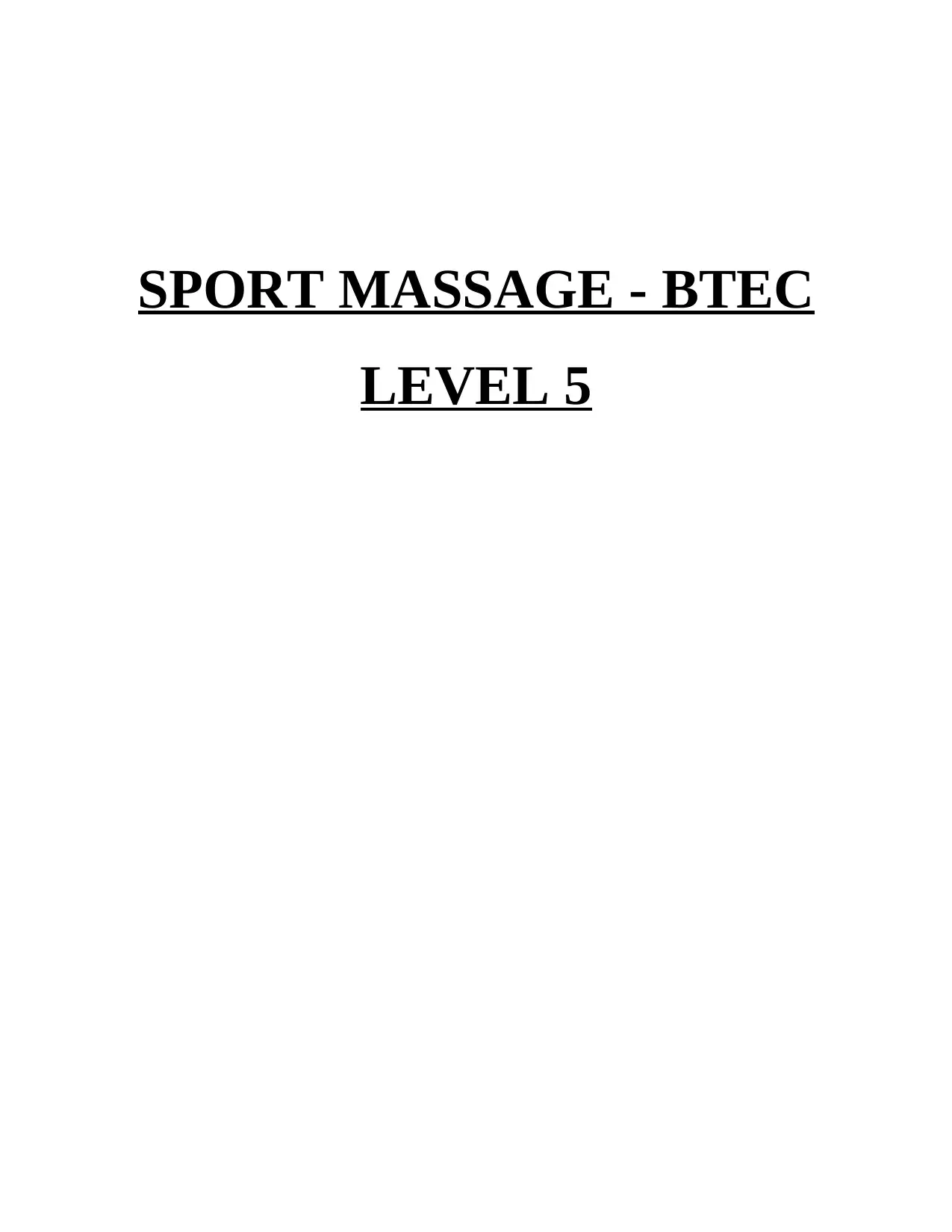
SPORT MASSAGE - BTEC
LEVEL 5
LEVEL 5
Secure Best Marks with AI Grader
Need help grading? Try our AI Grader for instant feedback on your assignments.
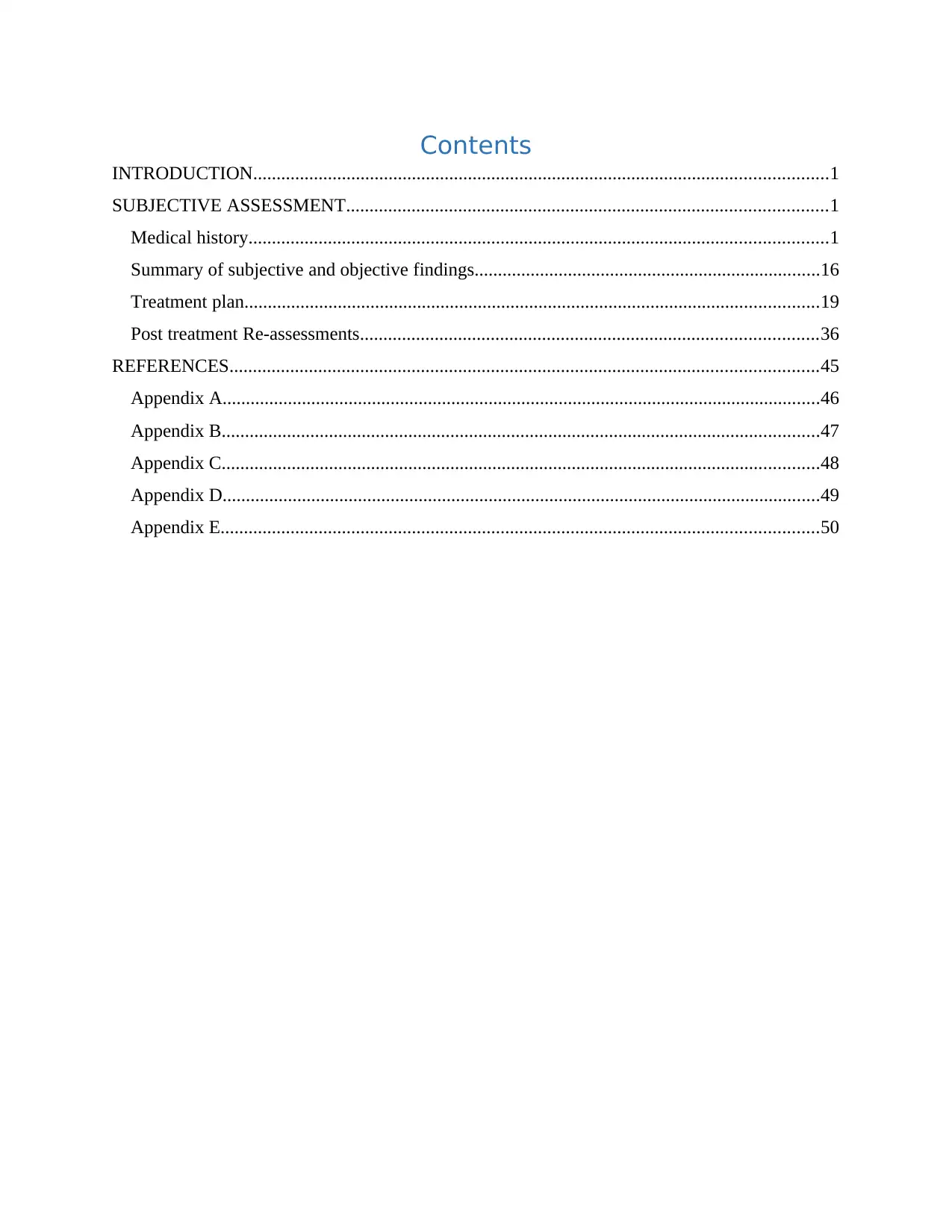
Contents
INTRODUCTION...........................................................................................................................1
SUBJECTIVE ASSESSMENT.......................................................................................................1
Medical history............................................................................................................................1
Summary of subjective and objective findings..........................................................................16
Treatment plan...........................................................................................................................19
Post treatment Re-assessments..................................................................................................36
REFERENCES..............................................................................................................................45
Appendix A................................................................................................................................46
Appendix B................................................................................................................................47
Appendix C................................................................................................................................48
Appendix D................................................................................................................................49
Appendix E................................................................................................................................50
INTRODUCTION...........................................................................................................................1
SUBJECTIVE ASSESSMENT.......................................................................................................1
Medical history............................................................................................................................1
Summary of subjective and objective findings..........................................................................16
Treatment plan...........................................................................................................................19
Post treatment Re-assessments..................................................................................................36
REFERENCES..............................................................................................................................45
Appendix A................................................................................................................................46
Appendix B................................................................................................................................47
Appendix C................................................................................................................................48
Appendix D................................................................................................................................49
Appendix E................................................................................................................................50
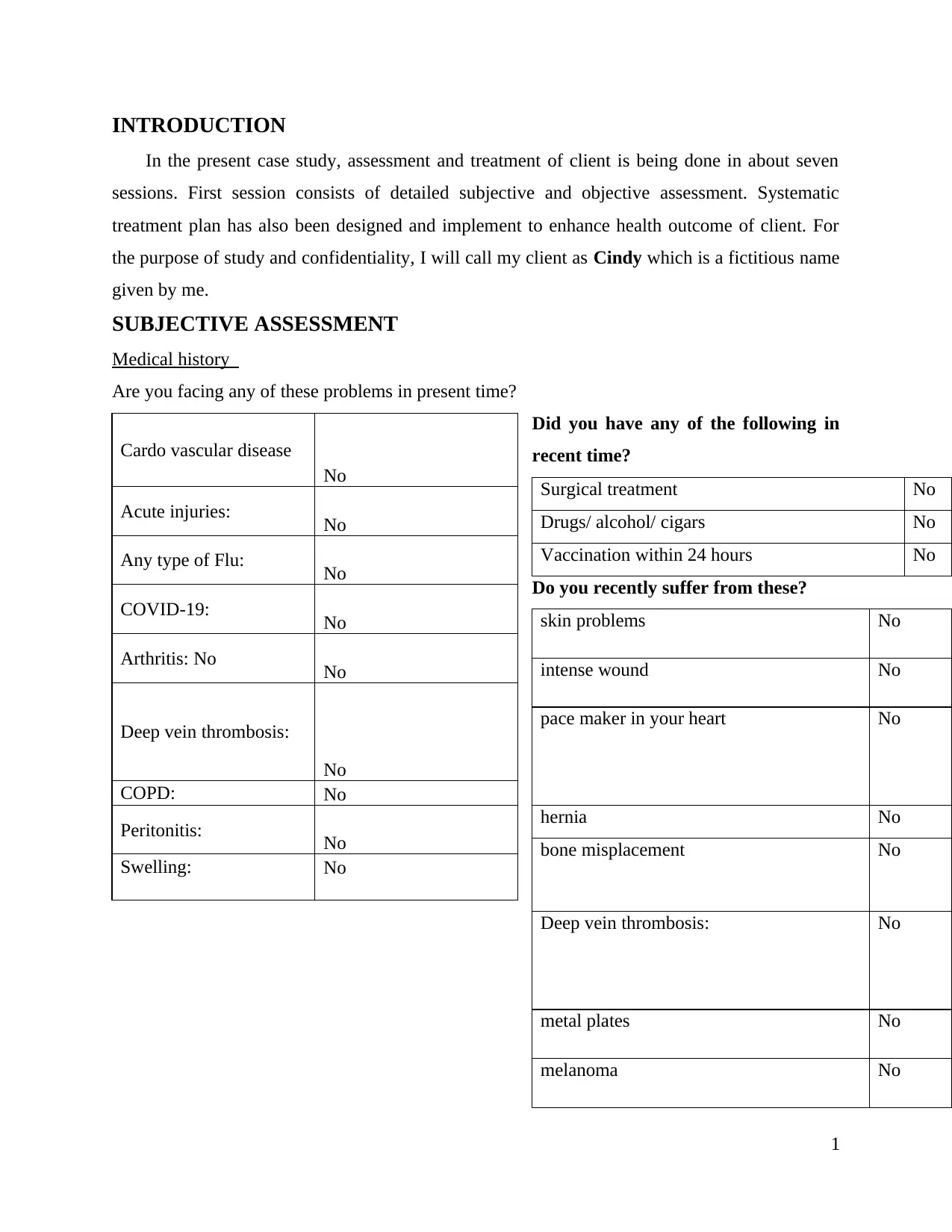
INTRODUCTION
In the present case study, assessment and treatment of client is being done in about seven
sessions. First session consists of detailed subjective and objective assessment. Systematic
treatment plan has also been designed and implement to enhance health outcome of client. For
the purpose of study and confidentiality, I will call my client as Cindy which is a fictitious name
given by me.
SUBJECTIVE ASSESSMENT
Medical history
Are you facing any of these problems in present time?
Did you have any of the following in
recent time?
Surgical treatment No
Drugs/ alcohol/ cigars No
Vaccination within 24 hours No
Do you recently suffer from these?
skin problems No
intense wound No
pace maker in your heart No
hernia No
bone misplacement No
Deep vein thrombosis: No
metal plates No
melanoma No
1
Cardo vascular disease
No
Acute injuries: No
Any type of Flu: No
COVID-19: No
Arthritis: No No
Deep vein thrombosis:
No
COPD: No
Peritonitis: No
Swelling: No
In the present case study, assessment and treatment of client is being done in about seven
sessions. First session consists of detailed subjective and objective assessment. Systematic
treatment plan has also been designed and implement to enhance health outcome of client. For
the purpose of study and confidentiality, I will call my client as Cindy which is a fictitious name
given by me.
SUBJECTIVE ASSESSMENT
Medical history
Are you facing any of these problems in present time?
Did you have any of the following in
recent time?
Surgical treatment No
Drugs/ alcohol/ cigars No
Vaccination within 24 hours No
Do you recently suffer from these?
skin problems No
intense wound No
pace maker in your heart No
hernia No
bone misplacement No
Deep vein thrombosis: No
metal plates No
melanoma No
1
Cardo vascular disease
No
Acute injuries: No
Any type of Flu: No
COVID-19: No
Arthritis: No No
Deep vein thrombosis:
No
COPD: No
Peritonitis: No
Swelling: No
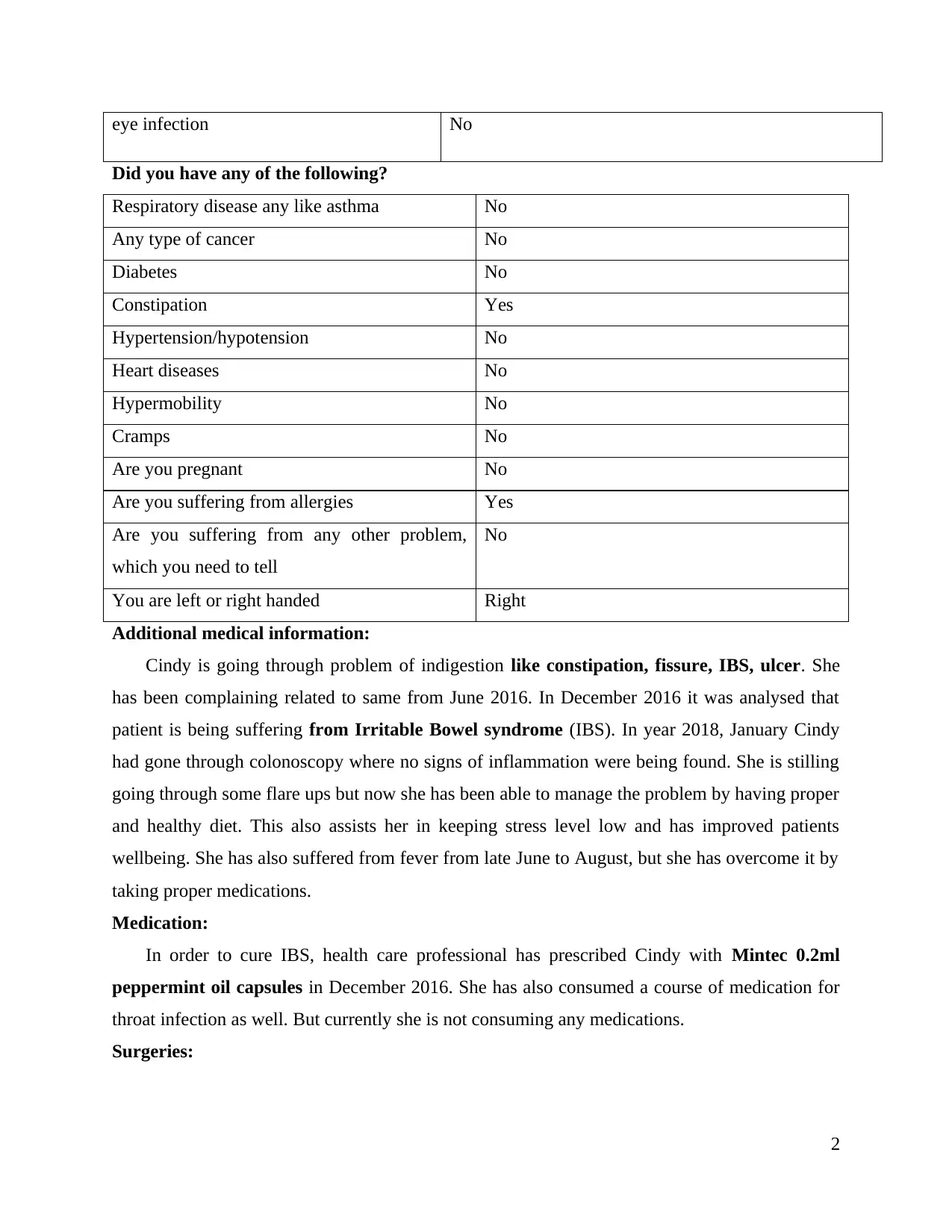
eye infection No
Did you have any of the following?
Respiratory disease any like asthma No
Any type of cancer No
Diabetes No
Constipation Yes
Hypertension/hypotension No
Heart diseases No
Hypermobility No
Cramps No
Are you pregnant No
Are you suffering from allergies Yes
Are you suffering from any other problem,
which you need to tell
No
You are left or right handed Right
Additional medical information:
Cindy is going through problem of indigestion like constipation, fissure, IBS, ulcer. She
has been complaining related to same from June 2016. In December 2016 it was analysed that
patient is being suffering from Irritable Bowel syndrome (IBS). In year 2018, January Cindy
had gone through colonoscopy where no signs of inflammation were being found. She is stilling
going through some flare ups but now she has been able to manage the problem by having proper
and healthy diet. This also assists her in keeping stress level low and has improved patients
wellbeing. She has also suffered from fever from late June to August, but she has overcome it by
taking proper medications.
Medication:
In order to cure IBS, health care professional has prescribed Cindy with Mintec 0.2ml
peppermint oil capsules in December 2016. She has also consumed a course of medication for
throat infection as well. But currently she is not consuming any medications.
Surgeries:
2
Did you have any of the following?
Respiratory disease any like asthma No
Any type of cancer No
Diabetes No
Constipation Yes
Hypertension/hypotension No
Heart diseases No
Hypermobility No
Cramps No
Are you pregnant No
Are you suffering from allergies Yes
Are you suffering from any other problem,
which you need to tell
No
You are left or right handed Right
Additional medical information:
Cindy is going through problem of indigestion like constipation, fissure, IBS, ulcer. She
has been complaining related to same from June 2016. In December 2016 it was analysed that
patient is being suffering from Irritable Bowel syndrome (IBS). In year 2018, January Cindy
had gone through colonoscopy where no signs of inflammation were being found. She is stilling
going through some flare ups but now she has been able to manage the problem by having proper
and healthy diet. This also assists her in keeping stress level low and has improved patients
wellbeing. She has also suffered from fever from late June to August, but she has overcome it by
taking proper medications.
Medication:
In order to cure IBS, health care professional has prescribed Cindy with Mintec 0.2ml
peppermint oil capsules in December 2016. She has also consumed a course of medication for
throat infection as well. But currently she is not consuming any medications.
Surgeries:
2
Secure Best Marks with AI Grader
Need help grading? Try our AI Grader for instant feedback on your assignments.

She has colonoscopy in January 2018, other than that she has not gone through any surgery
or even minor operations.
Past injuries:
In June, 2016 Cindy slipped from stairs on her left wrist and in next morning she was
suffering from pain and wrist got swollen. Cindy then thought of having test. A&E test was
asked to do by health care professionals. She was diagnosed with a sprain and was also
suggested the RICE procedure. She was asked to take pain killers. It was analysed that after one
week Cindy has no pain or swelling. She was also not facing any mobility issues. It was also
being evaluated that Cindy in future has also not faced any type of muscle, tendon, ligament or
bone injuries and also no further injury was faced by her.
Occupation:
Cindy is working as a manager in international organisation. She spends about 9 hours
per day in office. All day she does work on laptop by sitting on her desk. Her work space is quiet
well and she tends to keep working in free space within the office. Sometimes she also works
from sofa and on lounge tables. Cindy also takes work from home but only for one day in a
week. In home she works from dining table. She attends lots of conference calls and meetings,
because of which she has to use her cell phone for about 80 minutes. In order to reach office, she
has to take trains. Cindy walks for around sixty minute and she has to stand in a queue on her
way to office for around fifteen minutes. She also carries her bag on right shoulder so that her
personal belonging can be kept safe.
Exercise routine:
Cindy has joined gym in past but her membership expired in November 2018 and also she
decided not renew it. Before this, Cindy attended gym regularly and she was really active. Her
gym session last for an hour, she does take rest at weekends. Cindy used various cardiovascular
equipment and carried free weight. However, in past ten months other than walking Cindy is not
engaged in any type of training or exercise.
Physical activity:
Cindy has various which are listed below, other than this she does not take part in any
form of physical exercise.
Hobby:
3
or even minor operations.
Past injuries:
In June, 2016 Cindy slipped from stairs on her left wrist and in next morning she was
suffering from pain and wrist got swollen. Cindy then thought of having test. A&E test was
asked to do by health care professionals. She was diagnosed with a sprain and was also
suggested the RICE procedure. She was asked to take pain killers. It was analysed that after one
week Cindy has no pain or swelling. She was also not facing any mobility issues. It was also
being evaluated that Cindy in future has also not faced any type of muscle, tendon, ligament or
bone injuries and also no further injury was faced by her.
Occupation:
Cindy is working as a manager in international organisation. She spends about 9 hours
per day in office. All day she does work on laptop by sitting on her desk. Her work space is quiet
well and she tends to keep working in free space within the office. Sometimes she also works
from sofa and on lounge tables. Cindy also takes work from home but only for one day in a
week. In home she works from dining table. She attends lots of conference calls and meetings,
because of which she has to use her cell phone for about 80 minutes. In order to reach office, she
has to take trains. Cindy walks for around sixty minute and she has to stand in a queue on her
way to office for around fifteen minutes. She also carries her bag on right shoulder so that her
personal belonging can be kept safe.
Exercise routine:
Cindy has joined gym in past but her membership expired in November 2018 and also she
decided not renew it. Before this, Cindy attended gym regularly and she was really active. Her
gym session last for an hour, she does take rest at weekends. Cindy used various cardiovascular
equipment and carried free weight. However, in past ten months other than walking Cindy is not
engaged in any type of training or exercise.
Physical activity:
Cindy has various which are listed below, other than this she does not take part in any
form of physical exercise.
Hobby:
3
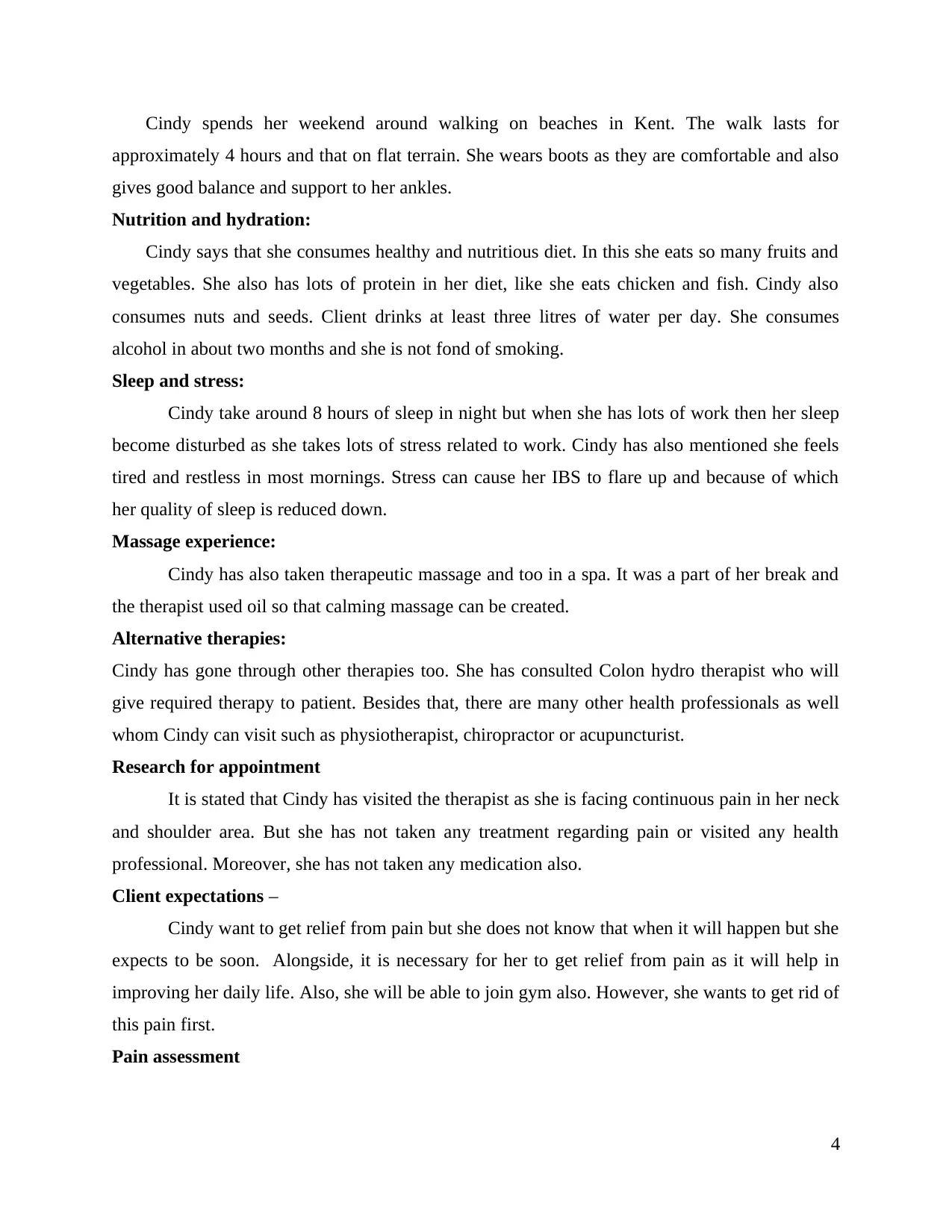
Cindy spends her weekend around walking on beaches in Kent. The walk lasts for
approximately 4 hours and that on flat terrain. She wears boots as they are comfortable and also
gives good balance and support to her ankles.
Nutrition and hydration:
Cindy says that she consumes healthy and nutritious diet. In this she eats so many fruits and
vegetables. She also has lots of protein in her diet, like she eats chicken and fish. Cindy also
consumes nuts and seeds. Client drinks at least three litres of water per day. She consumes
alcohol in about two months and she is not fond of smoking.
Sleep and stress:
Cindy take around 8 hours of sleep in night but when she has lots of work then her sleep
become disturbed as she takes lots of stress related to work. Cindy has also mentioned she feels
tired and restless in most mornings. Stress can cause her IBS to flare up and because of which
her quality of sleep is reduced down.
Massage experience:
Cindy has also taken therapeutic massage and too in a spa. It was a part of her break and
the therapist used oil so that calming massage can be created.
Alternative therapies:
Cindy has gone through other therapies too. She has consulted Colon hydro therapist who will
give required therapy to patient. Besides that, there are many other health professionals as well
whom Cindy can visit such as physiotherapist, chiropractor or acupuncturist.
Research for appointment
It is stated that Cindy has visited the therapist as she is facing continuous pain in her neck
and shoulder area. But she has not taken any treatment regarding pain or visited any health
professional. Moreover, she has not taken any medication also.
Client expectations –
Cindy want to get relief from pain but she does not know that when it will happen but she
expects to be soon. Alongside, it is necessary for her to get relief from pain as it will help in
improving her daily life. Also, she will be able to join gym also. However, she wants to get rid of
this pain first.
Pain assessment
4
approximately 4 hours and that on flat terrain. She wears boots as they are comfortable and also
gives good balance and support to her ankles.
Nutrition and hydration:
Cindy says that she consumes healthy and nutritious diet. In this she eats so many fruits and
vegetables. She also has lots of protein in her diet, like she eats chicken and fish. Cindy also
consumes nuts and seeds. Client drinks at least three litres of water per day. She consumes
alcohol in about two months and she is not fond of smoking.
Sleep and stress:
Cindy take around 8 hours of sleep in night but when she has lots of work then her sleep
become disturbed as she takes lots of stress related to work. Cindy has also mentioned she feels
tired and restless in most mornings. Stress can cause her IBS to flare up and because of which
her quality of sleep is reduced down.
Massage experience:
Cindy has also taken therapeutic massage and too in a spa. It was a part of her break and
the therapist used oil so that calming massage can be created.
Alternative therapies:
Cindy has gone through other therapies too. She has consulted Colon hydro therapist who will
give required therapy to patient. Besides that, there are many other health professionals as well
whom Cindy can visit such as physiotherapist, chiropractor or acupuncturist.
Research for appointment
It is stated that Cindy has visited the therapist as she is facing continuous pain in her neck
and shoulder area. But she has not taken any treatment regarding pain or visited any health
professional. Moreover, she has not taken any medication also.
Client expectations –
Cindy want to get relief from pain but she does not know that when it will happen but she
expects to be soon. Alongside, it is necessary for her to get relief from pain as it will help in
improving her daily life. Also, she will be able to join gym also. However, she wants to get rid of
this pain first.
Pain assessment
4
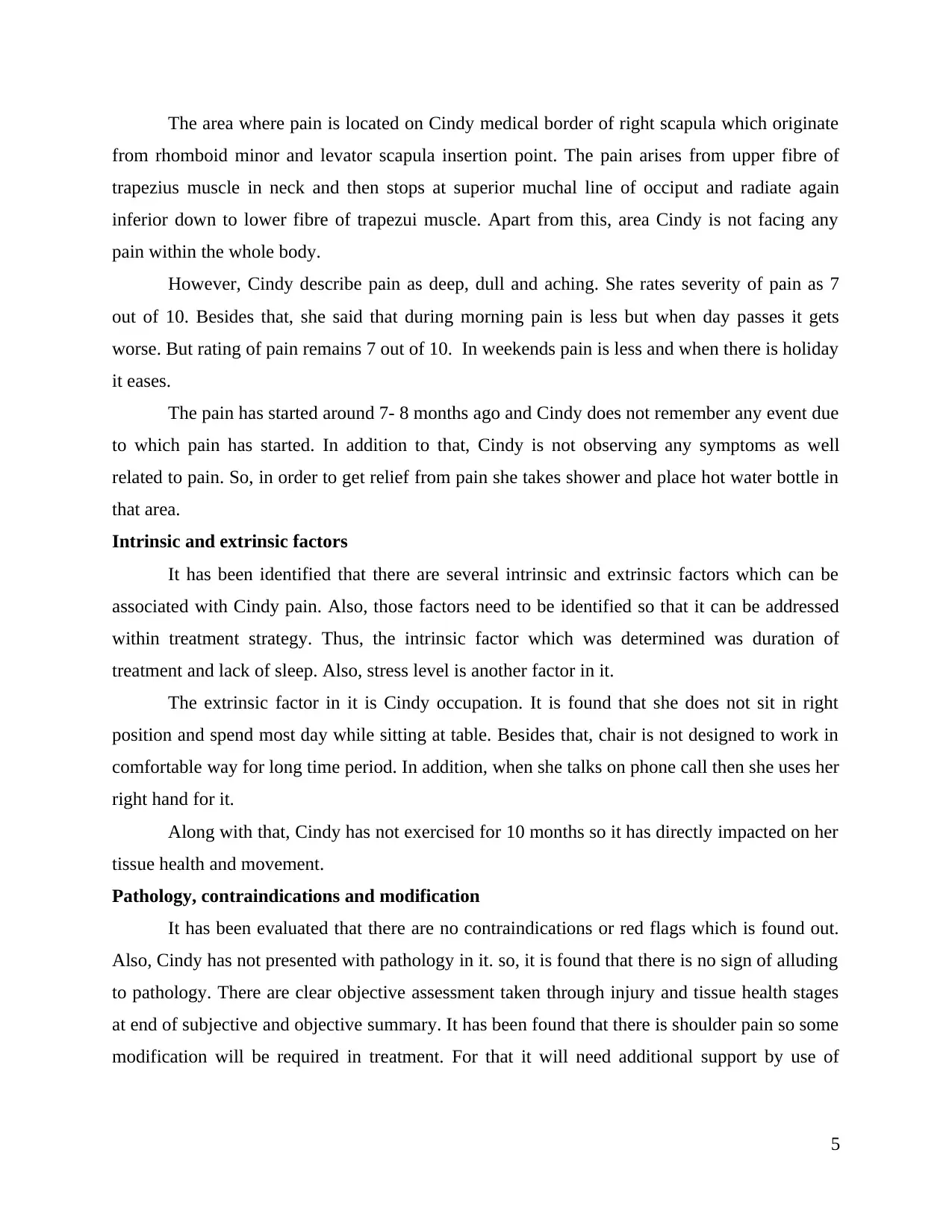
The area where pain is located on Cindy medical border of right scapula which originate
from rhomboid minor and levator scapula insertion point. The pain arises from upper fibre of
trapezius muscle in neck and then stops at superior muchal line of occiput and radiate again
inferior down to lower fibre of trapezui muscle. Apart from this, area Cindy is not facing any
pain within the whole body.
However, Cindy describe pain as deep, dull and aching. She rates severity of pain as 7
out of 10. Besides that, she said that during morning pain is less but when day passes it gets
worse. But rating of pain remains 7 out of 10. In weekends pain is less and when there is holiday
it eases.
The pain has started around 7- 8 months ago and Cindy does not remember any event due
to which pain has started. In addition to that, Cindy is not observing any symptoms as well
related to pain. So, in order to get relief from pain she takes shower and place hot water bottle in
that area.
Intrinsic and extrinsic factors
It has been identified that there are several intrinsic and extrinsic factors which can be
associated with Cindy pain. Also, those factors need to be identified so that it can be addressed
within treatment strategy. Thus, the intrinsic factor which was determined was duration of
treatment and lack of sleep. Also, stress level is another factor in it.
The extrinsic factor in it is Cindy occupation. It is found that she does not sit in right
position and spend most day while sitting at table. Besides that, chair is not designed to work in
comfortable way for long time period. In addition, when she talks on phone call then she uses her
right hand for it.
Along with that, Cindy has not exercised for 10 months so it has directly impacted on her
tissue health and movement.
Pathology, contraindications and modification
It has been evaluated that there are no contraindications or red flags which is found out.
Also, Cindy has not presented with pathology in it. so, it is found that there is no sign of alluding
to pathology. There are clear objective assessment taken through injury and tissue health stages
at end of subjective and objective summary. It has been found that there is shoulder pain so some
modification will be required in treatment. For that it will need additional support by use of
5
from rhomboid minor and levator scapula insertion point. The pain arises from upper fibre of
trapezius muscle in neck and then stops at superior muchal line of occiput and radiate again
inferior down to lower fibre of trapezui muscle. Apart from this, area Cindy is not facing any
pain within the whole body.
However, Cindy describe pain as deep, dull and aching. She rates severity of pain as 7
out of 10. Besides that, she said that during morning pain is less but when day passes it gets
worse. But rating of pain remains 7 out of 10. In weekends pain is less and when there is holiday
it eases.
The pain has started around 7- 8 months ago and Cindy does not remember any event due
to which pain has started. In addition to that, Cindy is not observing any symptoms as well
related to pain. So, in order to get relief from pain she takes shower and place hot water bottle in
that area.
Intrinsic and extrinsic factors
It has been identified that there are several intrinsic and extrinsic factors which can be
associated with Cindy pain. Also, those factors need to be identified so that it can be addressed
within treatment strategy. Thus, the intrinsic factor which was determined was duration of
treatment and lack of sleep. Also, stress level is another factor in it.
The extrinsic factor in it is Cindy occupation. It is found that she does not sit in right
position and spend most day while sitting at table. Besides that, chair is not designed to work in
comfortable way for long time period. In addition, when she talks on phone call then she uses her
right hand for it.
Along with that, Cindy has not exercised for 10 months so it has directly impacted on her
tissue health and movement.
Pathology, contraindications and modification
It has been evaluated that there are no contraindications or red flags which is found out.
Also, Cindy has not presented with pathology in it. so, it is found that there is no sign of alluding
to pathology. There are clear objective assessment taken through injury and tissue health stages
at end of subjective and objective summary. It has been found that there is shoulder pain so some
modification will be required in treatment. For that it will need additional support by use of
5
Paraphrase This Document
Need a fresh take? Get an instant paraphrase of this document with our AI Paraphraser
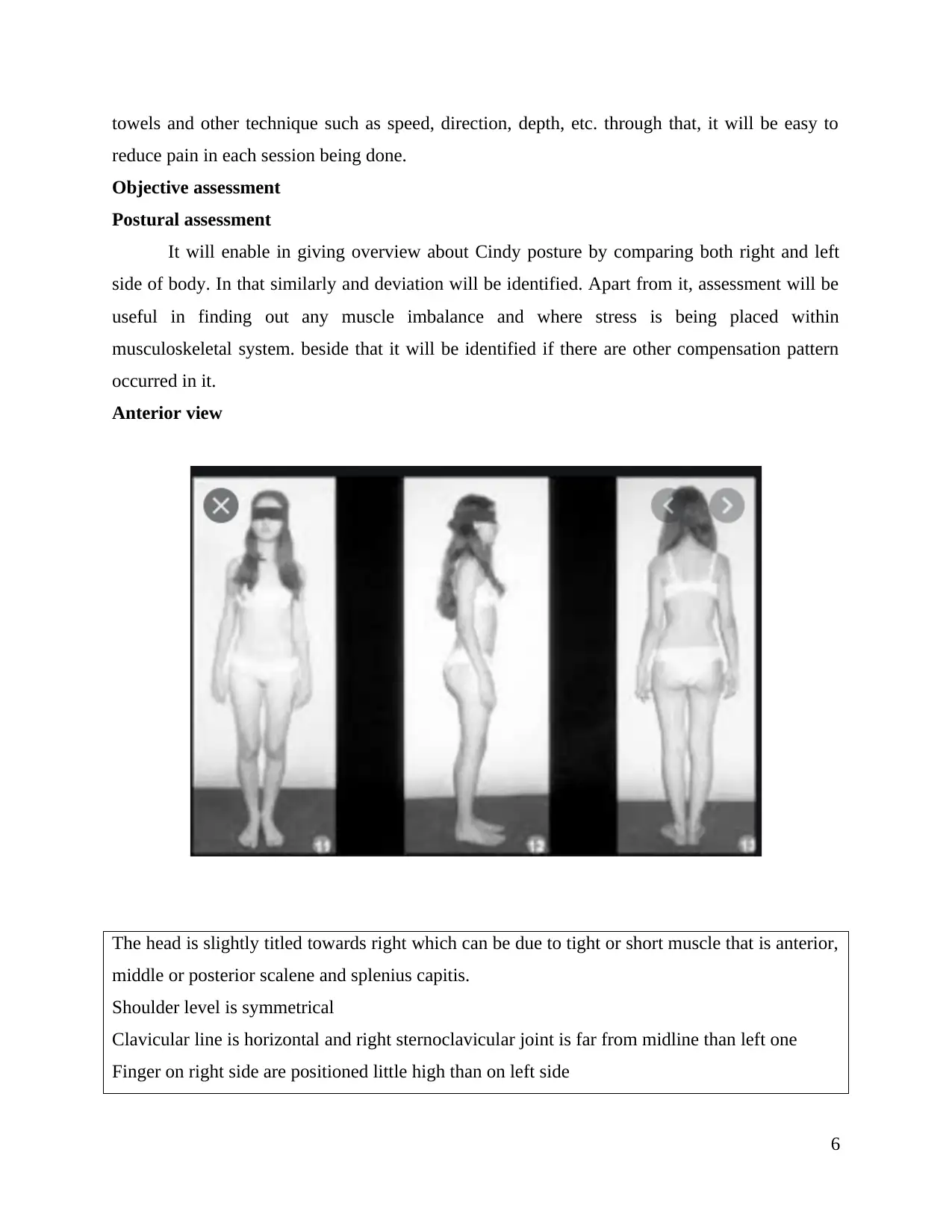
towels and other technique such as speed, direction, depth, etc. through that, it will be easy to
reduce pain in each session being done.
Objective assessment
Postural assessment
It will enable in giving overview about Cindy posture by comparing both right and left
side of body. In that similarly and deviation will be identified. Apart from it, assessment will be
useful in finding out any muscle imbalance and where stress is being placed within
musculoskeletal system. beside that it will be identified if there are other compensation pattern
occurred in it.
Anterior view
The head is slightly titled towards right which can be due to tight or short muscle that is anterior,
middle or posterior scalene and splenius capitis.
Shoulder level is symmetrical
Clavicular line is horizontal and right sternoclavicular joint is far from midline than left one
Finger on right side are positioned little high than on left side
6
reduce pain in each session being done.
Objective assessment
Postural assessment
It will enable in giving overview about Cindy posture by comparing both right and left
side of body. In that similarly and deviation will be identified. Apart from it, assessment will be
useful in finding out any muscle imbalance and where stress is being placed within
musculoskeletal system. beside that it will be identified if there are other compensation pattern
occurred in it.
Anterior view
The head is slightly titled towards right which can be due to tight or short muscle that is anterior,
middle or posterior scalene and splenius capitis.
Shoulder level is symmetrical
Clavicular line is horizontal and right sternoclavicular joint is far from midline than left one
Finger on right side are positioned little high than on left side
6
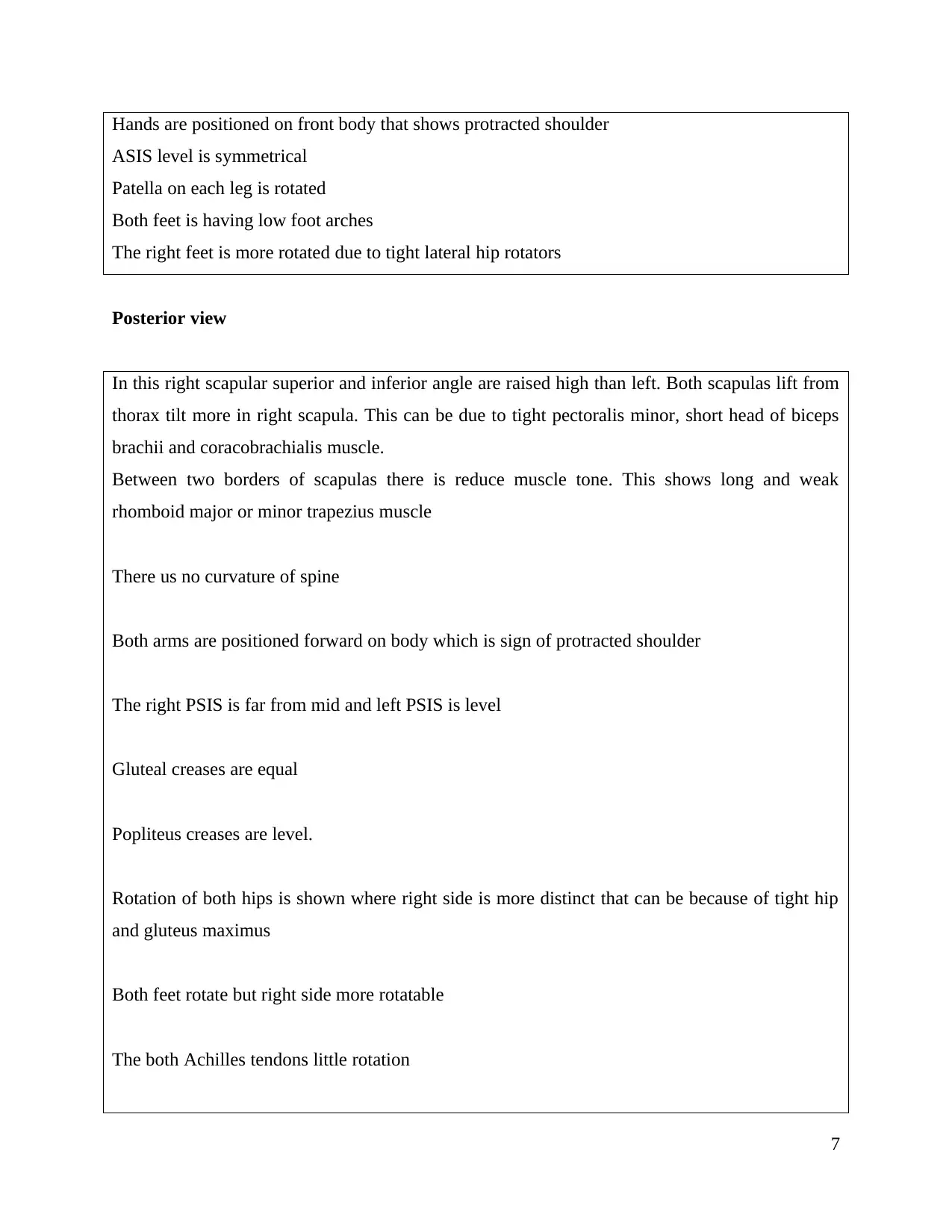
Hands are positioned on front body that shows protracted shoulder
ASIS level is symmetrical
Patella on each leg is rotated
Both feet is having low foot arches
The right feet is more rotated due to tight lateral hip rotators
Posterior view
In this right scapular superior and inferior angle are raised high than left. Both scapulas lift from
thorax tilt more in right scapula. This can be due to tight pectoralis minor, short head of biceps
brachii and coracobrachialis muscle.
Between two borders of scapulas there is reduce muscle tone. This shows long and weak
rhomboid major or minor trapezius muscle
There us no curvature of spine
Both arms are positioned forward on body which is sign of protracted shoulder
The right PSIS is far from mid and left PSIS is level
Gluteal creases are equal
Popliteus creases are level.
Rotation of both hips is shown where right side is more distinct that can be because of tight hip
and gluteus maximus
Both feet rotate but right side more rotatable
The both Achilles tendons little rotation
7
ASIS level is symmetrical
Patella on each leg is rotated
Both feet is having low foot arches
The right feet is more rotated due to tight lateral hip rotators
Posterior view
In this right scapular superior and inferior angle are raised high than left. Both scapulas lift from
thorax tilt more in right scapula. This can be due to tight pectoralis minor, short head of biceps
brachii and coracobrachialis muscle.
Between two borders of scapulas there is reduce muscle tone. This shows long and weak
rhomboid major or minor trapezius muscle
There us no curvature of spine
Both arms are positioned forward on body which is sign of protracted shoulder
The right PSIS is far from mid and left PSIS is level
Gluteal creases are equal
Popliteus creases are level.
Rotation of both hips is shown where right side is more distinct that can be because of tight hip
and gluteus maximus
Both feet rotate but right side more rotatable
The both Achilles tendons little rotation
7
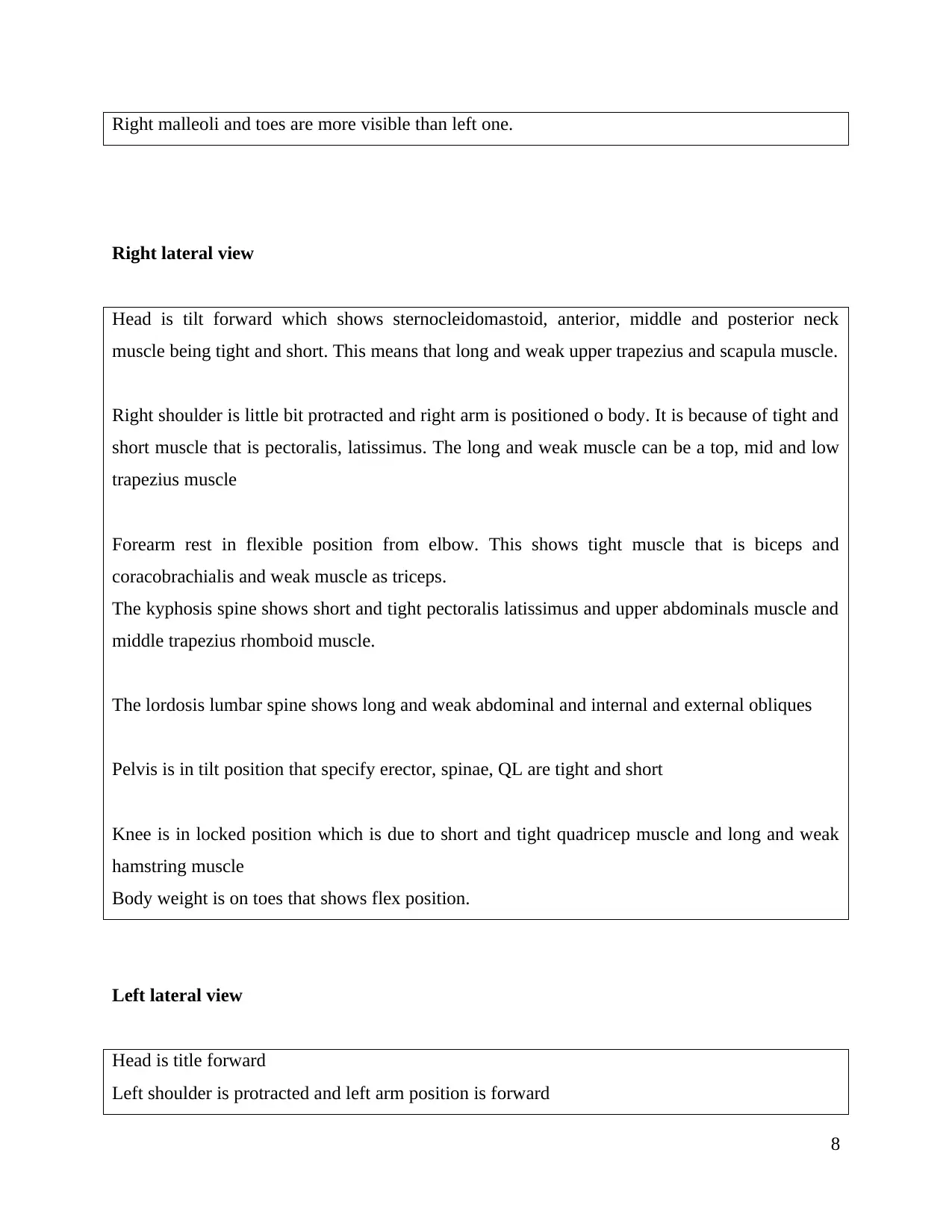
Right malleoli and toes are more visible than left one.
Right lateral view
Head is tilt forward which shows sternocleidomastoid, anterior, middle and posterior neck
muscle being tight and short. This means that long and weak upper trapezius and scapula muscle.
Right shoulder is little bit protracted and right arm is positioned o body. It is because of tight and
short muscle that is pectoralis, latissimus. The long and weak muscle can be a top, mid and low
trapezius muscle
Forearm rest in flexible position from elbow. This shows tight muscle that is biceps and
coracobrachialis and weak muscle as triceps.
The kyphosis spine shows short and tight pectoralis latissimus and upper abdominals muscle and
middle trapezius rhomboid muscle.
The lordosis lumbar spine shows long and weak abdominal and internal and external obliques
Pelvis is in tilt position that specify erector, spinae, QL are tight and short
Knee is in locked position which is due to short and tight quadricep muscle and long and weak
hamstring muscle
Body weight is on toes that shows flex position.
Left lateral view
Head is title forward
Left shoulder is protracted and left arm position is forward
8
Right lateral view
Head is tilt forward which shows sternocleidomastoid, anterior, middle and posterior neck
muscle being tight and short. This means that long and weak upper trapezius and scapula muscle.
Right shoulder is little bit protracted and right arm is positioned o body. It is because of tight and
short muscle that is pectoralis, latissimus. The long and weak muscle can be a top, mid and low
trapezius muscle
Forearm rest in flexible position from elbow. This shows tight muscle that is biceps and
coracobrachialis and weak muscle as triceps.
The kyphosis spine shows short and tight pectoralis latissimus and upper abdominals muscle and
middle trapezius rhomboid muscle.
The lordosis lumbar spine shows long and weak abdominal and internal and external obliques
Pelvis is in tilt position that specify erector, spinae, QL are tight and short
Knee is in locked position which is due to short and tight quadricep muscle and long and weak
hamstring muscle
Body weight is on toes that shows flex position.
Left lateral view
Head is title forward
Left shoulder is protracted and left arm position is forward
8
Secure Best Marks with AI Grader
Need help grading? Try our AI Grader for instant feedback on your assignments.
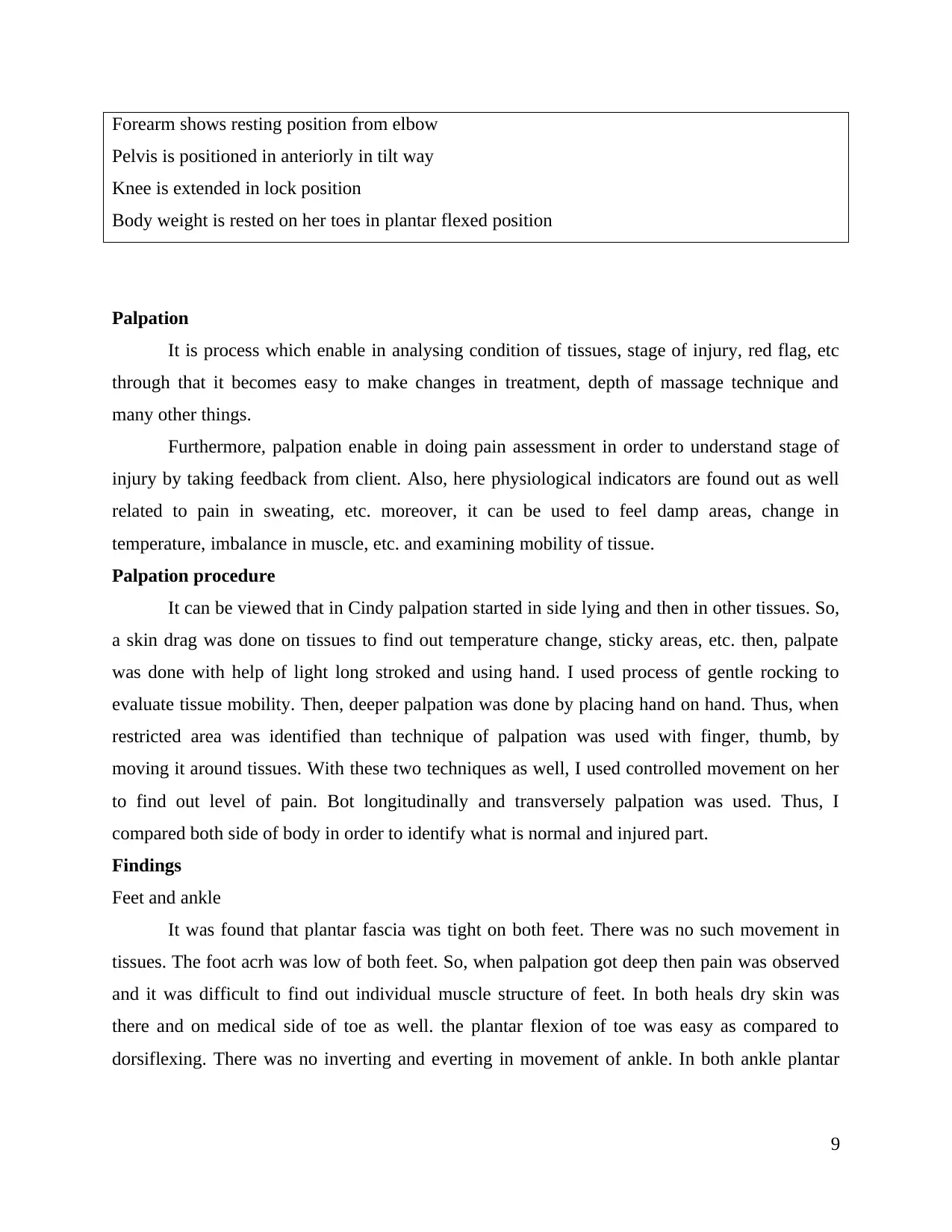
Forearm shows resting position from elbow
Pelvis is positioned in anteriorly in tilt way
Knee is extended in lock position
Body weight is rested on her toes in plantar flexed position
Palpation
It is process which enable in analysing condition of tissues, stage of injury, red flag, etc
through that it becomes easy to make changes in treatment, depth of massage technique and
many other things.
Furthermore, palpation enable in doing pain assessment in order to understand stage of
injury by taking feedback from client. Also, here physiological indicators are found out as well
related to pain in sweating, etc. moreover, it can be used to feel damp areas, change in
temperature, imbalance in muscle, etc. and examining mobility of tissue.
Palpation procedure
It can be viewed that in Cindy palpation started in side lying and then in other tissues. So,
a skin drag was done on tissues to find out temperature change, sticky areas, etc. then, palpate
was done with help of light long stroked and using hand. I used process of gentle rocking to
evaluate tissue mobility. Then, deeper palpation was done by placing hand on hand. Thus, when
restricted area was identified than technique of palpation was used with finger, thumb, by
moving it around tissues. With these two techniques as well, I used controlled movement on her
to find out level of pain. Bot longitudinally and transversely palpation was used. Thus, I
compared both side of body in order to identify what is normal and injured part.
Findings
Feet and ankle
It was found that plantar fascia was tight on both feet. There was no such movement in
tissues. The foot acrh was low of both feet. So, when palpation got deep then pain was observed
and it was difficult to find out individual muscle structure of feet. In both heals dry skin was
there and on medical side of toe as well. the plantar flexion of toe was easy as compared to
dorsiflexing. There was no inverting and everting in movement of ankle. In both ankle plantar
9
Pelvis is positioned in anteriorly in tilt way
Knee is extended in lock position
Body weight is rested on her toes in plantar flexed position
Palpation
It is process which enable in analysing condition of tissues, stage of injury, red flag, etc
through that it becomes easy to make changes in treatment, depth of massage technique and
many other things.
Furthermore, palpation enable in doing pain assessment in order to understand stage of
injury by taking feedback from client. Also, here physiological indicators are found out as well
related to pain in sweating, etc. moreover, it can be used to feel damp areas, change in
temperature, imbalance in muscle, etc. and examining mobility of tissue.
Palpation procedure
It can be viewed that in Cindy palpation started in side lying and then in other tissues. So,
a skin drag was done on tissues to find out temperature change, sticky areas, etc. then, palpate
was done with help of light long stroked and using hand. I used process of gentle rocking to
evaluate tissue mobility. Then, deeper palpation was done by placing hand on hand. Thus, when
restricted area was identified than technique of palpation was used with finger, thumb, by
moving it around tissues. With these two techniques as well, I used controlled movement on her
to find out level of pain. Bot longitudinally and transversely palpation was used. Thus, I
compared both side of body in order to identify what is normal and injured part.
Findings
Feet and ankle
It was found that plantar fascia was tight on both feet. There was no such movement in
tissues. The foot acrh was low of both feet. So, when palpation got deep then pain was observed
and it was difficult to find out individual muscle structure of feet. In both heals dry skin was
there and on medical side of toe as well. the plantar flexion of toe was easy as compared to
dorsiflexing. There was no inverting and everting in movement of ankle. In both ankle plantar
9
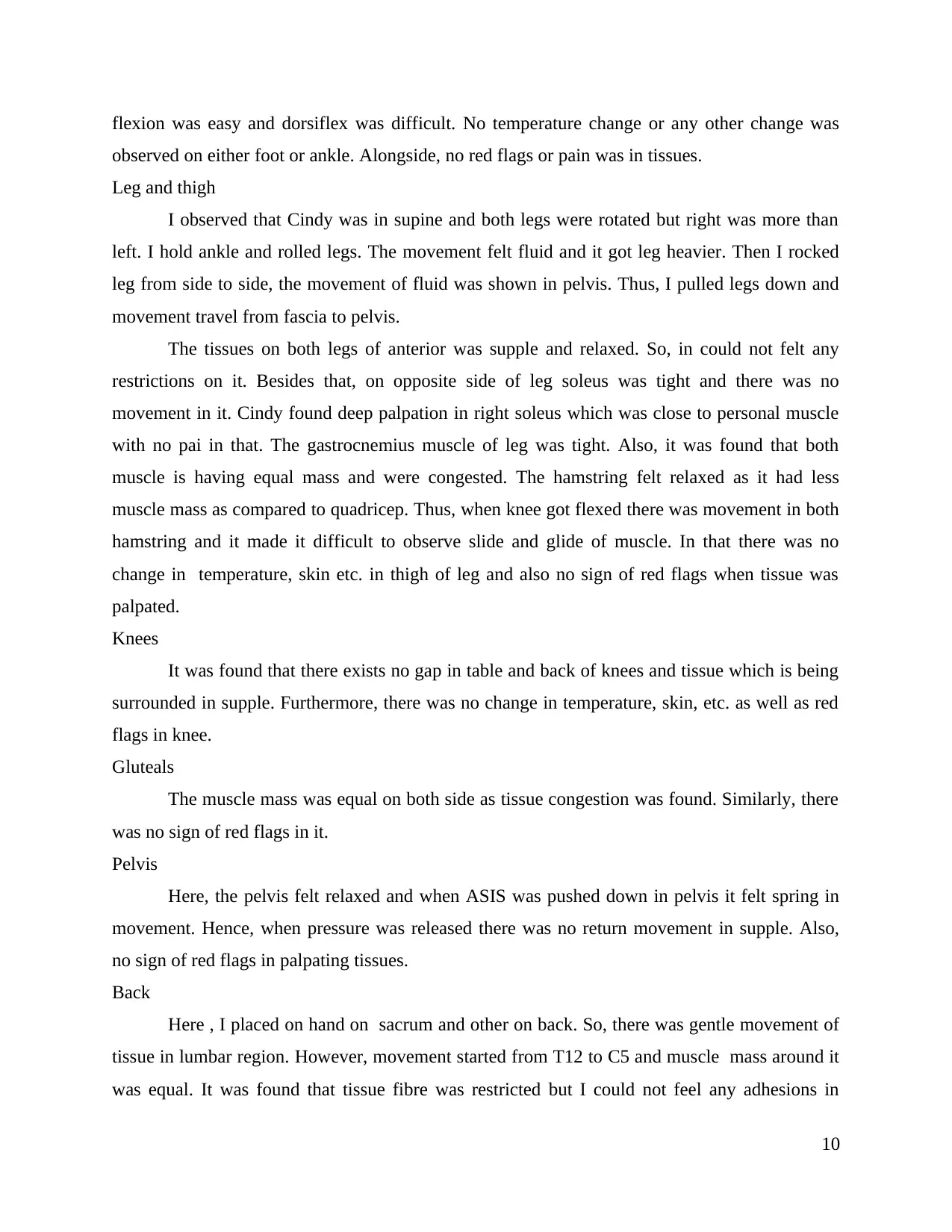
flexion was easy and dorsiflex was difficult. No temperature change or any other change was
observed on either foot or ankle. Alongside, no red flags or pain was in tissues.
Leg and thigh
I observed that Cindy was in supine and both legs were rotated but right was more than
left. I hold ankle and rolled legs. The movement felt fluid and it got leg heavier. Then I rocked
leg from side to side, the movement of fluid was shown in pelvis. Thus, I pulled legs down and
movement travel from fascia to pelvis.
The tissues on both legs of anterior was supple and relaxed. So, in could not felt any
restrictions on it. Besides that, on opposite side of leg soleus was tight and there was no
movement in it. Cindy found deep palpation in right soleus which was close to personal muscle
with no pai in that. The gastrocnemius muscle of leg was tight. Also, it was found that both
muscle is having equal mass and were congested. The hamstring felt relaxed as it had less
muscle mass as compared to quadricep. Thus, when knee got flexed there was movement in both
hamstring and it made it difficult to observe slide and glide of muscle. In that there was no
change in temperature, skin etc. in thigh of leg and also no sign of red flags when tissue was
palpated.
Knees
It was found that there exists no gap in table and back of knees and tissue which is being
surrounded in supple. Furthermore, there was no change in temperature, skin, etc. as well as red
flags in knee.
Gluteals
The muscle mass was equal on both side as tissue congestion was found. Similarly, there
was no sign of red flags in it.
Pelvis
Here, the pelvis felt relaxed and when ASIS was pushed down in pelvis it felt spring in
movement. Hence, when pressure was released there was no return movement in supple. Also,
no sign of red flags in palpating tissues.
Back
Here , I placed on hand on sacrum and other on back. So, there was gentle movement of
tissue in lumbar region. However, movement started from T12 to C5 and muscle mass around it
was equal. It was found that tissue fibre was restricted but I could not feel any adhesions in
10
observed on either foot or ankle. Alongside, no red flags or pain was in tissues.
Leg and thigh
I observed that Cindy was in supine and both legs were rotated but right was more than
left. I hold ankle and rolled legs. The movement felt fluid and it got leg heavier. Then I rocked
leg from side to side, the movement of fluid was shown in pelvis. Thus, I pulled legs down and
movement travel from fascia to pelvis.
The tissues on both legs of anterior was supple and relaxed. So, in could not felt any
restrictions on it. Besides that, on opposite side of leg soleus was tight and there was no
movement in it. Cindy found deep palpation in right soleus which was close to personal muscle
with no pai in that. The gastrocnemius muscle of leg was tight. Also, it was found that both
muscle is having equal mass and were congested. The hamstring felt relaxed as it had less
muscle mass as compared to quadricep. Thus, when knee got flexed there was movement in both
hamstring and it made it difficult to observe slide and glide of muscle. In that there was no
change in temperature, skin etc. in thigh of leg and also no sign of red flags when tissue was
palpated.
Knees
It was found that there exists no gap in table and back of knees and tissue which is being
surrounded in supple. Furthermore, there was no change in temperature, skin, etc. as well as red
flags in knee.
Gluteals
The muscle mass was equal on both side as tissue congestion was found. Similarly, there
was no sign of red flags in it.
Pelvis
Here, the pelvis felt relaxed and when ASIS was pushed down in pelvis it felt spring in
movement. Hence, when pressure was released there was no return movement in supple. Also,
no sign of red flags in palpating tissues.
Back
Here , I placed on hand on sacrum and other on back. So, there was gentle movement of
tissue in lumbar region. However, movement started from T12 to C5 and muscle mass around it
was equal. It was found that tissue fibre was restricted but I could not feel any adhesions in
10
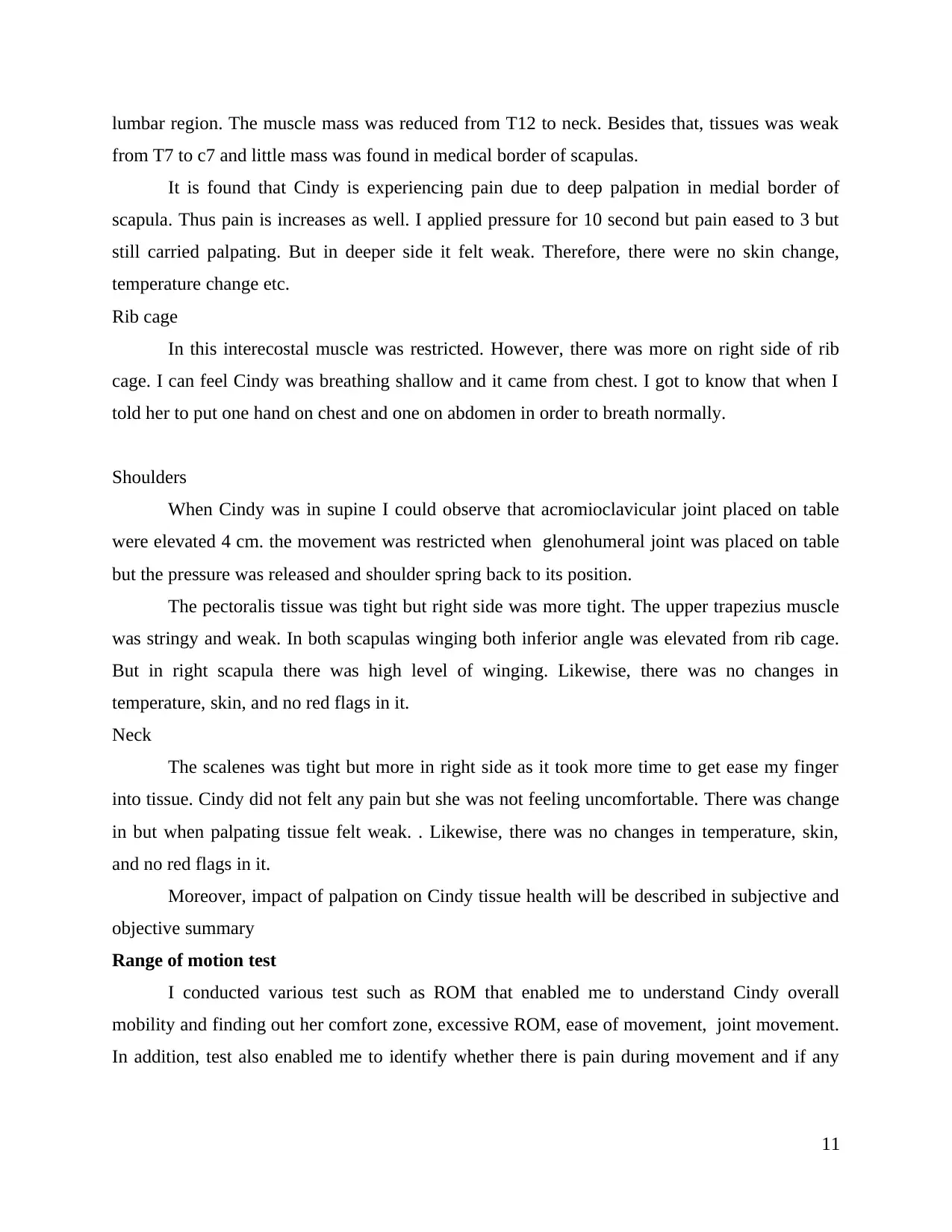
lumbar region. The muscle mass was reduced from T12 to neck. Besides that, tissues was weak
from T7 to c7 and little mass was found in medical border of scapulas.
It is found that Cindy is experiencing pain due to deep palpation in medial border of
scapula. Thus pain is increases as well. I applied pressure for 10 second but pain eased to 3 but
still carried palpating. But in deeper side it felt weak. Therefore, there were no skin change,
temperature change etc.
Rib cage
In this interecostal muscle was restricted. However, there was more on right side of rib
cage. I can feel Cindy was breathing shallow and it came from chest. I got to know that when I
told her to put one hand on chest and one on abdomen in order to breath normally.
Shoulders
When Cindy was in supine I could observe that acromioclavicular joint placed on table
were elevated 4 cm. the movement was restricted when glenohumeral joint was placed on table
but the pressure was released and shoulder spring back to its position.
The pectoralis tissue was tight but right side was more tight. The upper trapezius muscle
was stringy and weak. In both scapulas winging both inferior angle was elevated from rib cage.
But in right scapula there was high level of winging. Likewise, there was no changes in
temperature, skin, and no red flags in it.
Neck
The scalenes was tight but more in right side as it took more time to get ease my finger
into tissue. Cindy did not felt any pain but she was not feeling uncomfortable. There was change
in but when palpating tissue felt weak. . Likewise, there was no changes in temperature, skin,
and no red flags in it.
Moreover, impact of palpation on Cindy tissue health will be described in subjective and
objective summary
Range of motion test
I conducted various test such as ROM that enabled me to understand Cindy overall
mobility and finding out her comfort zone, excessive ROM, ease of movement, joint movement.
In addition, test also enabled me to identify whether there is pain during movement and if any
11
from T7 to c7 and little mass was found in medical border of scapulas.
It is found that Cindy is experiencing pain due to deep palpation in medial border of
scapula. Thus pain is increases as well. I applied pressure for 10 second but pain eased to 3 but
still carried palpating. But in deeper side it felt weak. Therefore, there were no skin change,
temperature change etc.
Rib cage
In this interecostal muscle was restricted. However, there was more on right side of rib
cage. I can feel Cindy was breathing shallow and it came from chest. I got to know that when I
told her to put one hand on chest and one on abdomen in order to breath normally.
Shoulders
When Cindy was in supine I could observe that acromioclavicular joint placed on table
were elevated 4 cm. the movement was restricted when glenohumeral joint was placed on table
but the pressure was released and shoulder spring back to its position.
The pectoralis tissue was tight but right side was more tight. The upper trapezius muscle
was stringy and weak. In both scapulas winging both inferior angle was elevated from rib cage.
But in right scapula there was high level of winging. Likewise, there was no changes in
temperature, skin, and no red flags in it.
Neck
The scalenes was tight but more in right side as it took more time to get ease my finger
into tissue. Cindy did not felt any pain but she was not feeling uncomfortable. There was change
in but when palpating tissue felt weak. . Likewise, there was no changes in temperature, skin,
and no red flags in it.
Moreover, impact of palpation on Cindy tissue health will be described in subjective and
objective summary
Range of motion test
I conducted various test such as ROM that enabled me to understand Cindy overall
mobility and finding out her comfort zone, excessive ROM, ease of movement, joint movement.
In addition, test also enabled me to identify whether there is pain during movement and if any
11
Paraphrase This Document
Need a fresh take? Get an instant paraphrase of this document with our AI Paraphraser
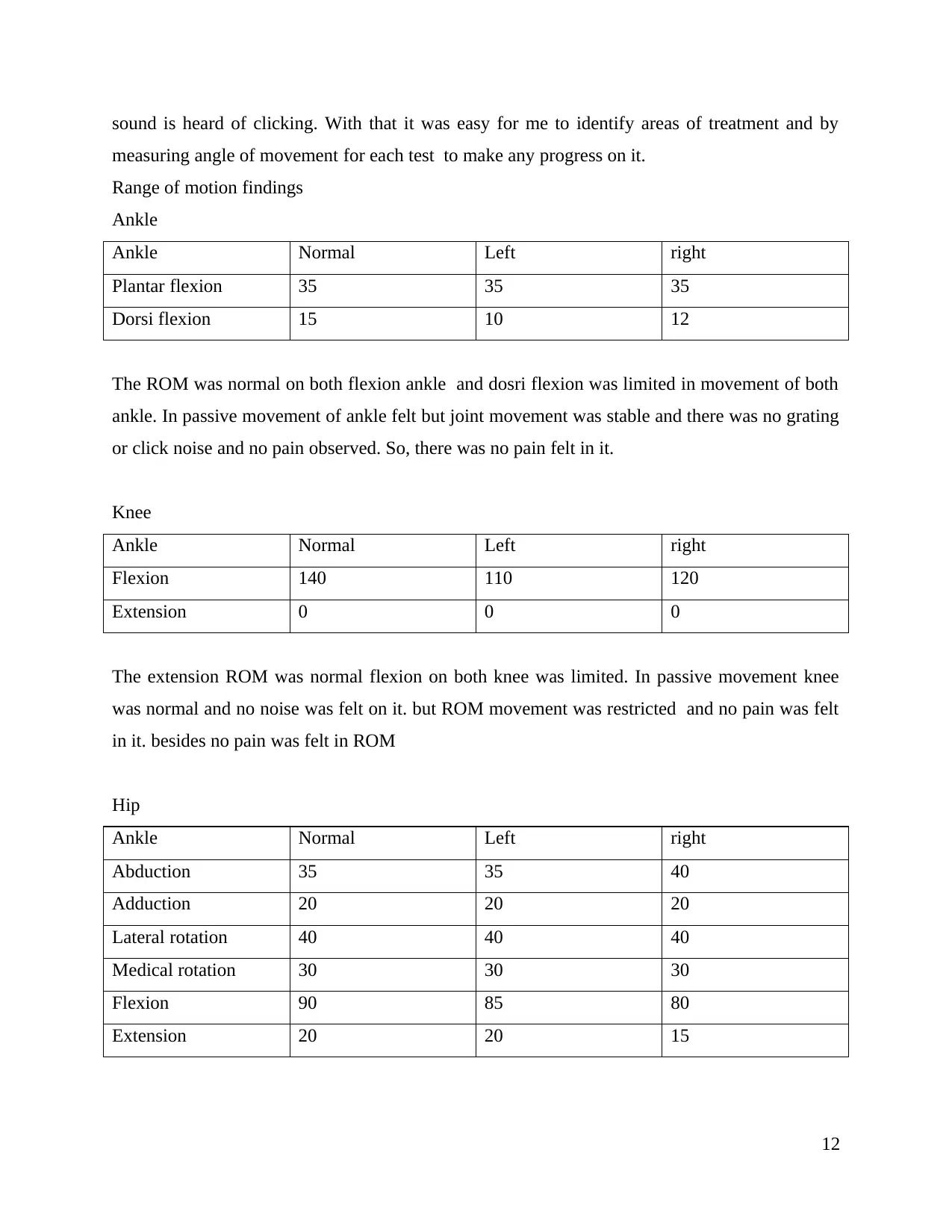
sound is heard of clicking. With that it was easy for me to identify areas of treatment and by
measuring angle of movement for each test to make any progress on it.
Range of motion findings
Ankle
Ankle Normal Left right
Plantar flexion 35 35 35
Dorsi flexion 15 10 12
The ROM was normal on both flexion ankle and dosri flexion was limited in movement of both
ankle. In passive movement of ankle felt but joint movement was stable and there was no grating
or click noise and no pain observed. So, there was no pain felt in it.
Knee
Ankle Normal Left right
Flexion 140 110 120
Extension 0 0 0
The extension ROM was normal flexion on both knee was limited. In passive movement knee
was normal and no noise was felt on it. but ROM movement was restricted and no pain was felt
in it. besides no pain was felt in ROM
Hip
Ankle Normal Left right
Abduction 35 35 40
Adduction 20 20 20
Lateral rotation 40 40 40
Medical rotation 30 30 30
Flexion 90 85 80
Extension 20 20 15
12
measuring angle of movement for each test to make any progress on it.
Range of motion findings
Ankle
Ankle Normal Left right
Plantar flexion 35 35 35
Dorsi flexion 15 10 12
The ROM was normal on both flexion ankle and dosri flexion was limited in movement of both
ankle. In passive movement of ankle felt but joint movement was stable and there was no grating
or click noise and no pain observed. So, there was no pain felt in it.
Knee
Ankle Normal Left right
Flexion 140 110 120
Extension 0 0 0
The extension ROM was normal flexion on both knee was limited. In passive movement knee
was normal and no noise was felt on it. but ROM movement was restricted and no pain was felt
in it. besides no pain was felt in ROM
Hip
Ankle Normal Left right
Abduction 35 35 40
Adduction 20 20 20
Lateral rotation 40 40 40
Medical rotation 30 30 30
Flexion 90 85 80
Extension 20 20 15
12
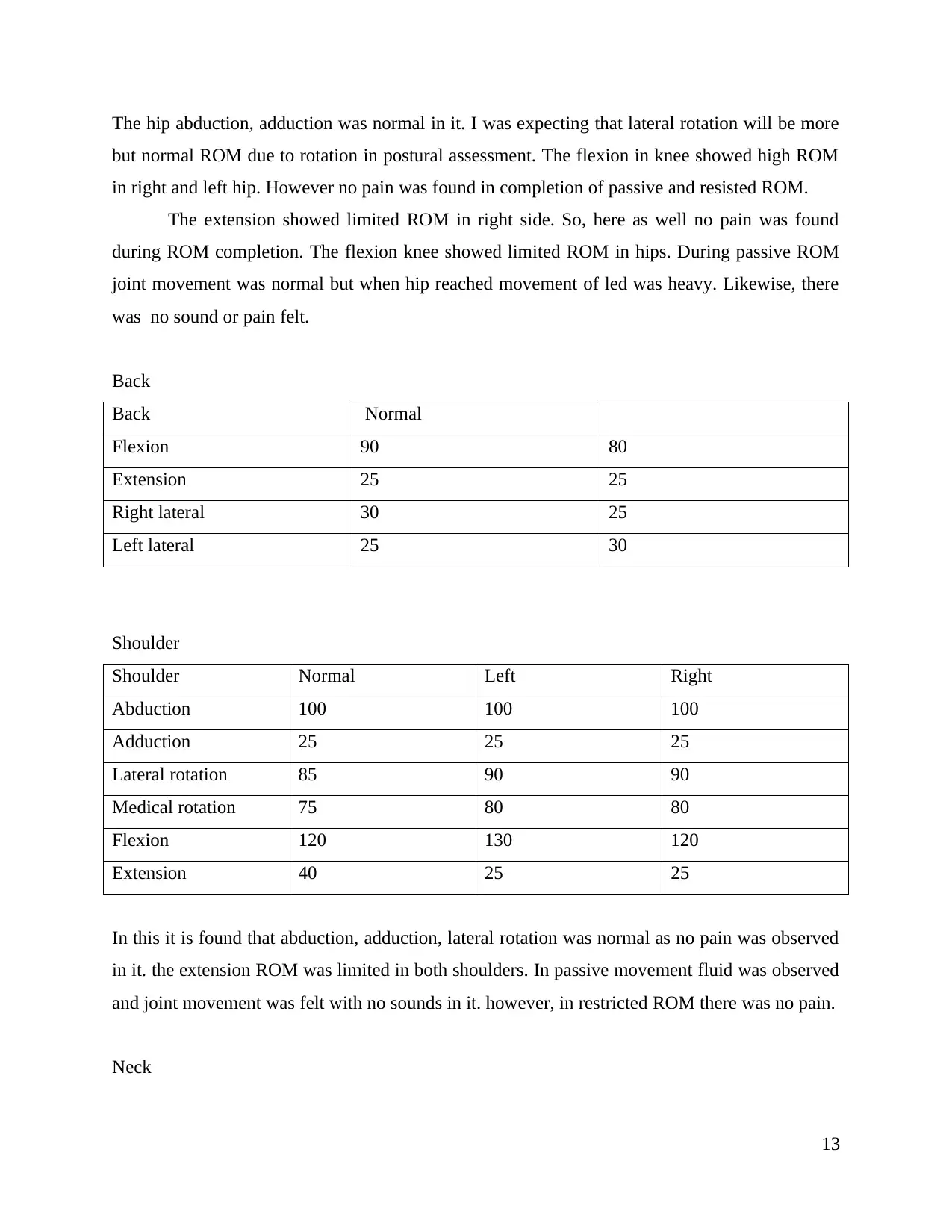
The hip abduction, adduction was normal in it. I was expecting that lateral rotation will be more
but normal ROM due to rotation in postural assessment. The flexion in knee showed high ROM
in right and left hip. However no pain was found in completion of passive and resisted ROM.
The extension showed limited ROM in right side. So, here as well no pain was found
during ROM completion. The flexion knee showed limited ROM in hips. During passive ROM
joint movement was normal but when hip reached movement of led was heavy. Likewise, there
was no sound or pain felt.
Back
Back Normal
Flexion 90 80
Extension 25 25
Right lateral 30 25
Left lateral 25 30
Shoulder
Shoulder Normal Left Right
Abduction 100 100 100
Adduction 25 25 25
Lateral rotation 85 90 90
Medical rotation 75 80 80
Flexion 120 130 120
Extension 40 25 25
In this it is found that abduction, adduction, lateral rotation was normal as no pain was observed
in it. the extension ROM was limited in both shoulders. In passive movement fluid was observed
and joint movement was felt with no sounds in it. however, in restricted ROM there was no pain.
Neck
13
but normal ROM due to rotation in postural assessment. The flexion in knee showed high ROM
in right and left hip. However no pain was found in completion of passive and resisted ROM.
The extension showed limited ROM in right side. So, here as well no pain was found
during ROM completion. The flexion knee showed limited ROM in hips. During passive ROM
joint movement was normal but when hip reached movement of led was heavy. Likewise, there
was no sound or pain felt.
Back
Back Normal
Flexion 90 80
Extension 25 25
Right lateral 30 25
Left lateral 25 30
Shoulder
Shoulder Normal Left Right
Abduction 100 100 100
Adduction 25 25 25
Lateral rotation 85 90 90
Medical rotation 75 80 80
Flexion 120 130 120
Extension 40 25 25
In this it is found that abduction, adduction, lateral rotation was normal as no pain was observed
in it. the extension ROM was limited in both shoulders. In passive movement fluid was observed
and joint movement was felt with no sounds in it. however, in restricted ROM there was no pain.
Neck
13
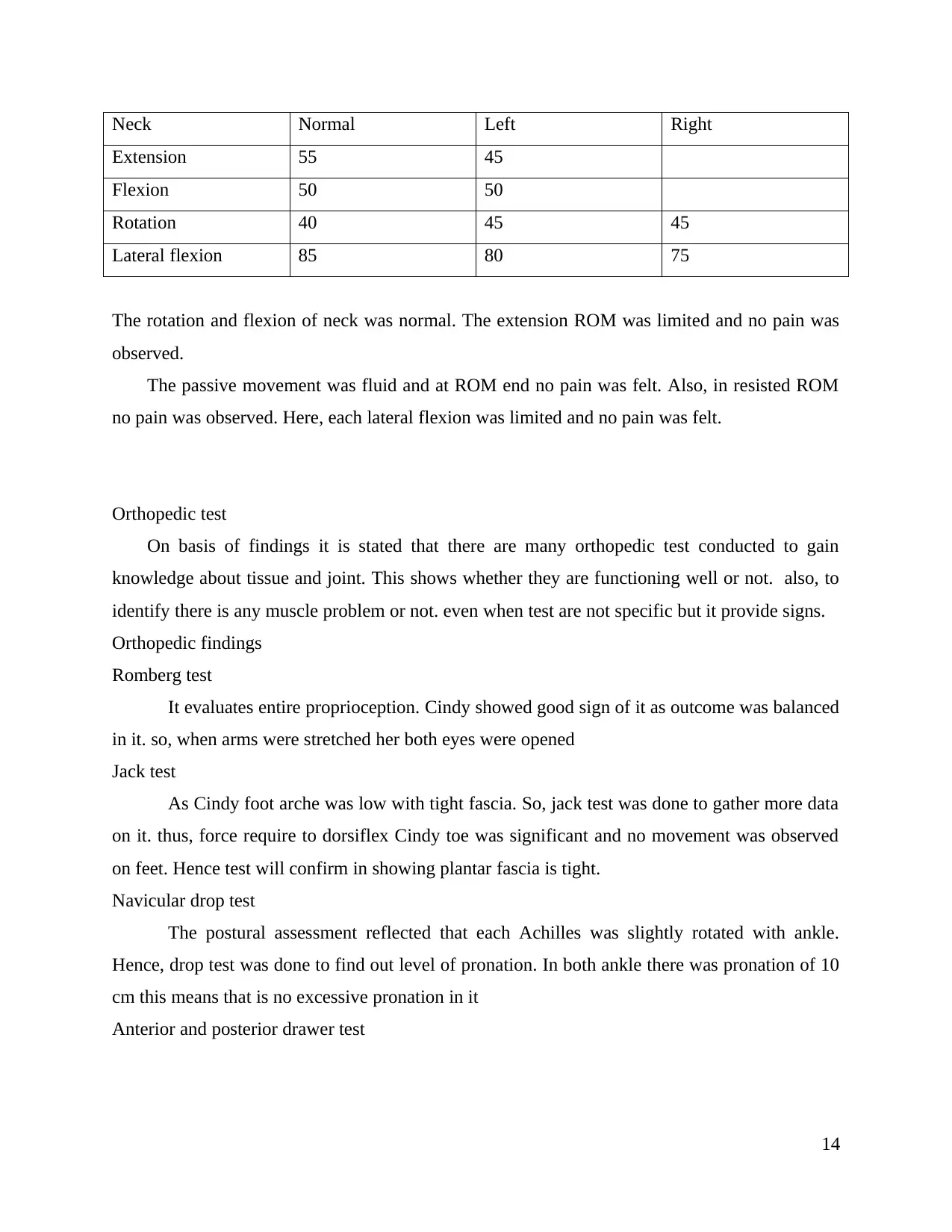
Neck Normal Left Right
Extension 55 45
Flexion 50 50
Rotation 40 45 45
Lateral flexion 85 80 75
The rotation and flexion of neck was normal. The extension ROM was limited and no pain was
observed.
The passive movement was fluid and at ROM end no pain was felt. Also, in resisted ROM
no pain was observed. Here, each lateral flexion was limited and no pain was felt.
Orthopedic test
On basis of findings it is stated that there are many orthopedic test conducted to gain
knowledge about tissue and joint. This shows whether they are functioning well or not. also, to
identify there is any muscle problem or not. even when test are not specific but it provide signs.
Orthopedic findings
Romberg test
It evaluates entire proprioception. Cindy showed good sign of it as outcome was balanced
in it. so, when arms were stretched her both eyes were opened
Jack test
As Cindy foot arche was low with tight fascia. So, jack test was done to gather more data
on it. thus, force require to dorsiflex Cindy toe was significant and no movement was observed
on feet. Hence test will confirm in showing plantar fascia is tight.
Navicular drop test
The postural assessment reflected that each Achilles was slightly rotated with ankle.
Hence, drop test was done to find out level of pronation. In both ankle there was pronation of 10
cm this means that is no excessive pronation in it
Anterior and posterior drawer test
14
Extension 55 45
Flexion 50 50
Rotation 40 45 45
Lateral flexion 85 80 75
The rotation and flexion of neck was normal. The extension ROM was limited and no pain was
observed.
The passive movement was fluid and at ROM end no pain was felt. Also, in resisted ROM
no pain was observed. Here, each lateral flexion was limited and no pain was felt.
Orthopedic test
On basis of findings it is stated that there are many orthopedic test conducted to gain
knowledge about tissue and joint. This shows whether they are functioning well or not. also, to
identify there is any muscle problem or not. even when test are not specific but it provide signs.
Orthopedic findings
Romberg test
It evaluates entire proprioception. Cindy showed good sign of it as outcome was balanced
in it. so, when arms were stretched her both eyes were opened
Jack test
As Cindy foot arche was low with tight fascia. So, jack test was done to gather more data
on it. thus, force require to dorsiflex Cindy toe was significant and no movement was observed
on feet. Hence test will confirm in showing plantar fascia is tight.
Navicular drop test
The postural assessment reflected that each Achilles was slightly rotated with ankle.
Hence, drop test was done to find out level of pronation. In both ankle there was pronation of 10
cm this means that is no excessive pronation in it
Anterior and posterior drawer test
14
Secure Best Marks with AI Grader
Need help grading? Try our AI Grader for instant feedback on your assignments.
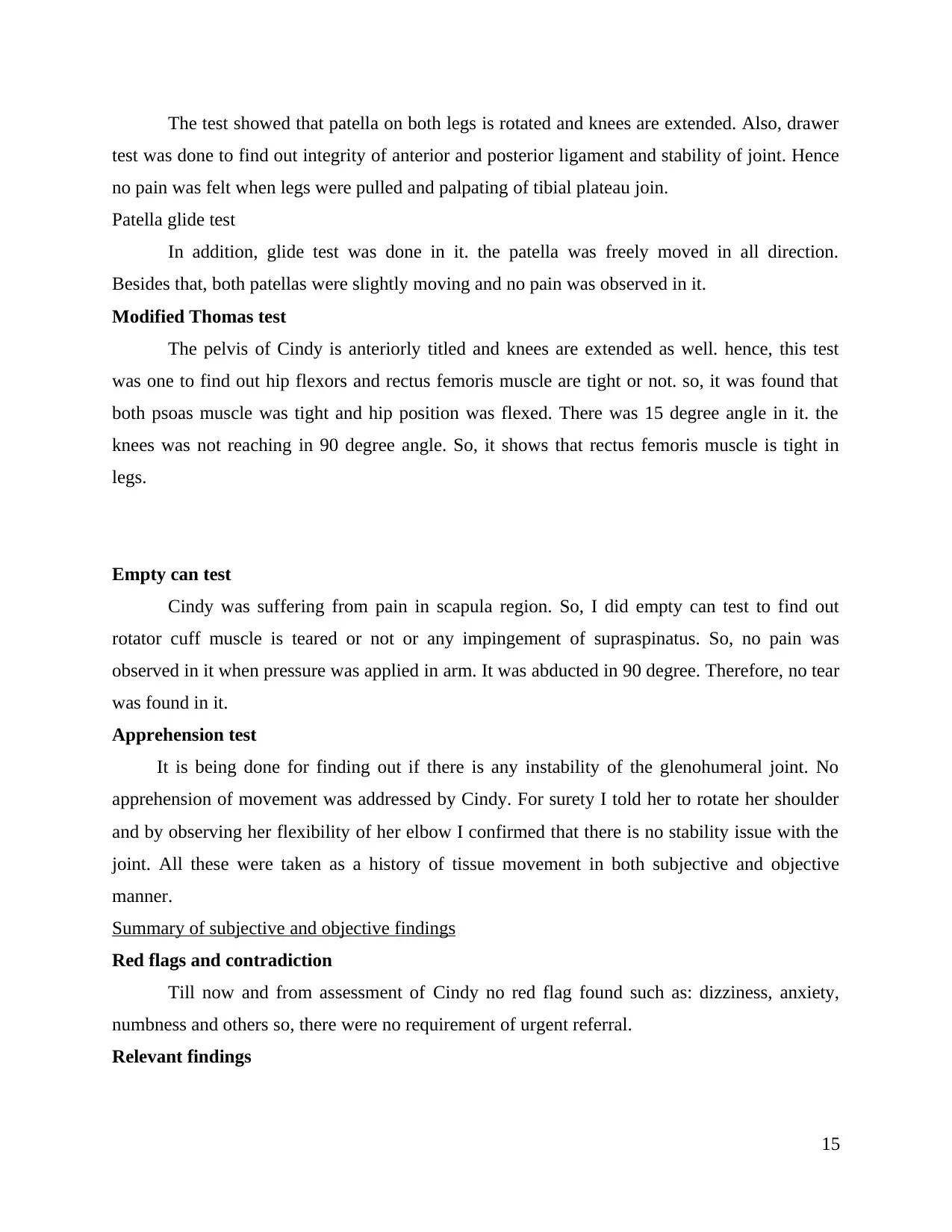
The test showed that patella on both legs is rotated and knees are extended. Also, drawer
test was done to find out integrity of anterior and posterior ligament and stability of joint. Hence
no pain was felt when legs were pulled and palpating of tibial plateau join.
Patella glide test
In addition, glide test was done in it. the patella was freely moved in all direction.
Besides that, both patellas were slightly moving and no pain was observed in it.
Modified Thomas test
The pelvis of Cindy is anteriorly titled and knees are extended as well. hence, this test
was one to find out hip flexors and rectus femoris muscle are tight or not. so, it was found that
both psoas muscle was tight and hip position was flexed. There was 15 degree angle in it. the
knees was not reaching in 90 degree angle. So, it shows that rectus femoris muscle is tight in
legs.
Empty can test
Cindy was suffering from pain in scapula region. So, I did empty can test to find out
rotator cuff muscle is teared or not or any impingement of supraspinatus. So, no pain was
observed in it when pressure was applied in arm. It was abducted in 90 degree. Therefore, no tear
was found in it.
Apprehension test
It is being done for finding out if there is any instability of the glenohumeral joint. No
apprehension of movement was addressed by Cindy. For surety I told her to rotate her shoulder
and by observing her flexibility of her elbow I confirmed that there is no stability issue with the
joint. All these were taken as a history of tissue movement in both subjective and objective
manner.
Summary of subjective and objective findings
Red flags and contradiction
Till now and from assessment of Cindy no red flag found such as: dizziness, anxiety,
numbness and others so, there were no requirement of urgent referral.
Relevant findings
15
test was done to find out integrity of anterior and posterior ligament and stability of joint. Hence
no pain was felt when legs were pulled and palpating of tibial plateau join.
Patella glide test
In addition, glide test was done in it. the patella was freely moved in all direction.
Besides that, both patellas were slightly moving and no pain was observed in it.
Modified Thomas test
The pelvis of Cindy is anteriorly titled and knees are extended as well. hence, this test
was one to find out hip flexors and rectus femoris muscle are tight or not. so, it was found that
both psoas muscle was tight and hip position was flexed. There was 15 degree angle in it. the
knees was not reaching in 90 degree angle. So, it shows that rectus femoris muscle is tight in
legs.
Empty can test
Cindy was suffering from pain in scapula region. So, I did empty can test to find out
rotator cuff muscle is teared or not or any impingement of supraspinatus. So, no pain was
observed in it when pressure was applied in arm. It was abducted in 90 degree. Therefore, no tear
was found in it.
Apprehension test
It is being done for finding out if there is any instability of the glenohumeral joint. No
apprehension of movement was addressed by Cindy. For surety I told her to rotate her shoulder
and by observing her flexibility of her elbow I confirmed that there is no stability issue with the
joint. All these were taken as a history of tissue movement in both subjective and objective
manner.
Summary of subjective and objective findings
Red flags and contradiction
Till now and from assessment of Cindy no red flag found such as: dizziness, anxiety,
numbness and others so, there were no requirement of urgent referral.
Relevant findings
15
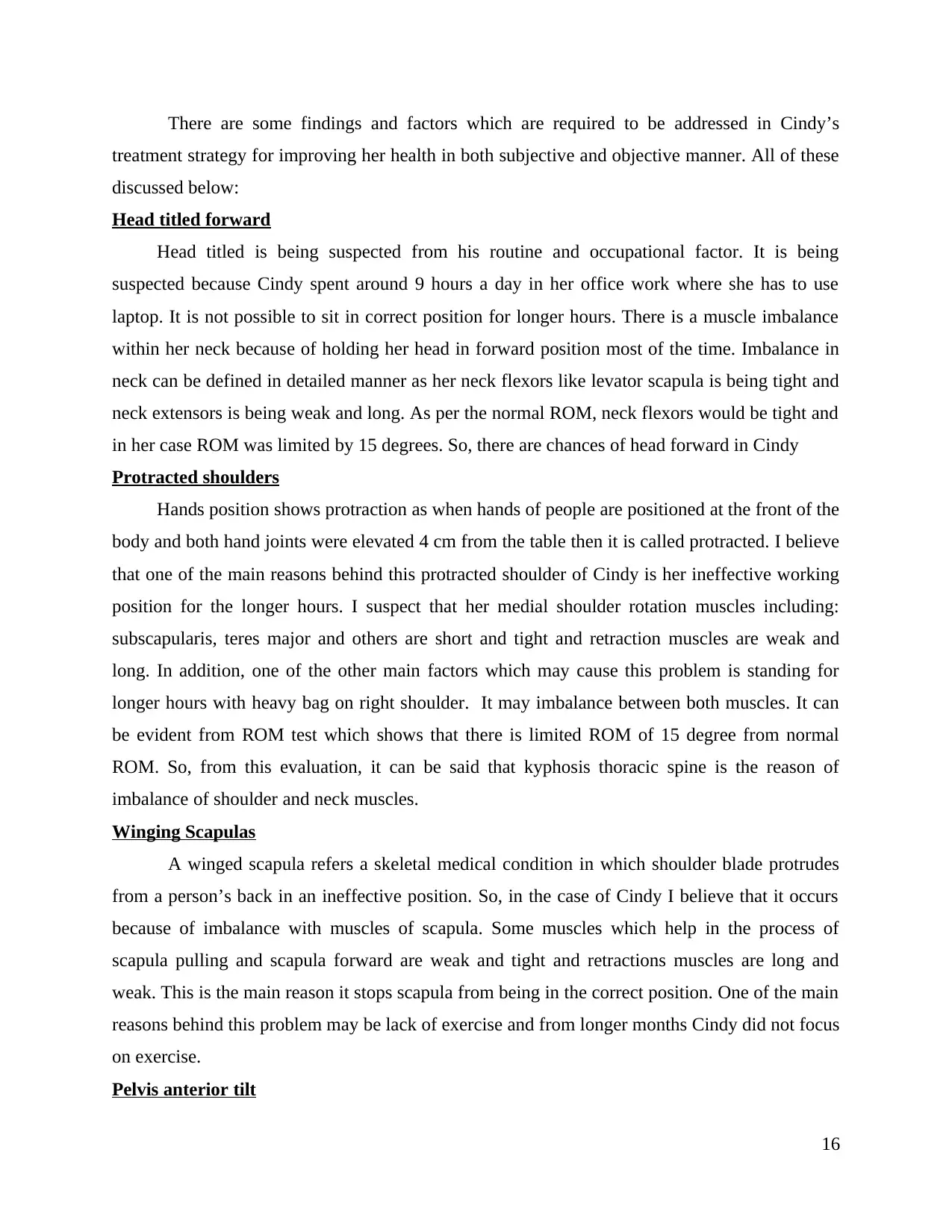
There are some findings and factors which are required to be addressed in Cindy’s
treatment strategy for improving her health in both subjective and objective manner. All of these
discussed below:
Head titled forward
Head titled is being suspected from his routine and occupational factor. It is being
suspected because Cindy spent around 9 hours a day in her office work where she has to use
laptop. It is not possible to sit in correct position for longer hours. There is a muscle imbalance
within her neck because of holding her head in forward position most of the time. Imbalance in
neck can be defined in detailed manner as her neck flexors like levator scapula is being tight and
neck extensors is being weak and long. As per the normal ROM, neck flexors would be tight and
in her case ROM was limited by 15 degrees. So, there are chances of head forward in Cindy
Protracted shoulders
Hands position shows protraction as when hands of people are positioned at the front of the
body and both hand joints were elevated 4 cm from the table then it is called protracted. I believe
that one of the main reasons behind this protracted shoulder of Cindy is her ineffective working
position for the longer hours. I suspect that her medial shoulder rotation muscles including:
subscapularis, teres major and others are short and tight and retraction muscles are weak and
long. In addition, one of the other main factors which may cause this problem is standing for
longer hours with heavy bag on right shoulder. It may imbalance between both muscles. It can
be evident from ROM test which shows that there is limited ROM of 15 degree from normal
ROM. So, from this evaluation, it can be said that kyphosis thoracic spine is the reason of
imbalance of shoulder and neck muscles.
Winging Scapulas
A winged scapula refers a skeletal medical condition in which shoulder blade protrudes
from a person’s back in an ineffective position. So, in the case of Cindy I believe that it occurs
because of imbalance with muscles of scapula. Some muscles which help in the process of
scapula pulling and scapula forward are weak and tight and retractions muscles are long and
weak. This is the main reason it stops scapula from being in the correct position. One of the main
reasons behind this problem may be lack of exercise and from longer months Cindy did not focus
on exercise.
Pelvis anterior tilt
16
treatment strategy for improving her health in both subjective and objective manner. All of these
discussed below:
Head titled forward
Head titled is being suspected from his routine and occupational factor. It is being
suspected because Cindy spent around 9 hours a day in her office work where she has to use
laptop. It is not possible to sit in correct position for longer hours. There is a muscle imbalance
within her neck because of holding her head in forward position most of the time. Imbalance in
neck can be defined in detailed manner as her neck flexors like levator scapula is being tight and
neck extensors is being weak and long. As per the normal ROM, neck flexors would be tight and
in her case ROM was limited by 15 degrees. So, there are chances of head forward in Cindy
Protracted shoulders
Hands position shows protraction as when hands of people are positioned at the front of the
body and both hand joints were elevated 4 cm from the table then it is called protracted. I believe
that one of the main reasons behind this protracted shoulder of Cindy is her ineffective working
position for the longer hours. I suspect that her medial shoulder rotation muscles including:
subscapularis, teres major and others are short and tight and retraction muscles are weak and
long. In addition, one of the other main factors which may cause this problem is standing for
longer hours with heavy bag on right shoulder. It may imbalance between both muscles. It can
be evident from ROM test which shows that there is limited ROM of 15 degree from normal
ROM. So, from this evaluation, it can be said that kyphosis thoracic spine is the reason of
imbalance of shoulder and neck muscles.
Winging Scapulas
A winged scapula refers a skeletal medical condition in which shoulder blade protrudes
from a person’s back in an ineffective position. So, in the case of Cindy I believe that it occurs
because of imbalance with muscles of scapula. Some muscles which help in the process of
scapula pulling and scapula forward are weak and tight and retractions muscles are long and
weak. This is the main reason it stops scapula from being in the correct position. One of the main
reasons behind this problem may be lack of exercise and from longer months Cindy did not focus
on exercise.
Pelvis anterior tilt
16
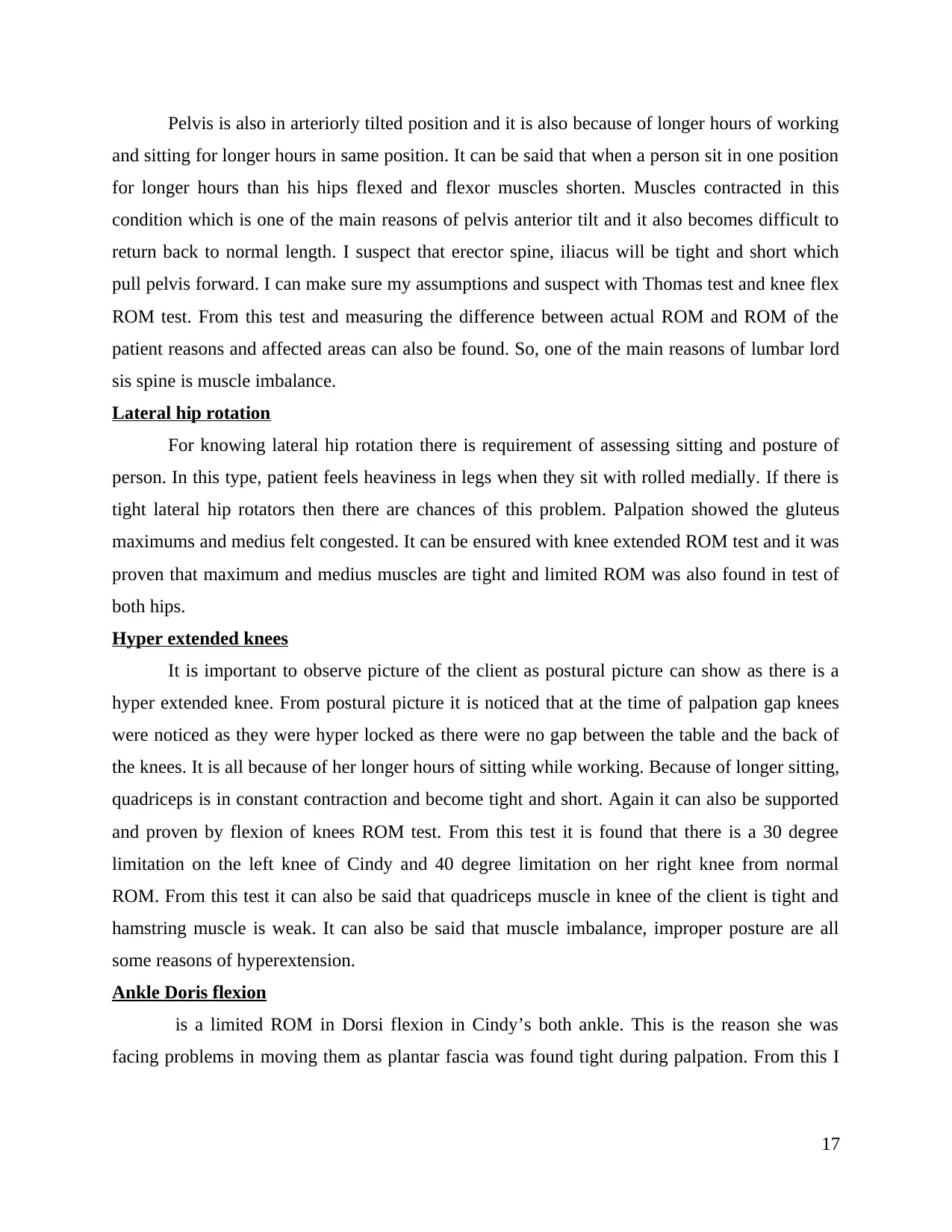
Pelvis is also in arteriorly tilted position and it is also because of longer hours of working
and sitting for longer hours in same position. It can be said that when a person sit in one position
for longer hours than his hips flexed and flexor muscles shorten. Muscles contracted in this
condition which is one of the main reasons of pelvis anterior tilt and it also becomes difficult to
return back to normal length. I suspect that erector spine, iliacus will be tight and short which
pull pelvis forward. I can make sure my assumptions and suspect with Thomas test and knee flex
ROM test. From this test and measuring the difference between actual ROM and ROM of the
patient reasons and affected areas can also be found. So, one of the main reasons of lumbar lord
sis spine is muscle imbalance.
Lateral hip rotation
For knowing lateral hip rotation there is requirement of assessing sitting and posture of
person. In this type, patient feels heaviness in legs when they sit with rolled medially. If there is
tight lateral hip rotators then there are chances of this problem. Palpation showed the gluteus
maximums and medius felt congested. It can be ensured with knee extended ROM test and it was
proven that maximum and medius muscles are tight and limited ROM was also found in test of
both hips.
Hyper extended knees
It is important to observe picture of the client as postural picture can show as there is a
hyper extended knee. From postural picture it is noticed that at the time of palpation gap knees
were noticed as they were hyper locked as there were no gap between the table and the back of
the knees. It is all because of her longer hours of sitting while working. Because of longer sitting,
quadriceps is in constant contraction and become tight and short. Again it can also be supported
and proven by flexion of knees ROM test. From this test it is found that there is a 30 degree
limitation on the left knee of Cindy and 40 degree limitation on her right knee from normal
ROM. From this test it can also be said that quadriceps muscle in knee of the client is tight and
hamstring muscle is weak. It can also be said that muscle imbalance, improper posture are all
some reasons of hyperextension.
Ankle Doris flexion
is a limited ROM in Dorsi flexion in Cindy’s both ankle. This is the reason she was
facing problems in moving them as plantar fascia was found tight during palpation. From this I
17
and sitting for longer hours in same position. It can be said that when a person sit in one position
for longer hours than his hips flexed and flexor muscles shorten. Muscles contracted in this
condition which is one of the main reasons of pelvis anterior tilt and it also becomes difficult to
return back to normal length. I suspect that erector spine, iliacus will be tight and short which
pull pelvis forward. I can make sure my assumptions and suspect with Thomas test and knee flex
ROM test. From this test and measuring the difference between actual ROM and ROM of the
patient reasons and affected areas can also be found. So, one of the main reasons of lumbar lord
sis spine is muscle imbalance.
Lateral hip rotation
For knowing lateral hip rotation there is requirement of assessing sitting and posture of
person. In this type, patient feels heaviness in legs when they sit with rolled medially. If there is
tight lateral hip rotators then there are chances of this problem. Palpation showed the gluteus
maximums and medius felt congested. It can be ensured with knee extended ROM test and it was
proven that maximum and medius muscles are tight and limited ROM was also found in test of
both hips.
Hyper extended knees
It is important to observe picture of the client as postural picture can show as there is a
hyper extended knee. From postural picture it is noticed that at the time of palpation gap knees
were noticed as they were hyper locked as there were no gap between the table and the back of
the knees. It is all because of her longer hours of sitting while working. Because of longer sitting,
quadriceps is in constant contraction and become tight and short. Again it can also be supported
and proven by flexion of knees ROM test. From this test it is found that there is a 30 degree
limitation on the left knee of Cindy and 40 degree limitation on her right knee from normal
ROM. From this test it can also be said that quadriceps muscle in knee of the client is tight and
hamstring muscle is weak. It can also be said that muscle imbalance, improper posture are all
some reasons of hyperextension.
Ankle Doris flexion
is a limited ROM in Dorsi flexion in Cindy’s both ankle. This is the reason she was
facing problems in moving them as plantar fascia was found tight during palpation. From this I
17
Paraphrase This Document
Need a fresh take? Get an instant paraphrase of this document with our AI Paraphraser

suspected that tight soleus is making Achilles tendon tight because it is fixed to it. It can be
confirmed by Jacks test and it is being confirmed that there is a tight plantar fascia.
Shallow breathing
It is found that Cindy’s sitting posture is not proper and effective and this is one of the
main reason and cause of all problems and muscle imbalance. It is also found that she breaths
from her chest rather than diaphragm and it is also because of her poor sitting position and
ineffective posture, Due to longer working and sitting hours in company, it contributes to tilting
of head, neck flexors and medial shoulder muscles. This ineffective and poor posture along with
weak and tight muscles is reducing effectiveness of primary breathing muscle. This shallow
breathing can cause several problems like lack of oxygen in breathing. Due to shallow breathing,
patient also fined problems in releasing CO2 and due to this it leads increment in acidity level. It
affects overall health as tissues become poor and weak. It also leads to tissue inflammation. It
makes patient frustrated when they find problems in breathing and when CO2 increases in the
body.
Disturbed sleep
It is found that Cindy is suffering from some problems and due to imbalance in muscles,
in shoulders neck and other parts it increases pain. All these problems lead to frustration and it
directs affects sleep. Due to disturbed sleep, CNS becomes sensitive and reactive by which
patient experience pain the most. It is believed that proper sleep relaxes mind and help patient in
reducing pain. Systematic inflammation is also a result of disturbed sleep and muscles also take
time in recovering because of this. One of the reason behind it is growth hormone activates
during sleep and due to lack of sleep, muscles takes time in recovering and growing. So, it can be
said that having proper sleep is important in reducing pain and improving health.
Stage of injury and tissue health
In the context of stage of tissue health and injury it is found that Cindy is suffering from
many problems so, she is at critical stage. Ina assessment, past medical history and all details of
Cindy it is found that initially she was facing dull and deep aching pain and after some time it
was gradual onset of pain. But there was no accident found which caused pain so, test was done
and from test it is found that after applying pressure for around 10 minutes the pain decreased.
So, I believe that the main reason of pain is muscle imbalance because there were no other
symptoms like redness and swelling.
18
confirmed by Jacks test and it is being confirmed that there is a tight plantar fascia.
Shallow breathing
It is found that Cindy’s sitting posture is not proper and effective and this is one of the
main reason and cause of all problems and muscle imbalance. It is also found that she breaths
from her chest rather than diaphragm and it is also because of her poor sitting position and
ineffective posture, Due to longer working and sitting hours in company, it contributes to tilting
of head, neck flexors and medial shoulder muscles. This ineffective and poor posture along with
weak and tight muscles is reducing effectiveness of primary breathing muscle. This shallow
breathing can cause several problems like lack of oxygen in breathing. Due to shallow breathing,
patient also fined problems in releasing CO2 and due to this it leads increment in acidity level. It
affects overall health as tissues become poor and weak. It also leads to tissue inflammation. It
makes patient frustrated when they find problems in breathing and when CO2 increases in the
body.
Disturbed sleep
It is found that Cindy is suffering from some problems and due to imbalance in muscles,
in shoulders neck and other parts it increases pain. All these problems lead to frustration and it
directs affects sleep. Due to disturbed sleep, CNS becomes sensitive and reactive by which
patient experience pain the most. It is believed that proper sleep relaxes mind and help patient in
reducing pain. Systematic inflammation is also a result of disturbed sleep and muscles also take
time in recovering because of this. One of the reason behind it is growth hormone activates
during sleep and due to lack of sleep, muscles takes time in recovering and growing. So, it can be
said that having proper sleep is important in reducing pain and improving health.
Stage of injury and tissue health
In the context of stage of tissue health and injury it is found that Cindy is suffering from
many problems so, she is at critical stage. Ina assessment, past medical history and all details of
Cindy it is found that initially she was facing dull and deep aching pain and after some time it
was gradual onset of pain. But there was no accident found which caused pain so, test was done
and from test it is found that after applying pressure for around 10 minutes the pain decreased.
So, I believe that the main reason of pain is muscle imbalance because there were no other
symptoms like redness and swelling.
18
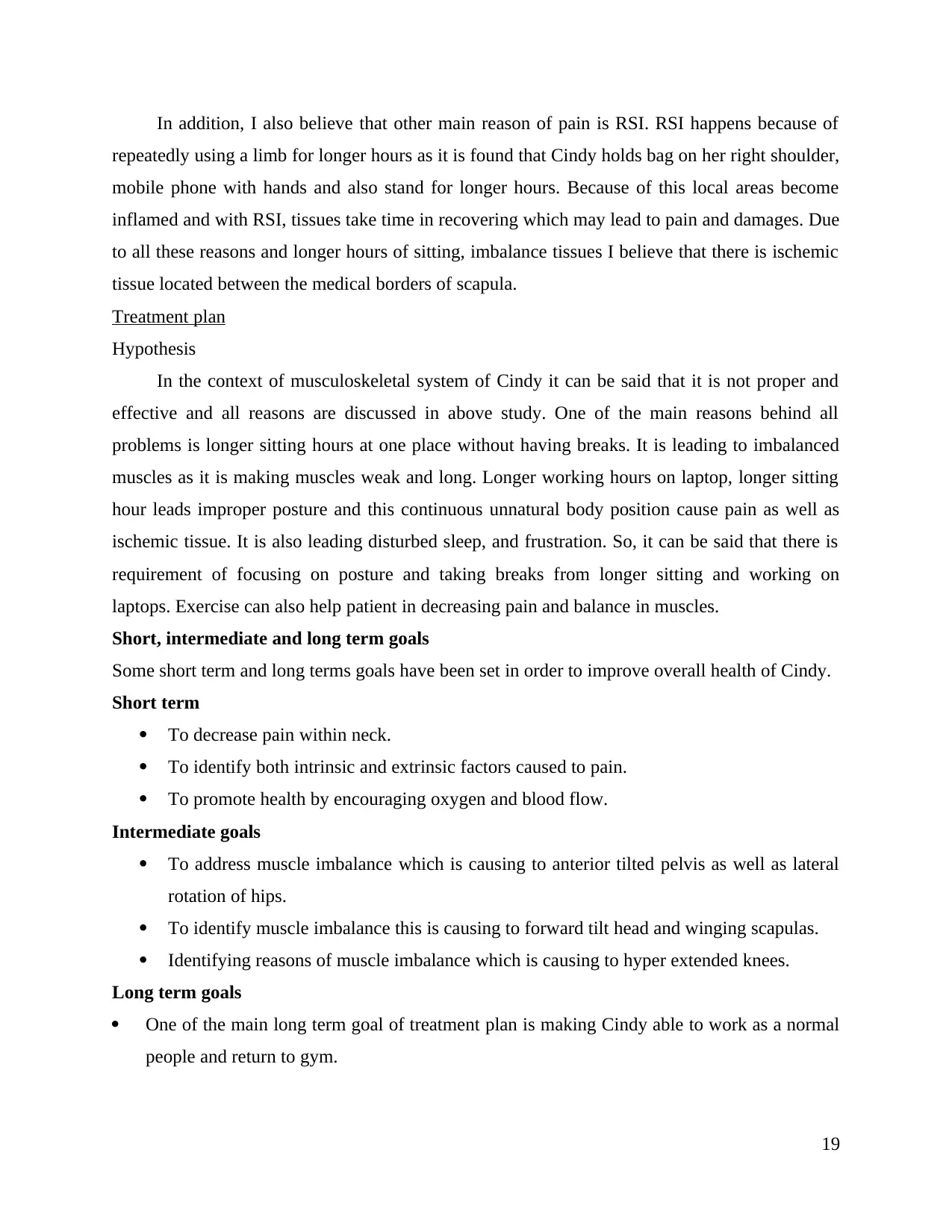
In addition, I also believe that other main reason of pain is RSI. RSI happens because of
repeatedly using a limb for longer hours as it is found that Cindy holds bag on her right shoulder,
mobile phone with hands and also stand for longer hours. Because of this local areas become
inflamed and with RSI, tissues take time in recovering which may lead to pain and damages. Due
to all these reasons and longer hours of sitting, imbalance tissues I believe that there is ischemic
tissue located between the medical borders of scapula.
Treatment plan
Hypothesis
In the context of musculoskeletal system of Cindy it can be said that it is not proper and
effective and all reasons are discussed in above study. One of the main reasons behind all
problems is longer sitting hours at one place without having breaks. It is leading to imbalanced
muscles as it is making muscles weak and long. Longer working hours on laptop, longer sitting
hour leads improper posture and this continuous unnatural body position cause pain as well as
ischemic tissue. It is also leading disturbed sleep, and frustration. So, it can be said that there is
requirement of focusing on posture and taking breaks from longer sitting and working on
laptops. Exercise can also help patient in decreasing pain and balance in muscles.
Short, intermediate and long term goals
Some short term and long terms goals have been set in order to improve overall health of Cindy.
Short term
To decrease pain within neck.
To identify both intrinsic and extrinsic factors caused to pain.
To promote health by encouraging oxygen and blood flow.
Intermediate goals
To address muscle imbalance which is causing to anterior tilted pelvis as well as lateral
rotation of hips.
To identify muscle imbalance this is causing to forward tilt head and winging scapulas.
Identifying reasons of muscle imbalance which is causing to hyper extended knees.
Long term goals
One of the main long term goal of treatment plan is making Cindy able to work as a normal
people and return to gym.
19
repeatedly using a limb for longer hours as it is found that Cindy holds bag on her right shoulder,
mobile phone with hands and also stand for longer hours. Because of this local areas become
inflamed and with RSI, tissues take time in recovering which may lead to pain and damages. Due
to all these reasons and longer hours of sitting, imbalance tissues I believe that there is ischemic
tissue located between the medical borders of scapula.
Treatment plan
Hypothesis
In the context of musculoskeletal system of Cindy it can be said that it is not proper and
effective and all reasons are discussed in above study. One of the main reasons behind all
problems is longer sitting hours at one place without having breaks. It is leading to imbalanced
muscles as it is making muscles weak and long. Longer working hours on laptop, longer sitting
hour leads improper posture and this continuous unnatural body position cause pain as well as
ischemic tissue. It is also leading disturbed sleep, and frustration. So, it can be said that there is
requirement of focusing on posture and taking breaks from longer sitting and working on
laptops. Exercise can also help patient in decreasing pain and balance in muscles.
Short, intermediate and long term goals
Some short term and long terms goals have been set in order to improve overall health of Cindy.
Short term
To decrease pain within neck.
To identify both intrinsic and extrinsic factors caused to pain.
To promote health by encouraging oxygen and blood flow.
Intermediate goals
To address muscle imbalance which is causing to anterior tilted pelvis as well as lateral
rotation of hips.
To identify muscle imbalance this is causing to forward tilt head and winging scapulas.
Identifying reasons of muscle imbalance which is causing to hyper extended knees.
Long term goals
One of the main long term goal of treatment plan is making Cindy able to work as a normal
people and return to gym.
19
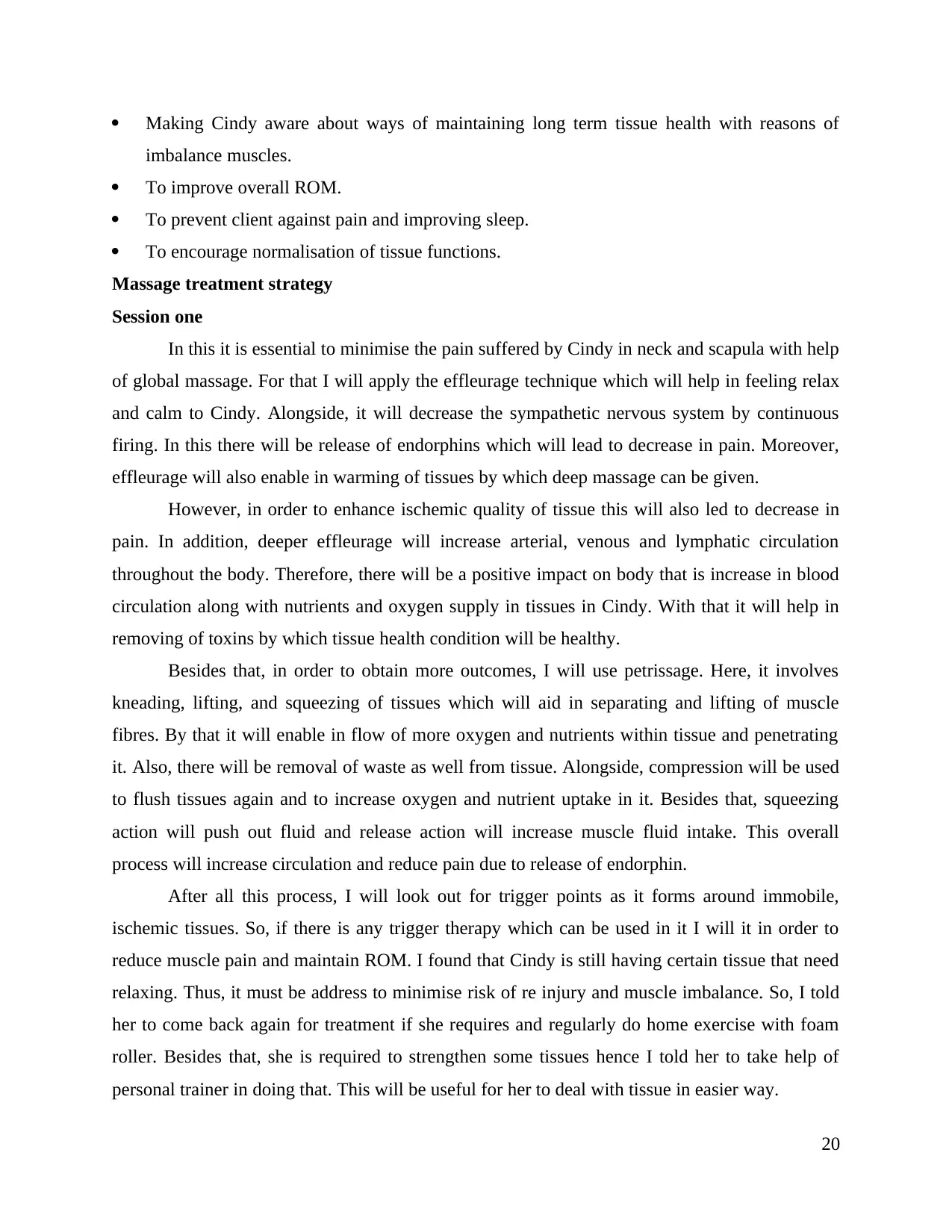
Making Cindy aware about ways of maintaining long term tissue health with reasons of
imbalance muscles.
To improve overall ROM.
To prevent client against pain and improving sleep.
To encourage normalisation of tissue functions.
Massage treatment strategy
Session one
In this it is essential to minimise the pain suffered by Cindy in neck and scapula with help
of global massage. For that I will apply the effleurage technique which will help in feeling relax
and calm to Cindy. Alongside, it will decrease the sympathetic nervous system by continuous
firing. In this there will be release of endorphins which will lead to decrease in pain. Moreover,
effleurage will also enable in warming of tissues by which deep massage can be given.
However, in order to enhance ischemic quality of tissue this will also led to decrease in
pain. In addition, deeper effleurage will increase arterial, venous and lymphatic circulation
throughout the body. Therefore, there will be a positive impact on body that is increase in blood
circulation along with nutrients and oxygen supply in tissues in Cindy. With that it will help in
removing of toxins by which tissue health condition will be healthy.
Besides that, in order to obtain more outcomes, I will use petrissage. Here, it involves
kneading, lifting, and squeezing of tissues which will aid in separating and lifting of muscle
fibres. By that it will enable in flow of more oxygen and nutrients within tissue and penetrating
it. Also, there will be removal of waste as well from tissue. Alongside, compression will be used
to flush tissues again and to increase oxygen and nutrient uptake in it. Besides that, squeezing
action will push out fluid and release action will increase muscle fluid intake. This overall
process will increase circulation and reduce pain due to release of endorphin.
After all this process, I will look out for trigger points as it forms around immobile,
ischemic tissues. So, if there is any trigger therapy which can be used in it I will it in order to
reduce muscle pain and maintain ROM. I found that Cindy is still having certain tissue that need
relaxing. Thus, it must be address to minimise risk of re injury and muscle imbalance. So, I told
her to come back again for treatment if she requires and regularly do home exercise with foam
roller. Besides that, she is required to strengthen some tissues hence I told her to take help of
personal trainer in doing that. This will be useful for her to deal with tissue in easier way.
20
imbalance muscles.
To improve overall ROM.
To prevent client against pain and improving sleep.
To encourage normalisation of tissue functions.
Massage treatment strategy
Session one
In this it is essential to minimise the pain suffered by Cindy in neck and scapula with help
of global massage. For that I will apply the effleurage technique which will help in feeling relax
and calm to Cindy. Alongside, it will decrease the sympathetic nervous system by continuous
firing. In this there will be release of endorphins which will lead to decrease in pain. Moreover,
effleurage will also enable in warming of tissues by which deep massage can be given.
However, in order to enhance ischemic quality of tissue this will also led to decrease in
pain. In addition, deeper effleurage will increase arterial, venous and lymphatic circulation
throughout the body. Therefore, there will be a positive impact on body that is increase in blood
circulation along with nutrients and oxygen supply in tissues in Cindy. With that it will help in
removing of toxins by which tissue health condition will be healthy.
Besides that, in order to obtain more outcomes, I will use petrissage. Here, it involves
kneading, lifting, and squeezing of tissues which will aid in separating and lifting of muscle
fibres. By that it will enable in flow of more oxygen and nutrients within tissue and penetrating
it. Also, there will be removal of waste as well from tissue. Alongside, compression will be used
to flush tissues again and to increase oxygen and nutrient uptake in it. Besides that, squeezing
action will push out fluid and release action will increase muscle fluid intake. This overall
process will increase circulation and reduce pain due to release of endorphin.
After all this process, I will look out for trigger points as it forms around immobile,
ischemic tissues. So, if there is any trigger therapy which can be used in it I will it in order to
reduce muscle pain and maintain ROM. I found that Cindy is still having certain tissue that need
relaxing. Thus, it must be address to minimise risk of re injury and muscle imbalance. So, I told
her to come back again for treatment if she requires and regularly do home exercise with foam
roller. Besides that, she is required to strengthen some tissues hence I told her to take help of
personal trainer in doing that. This will be useful for her to deal with tissue in easier way.
20
Secure Best Marks with AI Grader
Need help grading? Try our AI Grader for instant feedback on your assignments.

Then, I will start addressing muscle imbalance in neck, shoulder and scapula’s. This will
be done to rectify posture issues of forward head, shoulder and winging scapula. I think that it is
necessary to relax tight and short muscle before strengthening of weak muscle. So, for that I will
look into relaxing neck flexors, rotation shoulder flexion muscle and to stabilise scapula muscle.
In addition to that, I will emphasis on shoulder flexion muscle to enhance extension ROM of
shoulder. Moreover, by loosing of neck flexors it will improve extension of ROM in neck and
lateral left and right flexion. For that I will use PIR MET technique. Through that, I will be able
to target specific muscle and it will help in lengthening of tight muscle. Moreover, tone of tissues
will be reduced and it will break down muscle adhesions. The PIR work by initiation isometric
contraction of muscle, whereas GTO identify degree of load and a signal is send to CNS which
shows that too much pressure is applied. Hence, CNS deactivate motor neurone signal which
goes through muscle. It prevents contraction that led to relaxing of muscle when it is stretched.
Session two
In this session it will be based on first session. This enhance ischemic quality of tissue
and reduces pain. It uses effleurage, petrissage and compression. Then, next I will focus on
Cindy shallow breathing by using transverse effleurage and petrissage to follow in ribs.
Also, I will emphasis on addressing the muscle imbalance in neck, shoulder and scapula.
So, by further relaxing of neck flexors medical rotation and should muscle etc. For that I will use
MET in session one and along with it I will integrate STR technique as well. This will help in
normalising of tissue functioning and fibre length, improving elasticity of tissues and relieve
chronic tissue congestion. Besides that, transverse STR will be used to enhance slide and glide of
muscle create space within tissues, change its shape. Therefore, these all will help in releasing
tension in surrounding fascia. Thus, I will be able to work with more than one muscle at time of
attaining global benefits.
Then, in rest of the session I will strengthen weak muscle and work on neck extensors
shoulder retraction and serratus anterior. So, where it is possible for me, I will use RI MET
which allow me to release tension in weak muscle. Similarly, I will also strengthen opposite
weaker antagonist muscle. In that antagonist is stimulated through isometric contraction which
cause muscle spindle to stretch and reflex is activated. Thus, spindles will send signal to CNS
contraction and then CNS will deactivate motor neurone signal that goes into muscle instructing
21
be done to rectify posture issues of forward head, shoulder and winging scapula. I think that it is
necessary to relax tight and short muscle before strengthening of weak muscle. So, for that I will
look into relaxing neck flexors, rotation shoulder flexion muscle and to stabilise scapula muscle.
In addition to that, I will emphasis on shoulder flexion muscle to enhance extension ROM of
shoulder. Moreover, by loosing of neck flexors it will improve extension of ROM in neck and
lateral left and right flexion. For that I will use PIR MET technique. Through that, I will be able
to target specific muscle and it will help in lengthening of tight muscle. Moreover, tone of tissues
will be reduced and it will break down muscle adhesions. The PIR work by initiation isometric
contraction of muscle, whereas GTO identify degree of load and a signal is send to CNS which
shows that too much pressure is applied. Hence, CNS deactivate motor neurone signal which
goes through muscle. It prevents contraction that led to relaxing of muscle when it is stretched.
Session two
In this session it will be based on first session. This enhance ischemic quality of tissue
and reduces pain. It uses effleurage, petrissage and compression. Then, next I will focus on
Cindy shallow breathing by using transverse effleurage and petrissage to follow in ribs.
Also, I will emphasis on addressing the muscle imbalance in neck, shoulder and scapula.
So, by further relaxing of neck flexors medical rotation and should muscle etc. For that I will use
MET in session one and along with it I will integrate STR technique as well. This will help in
normalising of tissue functioning and fibre length, improving elasticity of tissues and relieve
chronic tissue congestion. Besides that, transverse STR will be used to enhance slide and glide of
muscle create space within tissues, change its shape. Therefore, these all will help in releasing
tension in surrounding fascia. Thus, I will be able to work with more than one muscle at time of
attaining global benefits.
Then, in rest of the session I will strengthen weak muscle and work on neck extensors
shoulder retraction and serratus anterior. So, where it is possible for me, I will use RI MET
which allow me to release tension in weak muscle. Similarly, I will also strengthen opposite
weaker antagonist muscle. In that antagonist is stimulated through isometric contraction which
cause muscle spindle to stretch and reflex is activated. Thus, spindles will send signal to CNS
contraction and then CNS will deactivate motor neurone signal that goes into muscle instructing
21
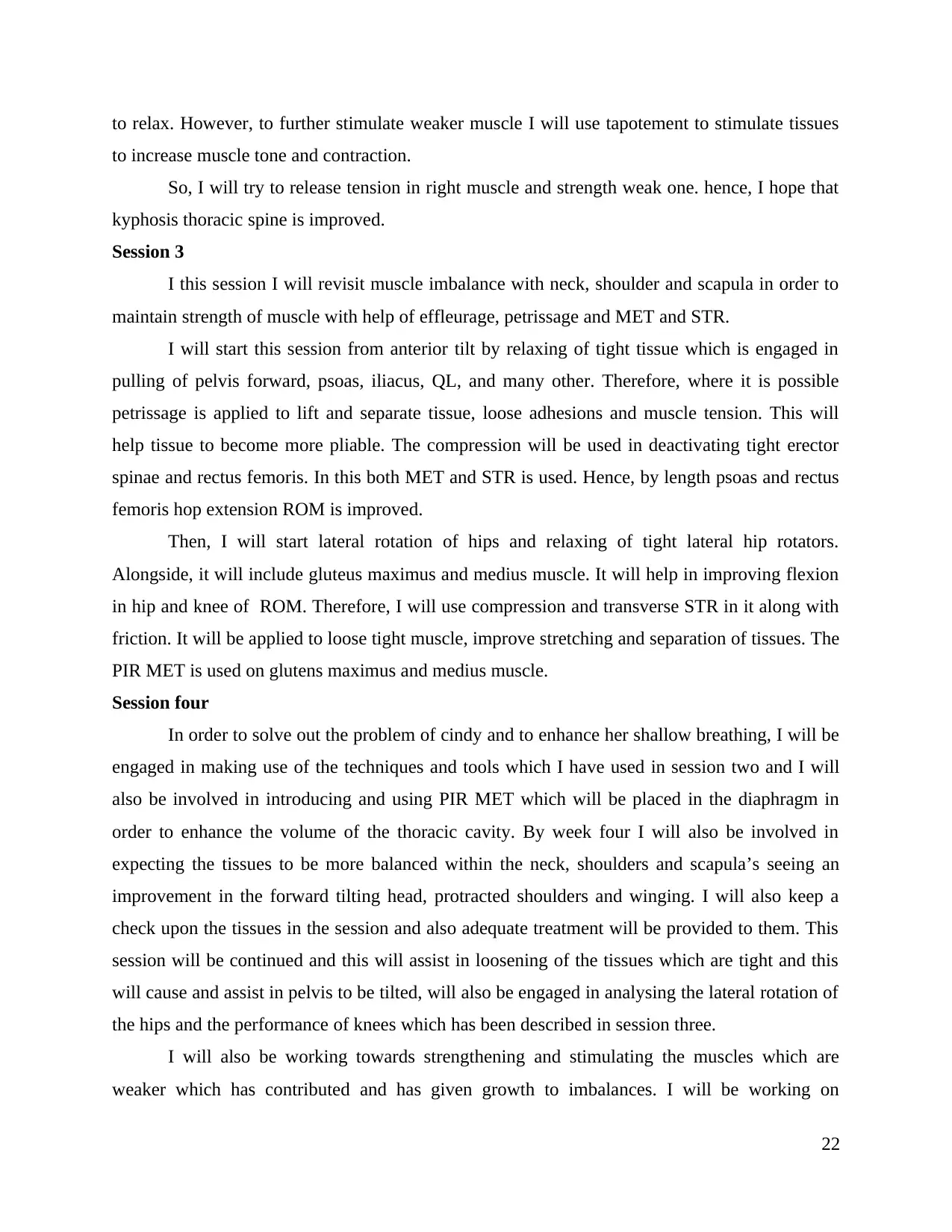
to relax. However, to further stimulate weaker muscle I will use tapotement to stimulate tissues
to increase muscle tone and contraction.
So, I will try to release tension in right muscle and strength weak one. hence, I hope that
kyphosis thoracic spine is improved.
Session 3
I this session I will revisit muscle imbalance with neck, shoulder and scapula in order to
maintain strength of muscle with help of effleurage, petrissage and MET and STR.
I will start this session from anterior tilt by relaxing of tight tissue which is engaged in
pulling of pelvis forward, psoas, iliacus, QL, and many other. Therefore, where it is possible
petrissage is applied to lift and separate tissue, loose adhesions and muscle tension. This will
help tissue to become more pliable. The compression will be used in deactivating tight erector
spinae and rectus femoris. In this both MET and STR is used. Hence, by length psoas and rectus
femoris hop extension ROM is improved.
Then, I will start lateral rotation of hips and relaxing of tight lateral hip rotators.
Alongside, it will include gluteus maximus and medius muscle. It will help in improving flexion
in hip and knee of ROM. Therefore, I will use compression and transverse STR in it along with
friction. It will be applied to loose tight muscle, improve stretching and separation of tissues. The
PIR MET is used on glutens maximus and medius muscle.
Session four
In order to solve out the problem of cindy and to enhance her shallow breathing, I will be
engaged in making use of the techniques and tools which I have used in session two and I will
also be involved in introducing and using PIR MET which will be placed in the diaphragm in
order to enhance the volume of the thoracic cavity. By week four I will also be involved in
expecting the tissues to be more balanced within the neck, shoulders and scapula’s seeing an
improvement in the forward tilting head, protracted shoulders and winging. I will also keep a
check upon the tissues in the session and also adequate treatment will be provided to them. This
session will be continued and this will assist in loosening of the tissues which are tight and this
will cause and assist in pelvis to be tilted, will also be engaged in analysing the lateral rotation of
the hips and the performance of knees which has been described in session three.
I will also be working towards strengthening and stimulating the muscles which are
weaker which has contributed and has given growth to imbalances. I will be working on
22
to increase muscle tone and contraction.
So, I will try to release tension in right muscle and strength weak one. hence, I hope that
kyphosis thoracic spine is improved.
Session 3
I this session I will revisit muscle imbalance with neck, shoulder and scapula in order to
maintain strength of muscle with help of effleurage, petrissage and MET and STR.
I will start this session from anterior tilt by relaxing of tight tissue which is engaged in
pulling of pelvis forward, psoas, iliacus, QL, and many other. Therefore, where it is possible
petrissage is applied to lift and separate tissue, loose adhesions and muscle tension. This will
help tissue to become more pliable. The compression will be used in deactivating tight erector
spinae and rectus femoris. In this both MET and STR is used. Hence, by length psoas and rectus
femoris hop extension ROM is improved.
Then, I will start lateral rotation of hips and relaxing of tight lateral hip rotators.
Alongside, it will include gluteus maximus and medius muscle. It will help in improving flexion
in hip and knee of ROM. Therefore, I will use compression and transverse STR in it along with
friction. It will be applied to loose tight muscle, improve stretching and separation of tissues. The
PIR MET is used on glutens maximus and medius muscle.
Session four
In order to solve out the problem of cindy and to enhance her shallow breathing, I will be
engaged in making use of the techniques and tools which I have used in session two and I will
also be involved in introducing and using PIR MET which will be placed in the diaphragm in
order to enhance the volume of the thoracic cavity. By week four I will also be involved in
expecting the tissues to be more balanced within the neck, shoulders and scapula’s seeing an
improvement in the forward tilting head, protracted shoulders and winging. I will also keep a
check upon the tissues in the session and also adequate treatment will be provided to them. This
session will be continued and this will assist in loosening of the tissues which are tight and this
will cause and assist in pelvis to be tilted, will also be engaged in analysing the lateral rotation of
the hips and the performance of knees which has been described in session three.
I will also be working towards strengthening and stimulating the muscles which are
weaker which has contributed and has given growth to imbalances. I will be working on
22
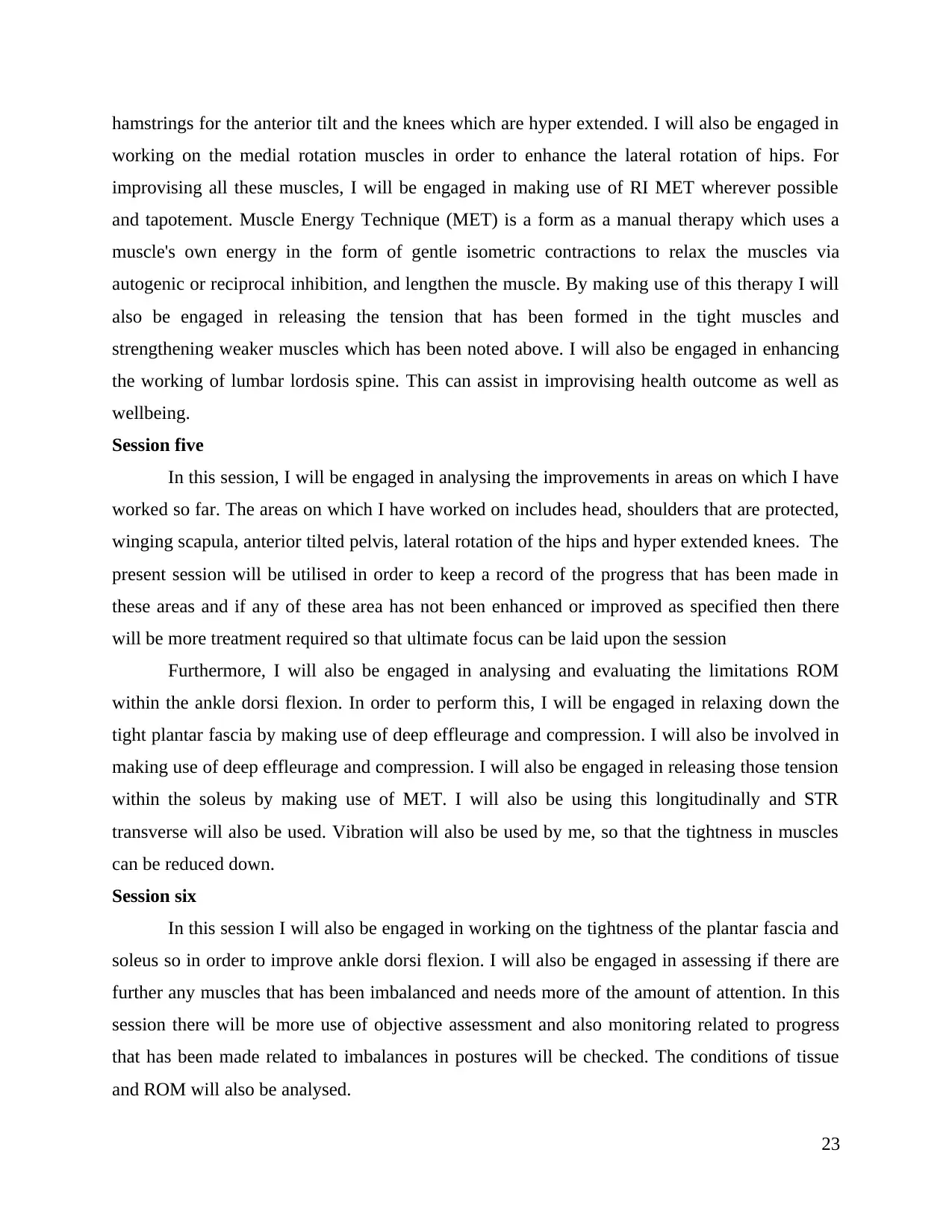
hamstrings for the anterior tilt and the knees which are hyper extended. I will also be engaged in
working on the medial rotation muscles in order to enhance the lateral rotation of hips. For
improvising all these muscles, I will be engaged in making use of RI MET wherever possible
and tapotement. Muscle Energy Technique (MET) is a form as a manual therapy which uses a
muscle's own energy in the form of gentle isometric contractions to relax the muscles via
autogenic or reciprocal inhibition, and lengthen the muscle. By making use of this therapy I will
also be engaged in releasing the tension that has been formed in the tight muscles and
strengthening weaker muscles which has been noted above. I will also be engaged in enhancing
the working of lumbar lordosis spine. This can assist in improvising health outcome as well as
wellbeing.
Session five
In this session, I will be engaged in analysing the improvements in areas on which I have
worked so far. The areas on which I have worked on includes head, shoulders that are protected,
winging scapula, anterior tilted pelvis, lateral rotation of the hips and hyper extended knees. The
present session will be utilised in order to keep a record of the progress that has been made in
these areas and if any of these area has not been enhanced or improved as specified then there
will be more treatment required so that ultimate focus can be laid upon the session
Furthermore, I will also be engaged in analysing and evaluating the limitations ROM
within the ankle dorsi flexion. In order to perform this, I will be engaged in relaxing down the
tight plantar fascia by making use of deep effleurage and compression. I will also be involved in
making use of deep effleurage and compression. I will also be engaged in releasing those tension
within the soleus by making use of MET. I will also be using this longitudinally and STR
transverse will also be used. Vibration will also be used by me, so that the tightness in muscles
can be reduced down.
Session six
In this session I will also be engaged in working on the tightness of the plantar fascia and
soleus so in order to improve ankle dorsi flexion. I will also be engaged in assessing if there are
further any muscles that has been imbalanced and needs more of the amount of attention. In this
session there will be more use of objective assessment and also monitoring related to progress
that has been made related to imbalances in postures will be checked. The conditions of tissue
and ROM will also be analysed.
23
working on the medial rotation muscles in order to enhance the lateral rotation of hips. For
improvising all these muscles, I will be engaged in making use of RI MET wherever possible
and tapotement. Muscle Energy Technique (MET) is a form as a manual therapy which uses a
muscle's own energy in the form of gentle isometric contractions to relax the muscles via
autogenic or reciprocal inhibition, and lengthen the muscle. By making use of this therapy I will
also be engaged in releasing the tension that has been formed in the tight muscles and
strengthening weaker muscles which has been noted above. I will also be engaged in enhancing
the working of lumbar lordosis spine. This can assist in improvising health outcome as well as
wellbeing.
Session five
In this session, I will be engaged in analysing the improvements in areas on which I have
worked so far. The areas on which I have worked on includes head, shoulders that are protected,
winging scapula, anterior tilted pelvis, lateral rotation of the hips and hyper extended knees. The
present session will be utilised in order to keep a record of the progress that has been made in
these areas and if any of these area has not been enhanced or improved as specified then there
will be more treatment required so that ultimate focus can be laid upon the session
Furthermore, I will also be engaged in analysing and evaluating the limitations ROM
within the ankle dorsi flexion. In order to perform this, I will be engaged in relaxing down the
tight plantar fascia by making use of deep effleurage and compression. I will also be involved in
making use of deep effleurage and compression. I will also be engaged in releasing those tension
within the soleus by making use of MET. I will also be using this longitudinally and STR
transverse will also be used. Vibration will also be used by me, so that the tightness in muscles
can be reduced down.
Session six
In this session I will also be engaged in working on the tightness of the plantar fascia and
soleus so in order to improve ankle dorsi flexion. I will also be engaged in assessing if there are
further any muscles that has been imbalanced and needs more of the amount of attention. In this
session there will be more use of objective assessment and also monitoring related to progress
that has been made related to imbalances in postures will be checked. The conditions of tissue
and ROM will also be analysed.
23
Paraphrase This Document
Need a fresh take? Get an instant paraphrase of this document with our AI Paraphraser
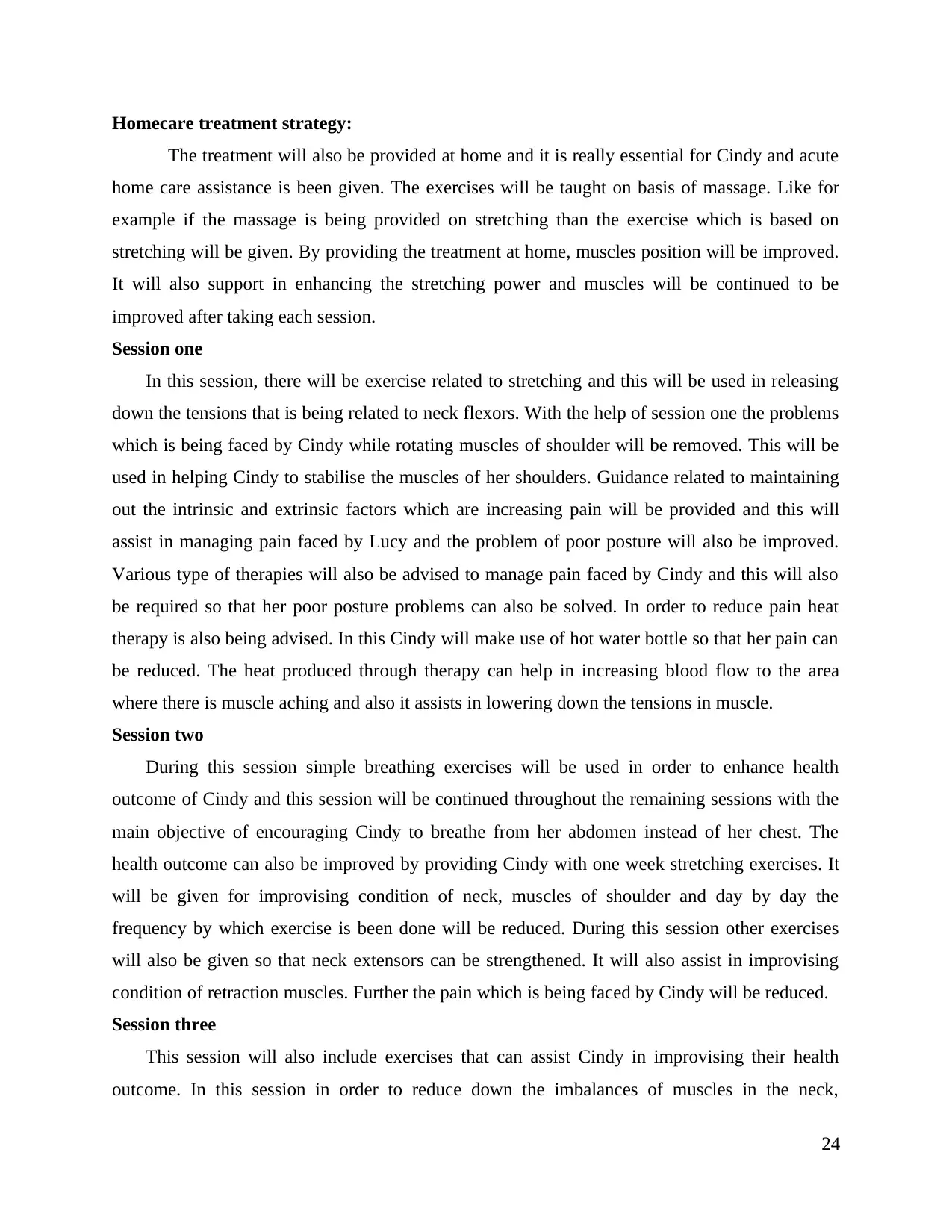
Homecare treatment strategy:
The treatment will also be provided at home and it is really essential for Cindy and acute
home care assistance is been given. The exercises will be taught on basis of massage. Like for
example if the massage is being provided on stretching than the exercise which is based on
stretching will be given. By providing the treatment at home, muscles position will be improved.
It will also support in enhancing the stretching power and muscles will be continued to be
improved after taking each session.
Session one
In this session, there will be exercise related to stretching and this will be used in releasing
down the tensions that is being related to neck flexors. With the help of session one the problems
which is being faced by Cindy while rotating muscles of shoulder will be removed. This will be
used in helping Cindy to stabilise the muscles of her shoulders. Guidance related to maintaining
out the intrinsic and extrinsic factors which are increasing pain will be provided and this will
assist in managing pain faced by Lucy and the problem of poor posture will also be improved.
Various type of therapies will also be advised to manage pain faced by Cindy and this will also
be required so that her poor posture problems can also be solved. In order to reduce pain heat
therapy is also being advised. In this Cindy will make use of hot water bottle so that her pain can
be reduced. The heat produced through therapy can help in increasing blood flow to the area
where there is muscle aching and also it assists in lowering down the tensions in muscle.
Session two
During this session simple breathing exercises will be used in order to enhance health
outcome of Cindy and this session will be continued throughout the remaining sessions with the
main objective of encouraging Cindy to breathe from her abdomen instead of her chest. The
health outcome can also be improved by providing Cindy with one week stretching exercises. It
will be given for improvising condition of neck, muscles of shoulder and day by day the
frequency by which exercise is been done will be reduced. During this session other exercises
will also be given so that neck extensors can be strengthened. It will also assist in improvising
condition of retraction muscles. Further the pain which is being faced by Cindy will be reduced.
Session three
This session will also include exercises that can assist Cindy in improvising their health
outcome. In this session in order to reduce down the imbalances of muscles in the neck,
24
The treatment will also be provided at home and it is really essential for Cindy and acute
home care assistance is been given. The exercises will be taught on basis of massage. Like for
example if the massage is being provided on stretching than the exercise which is based on
stretching will be given. By providing the treatment at home, muscles position will be improved.
It will also support in enhancing the stretching power and muscles will be continued to be
improved after taking each session.
Session one
In this session, there will be exercise related to stretching and this will be used in releasing
down the tensions that is being related to neck flexors. With the help of session one the problems
which is being faced by Cindy while rotating muscles of shoulder will be removed. This will be
used in helping Cindy to stabilise the muscles of her shoulders. Guidance related to maintaining
out the intrinsic and extrinsic factors which are increasing pain will be provided and this will
assist in managing pain faced by Lucy and the problem of poor posture will also be improved.
Various type of therapies will also be advised to manage pain faced by Cindy and this will also
be required so that her poor posture problems can also be solved. In order to reduce pain heat
therapy is also being advised. In this Cindy will make use of hot water bottle so that her pain can
be reduced. The heat produced through therapy can help in increasing blood flow to the area
where there is muscle aching and also it assists in lowering down the tensions in muscle.
Session two
During this session simple breathing exercises will be used in order to enhance health
outcome of Cindy and this session will be continued throughout the remaining sessions with the
main objective of encouraging Cindy to breathe from her abdomen instead of her chest. The
health outcome can also be improved by providing Cindy with one week stretching exercises. It
will be given for improvising condition of neck, muscles of shoulder and day by day the
frequency by which exercise is been done will be reduced. During this session other exercises
will also be given so that neck extensors can be strengthened. It will also assist in improvising
condition of retraction muscles. Further the pain which is being faced by Cindy will be reduced.
Session three
This session will also include exercises that can assist Cindy in improvising their health
outcome. In this session in order to reduce down the imbalances of muscles in the neck,
24
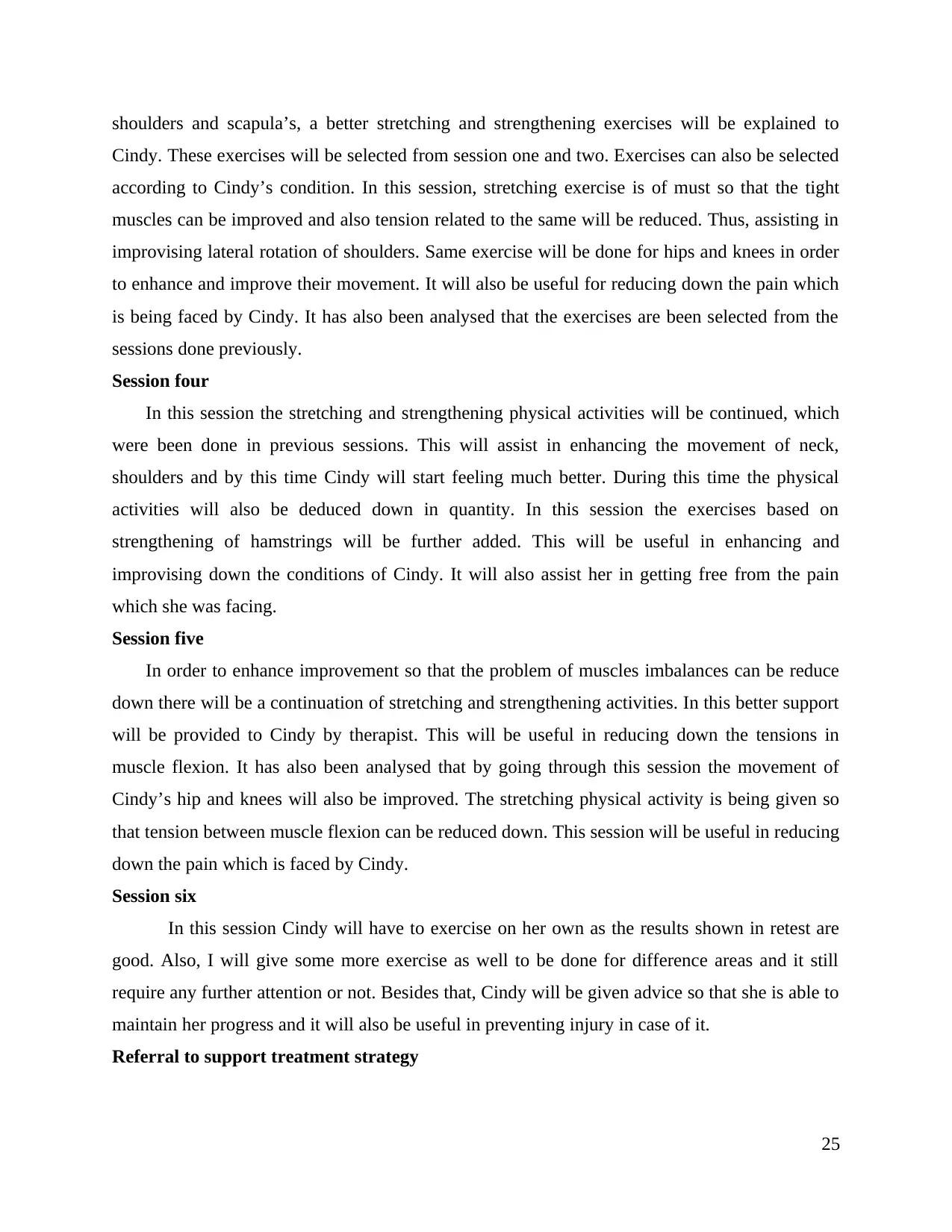
shoulders and scapula’s, a better stretching and strengthening exercises will be explained to
Cindy. These exercises will be selected from session one and two. Exercises can also be selected
according to Cindy’s condition. In this session, stretching exercise is of must so that the tight
muscles can be improved and also tension related to the same will be reduced. Thus, assisting in
improvising lateral rotation of shoulders. Same exercise will be done for hips and knees in order
to enhance and improve their movement. It will also be useful for reducing down the pain which
is being faced by Cindy. It has also been analysed that the exercises are been selected from the
sessions done previously.
Session four
In this session the stretching and strengthening physical activities will be continued, which
were been done in previous sessions. This will assist in enhancing the movement of neck,
shoulders and by this time Cindy will start feeling much better. During this time the physical
activities will also be deduced down in quantity. In this session the exercises based on
strengthening of hamstrings will be further added. This will be useful in enhancing and
improvising down the conditions of Cindy. It will also assist her in getting free from the pain
which she was facing.
Session five
In order to enhance improvement so that the problem of muscles imbalances can be reduce
down there will be a continuation of stretching and strengthening activities. In this better support
will be provided to Cindy by therapist. This will be useful in reducing down the tensions in
muscle flexion. It has also been analysed that by going through this session the movement of
Cindy’s hip and knees will also be improved. The stretching physical activity is being given so
that tension between muscle flexion can be reduced down. This session will be useful in reducing
down the pain which is faced by Cindy.
Session six
In this session Cindy will have to exercise on her own as the results shown in retest are
good. Also, I will give some more exercise as well to be done for difference areas and it still
require any further attention or not. Besides that, Cindy will be given advice so that she is able to
maintain her progress and it will also be useful in preventing injury in case of it.
Referral to support treatment strategy
25
Cindy. These exercises will be selected from session one and two. Exercises can also be selected
according to Cindy’s condition. In this session, stretching exercise is of must so that the tight
muscles can be improved and also tension related to the same will be reduced. Thus, assisting in
improvising lateral rotation of shoulders. Same exercise will be done for hips and knees in order
to enhance and improve their movement. It will also be useful for reducing down the pain which
is being faced by Cindy. It has also been analysed that the exercises are been selected from the
sessions done previously.
Session four
In this session the stretching and strengthening physical activities will be continued, which
were been done in previous sessions. This will assist in enhancing the movement of neck,
shoulders and by this time Cindy will start feeling much better. During this time the physical
activities will also be deduced down in quantity. In this session the exercises based on
strengthening of hamstrings will be further added. This will be useful in enhancing and
improvising down the conditions of Cindy. It will also assist her in getting free from the pain
which she was facing.
Session five
In order to enhance improvement so that the problem of muscles imbalances can be reduce
down there will be a continuation of stretching and strengthening activities. In this better support
will be provided to Cindy by therapist. This will be useful in reducing down the tensions in
muscle flexion. It has also been analysed that by going through this session the movement of
Cindy’s hip and knees will also be improved. The stretching physical activity is being given so
that tension between muscle flexion can be reduced down. This session will be useful in reducing
down the pain which is faced by Cindy.
Session six
In this session Cindy will have to exercise on her own as the results shown in retest are
good. Also, I will give some more exercise as well to be done for difference areas and it still
require any further attention or not. Besides that, Cindy will be given advice so that she is able to
maintain her progress and it will also be useful in preventing injury in case of it.
Referral to support treatment strategy
25
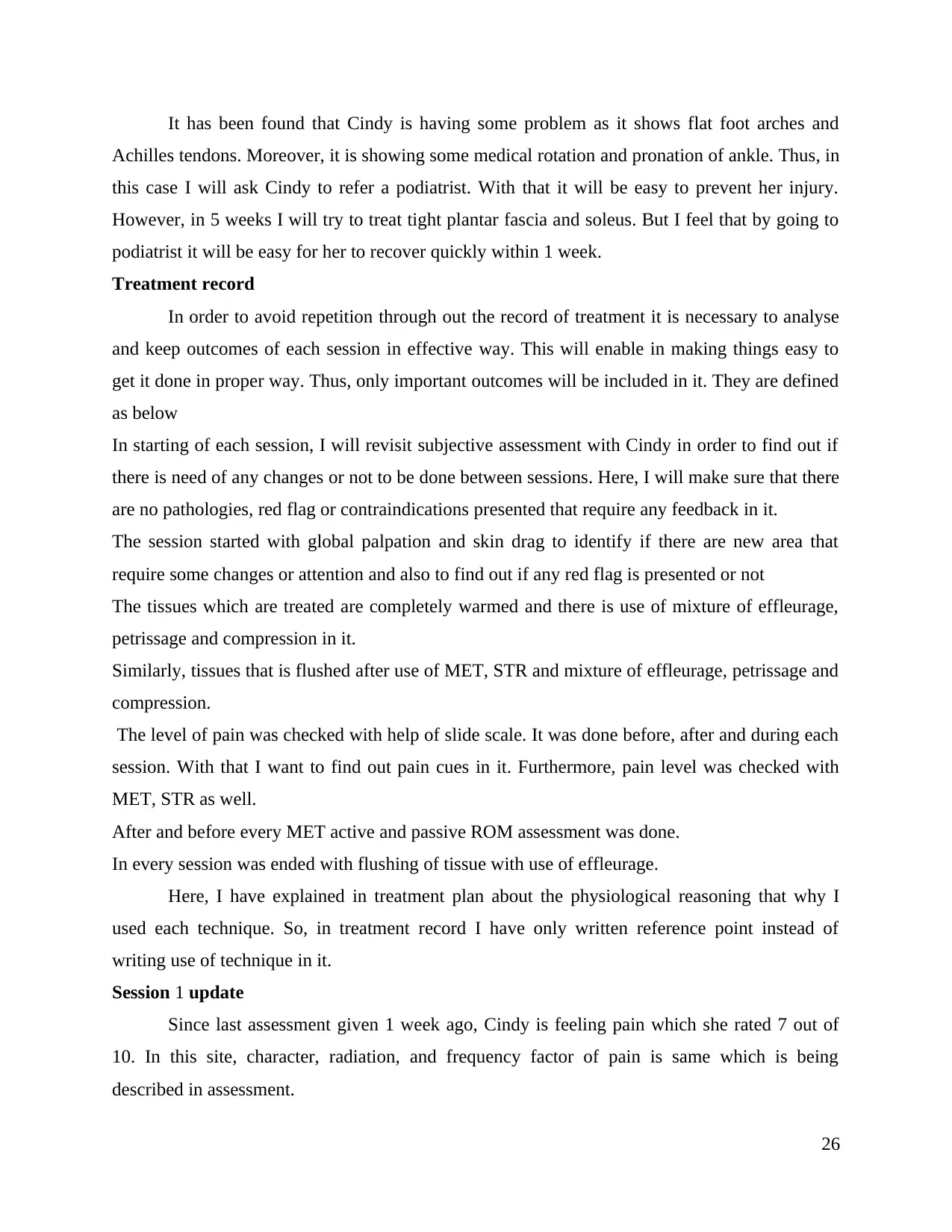
It has been found that Cindy is having some problem as it shows flat foot arches and
Achilles tendons. Moreover, it is showing some medical rotation and pronation of ankle. Thus, in
this case I will ask Cindy to refer a podiatrist. With that it will be easy to prevent her injury.
However, in 5 weeks I will try to treat tight plantar fascia and soleus. But I feel that by going to
podiatrist it will be easy for her to recover quickly within 1 week.
Treatment record
In order to avoid repetition through out the record of treatment it is necessary to analyse
and keep outcomes of each session in effective way. This will enable in making things easy to
get it done in proper way. Thus, only important outcomes will be included in it. They are defined
as below
In starting of each session, I will revisit subjective assessment with Cindy in order to find out if
there is need of any changes or not to be done between sessions. Here, I will make sure that there
are no pathologies, red flag or contraindications presented that require any feedback in it.
The session started with global palpation and skin drag to identify if there are new area that
require some changes or attention and also to find out if any red flag is presented or not
The tissues which are treated are completely warmed and there is use of mixture of effleurage,
petrissage and compression in it.
Similarly, tissues that is flushed after use of MET, STR and mixture of effleurage, petrissage and
compression.
The level of pain was checked with help of slide scale. It was done before, after and during each
session. With that I want to find out pain cues in it. Furthermore, pain level was checked with
MET, STR as well.
After and before every MET active and passive ROM assessment was done.
In every session was ended with flushing of tissue with use of effleurage.
Here, I have explained in treatment plan about the physiological reasoning that why I
used each technique. So, in treatment record I have only written reference point instead of
writing use of technique in it.
Session 1 update
Since last assessment given 1 week ago, Cindy is feeling pain which she rated 7 out of
10. In this site, character, radiation, and frequency factor of pain is same which is being
described in assessment.
26
Achilles tendons. Moreover, it is showing some medical rotation and pronation of ankle. Thus, in
this case I will ask Cindy to refer a podiatrist. With that it will be easy to prevent her injury.
However, in 5 weeks I will try to treat tight plantar fascia and soleus. But I feel that by going to
podiatrist it will be easy for her to recover quickly within 1 week.
Treatment record
In order to avoid repetition through out the record of treatment it is necessary to analyse
and keep outcomes of each session in effective way. This will enable in making things easy to
get it done in proper way. Thus, only important outcomes will be included in it. They are defined
as below
In starting of each session, I will revisit subjective assessment with Cindy in order to find out if
there is need of any changes or not to be done between sessions. Here, I will make sure that there
are no pathologies, red flag or contraindications presented that require any feedback in it.
The session started with global palpation and skin drag to identify if there are new area that
require some changes or attention and also to find out if any red flag is presented or not
The tissues which are treated are completely warmed and there is use of mixture of effleurage,
petrissage and compression in it.
Similarly, tissues that is flushed after use of MET, STR and mixture of effleurage, petrissage and
compression.
The level of pain was checked with help of slide scale. It was done before, after and during each
session. With that I want to find out pain cues in it. Furthermore, pain level was checked with
MET, STR as well.
After and before every MET active and passive ROM assessment was done.
In every session was ended with flushing of tissue with use of effleurage.
Here, I have explained in treatment plan about the physiological reasoning that why I
used each technique. So, in treatment record I have only written reference point instead of
writing use of technique in it.
Session 1 update
Since last assessment given 1 week ago, Cindy is feeling pain which she rated 7 out of
10. In this site, character, radiation, and frequency factor of pain is same which is being
described in assessment.
26
Secure Best Marks with AI Grader
Need help grading? Try our AI Grader for instant feedback on your assignments.

Session 1 treatment
The treatment was beginning in Cindy with prone, folded towels was placed under each
shoulder for comfort and its position was in neutral. This allowed in having better access to
tissues.
Here, main purpose was to reduce pain of Cindy I did start with longitudinal effleurage.
For that I used palm of my hand and working from iliac creates at controlled speed to upper
trapezius muscle. It included the posterior of arm and forearm as well. Thus, a pain test was done
on medical border of right scapula. Here, rating of pain was 7 so I compressed point for 10
seconds and this resulted in reduction of pain to 4. So, I was highly delighted with it.
Now, in order to enhance quality of ischemic tissues I did deeper effleurage in that area
with my forearm. This resulted in use of longitudinal and transverse petrissage. I kept in mind
about the depth to keep stroked in light due to pain. Hence, for that I used compression to heal
my hand to trapezius, rhomboids, infraspinatus and other muscle. Therefore, pain check was
done as I got to know that I can push tissue into bone. So, in this all I was looking to trigger any
point to be formed around ischemic tissue and at last none was found in it.
Then, Cindy turned into supine and effleurage was done over pectoralis with use of may
palm of hand working from sternum outward and down anterior surface of arm and forearm by
using long slow stroke. So, once getting warm and deeper assist finger stroked was applied. In
this stage tissue quality did not felt any difference from assessment session done.
In next stage I want to address muscle imbalance within neck, shoulder and scapula by
lengthening tight and short muscle using PIR MET. For that I explained to Cindy about use of
this and also discussed entire process as well. With that she understood her involvement so that
stretch can be finished in it.
In order to reduce tightness of neck flexor, PIR MET was done on both
sternocleidomastoid muscle and scalene. The left and right flexion ROM, neck extension was
enhanced after passive and active movement and also tissues felt was less tight in it.
Similarly, to reduce tightness of medical rotation shoulder muscle PIR MET was done on
both pectoralis minor muscle. Cindy was placed in side lying to access latissimus dorsi and teres
muscle and also to perform PIR MET test. Then, I asked her to bend arm and place hand on side
of head. With that I can perform PIR MET on her pectoralis muscle. But Cindy found this as
uncomfortable as she was feeling no pain due to stretch of tissues.
27
The treatment was beginning in Cindy with prone, folded towels was placed under each
shoulder for comfort and its position was in neutral. This allowed in having better access to
tissues.
Here, main purpose was to reduce pain of Cindy I did start with longitudinal effleurage.
For that I used palm of my hand and working from iliac creates at controlled speed to upper
trapezius muscle. It included the posterior of arm and forearm as well. Thus, a pain test was done
on medical border of right scapula. Here, rating of pain was 7 so I compressed point for 10
seconds and this resulted in reduction of pain to 4. So, I was highly delighted with it.
Now, in order to enhance quality of ischemic tissues I did deeper effleurage in that area
with my forearm. This resulted in use of longitudinal and transverse petrissage. I kept in mind
about the depth to keep stroked in light due to pain. Hence, for that I used compression to heal
my hand to trapezius, rhomboids, infraspinatus and other muscle. Therefore, pain check was
done as I got to know that I can push tissue into bone. So, in this all I was looking to trigger any
point to be formed around ischemic tissue and at last none was found in it.
Then, Cindy turned into supine and effleurage was done over pectoralis with use of may
palm of hand working from sternum outward and down anterior surface of arm and forearm by
using long slow stroke. So, once getting warm and deeper assist finger stroked was applied. In
this stage tissue quality did not felt any difference from assessment session done.
In next stage I want to address muscle imbalance within neck, shoulder and scapula by
lengthening tight and short muscle using PIR MET. For that I explained to Cindy about use of
this and also discussed entire process as well. With that she understood her involvement so that
stretch can be finished in it.
In order to reduce tightness of neck flexor, PIR MET was done on both
sternocleidomastoid muscle and scalene. The left and right flexion ROM, neck extension was
enhanced after passive and active movement and also tissues felt was less tight in it.
Similarly, to reduce tightness of medical rotation shoulder muscle PIR MET was done on
both pectoralis minor muscle. Cindy was placed in side lying to access latissimus dorsi and teres
muscle and also to perform PIR MET test. Then, I asked her to bend arm and place hand on side
of head. With that I can perform PIR MET on her pectoralis muscle. But Cindy found this as
uncomfortable as she was feeling no pain due to stretch of tissues.
27
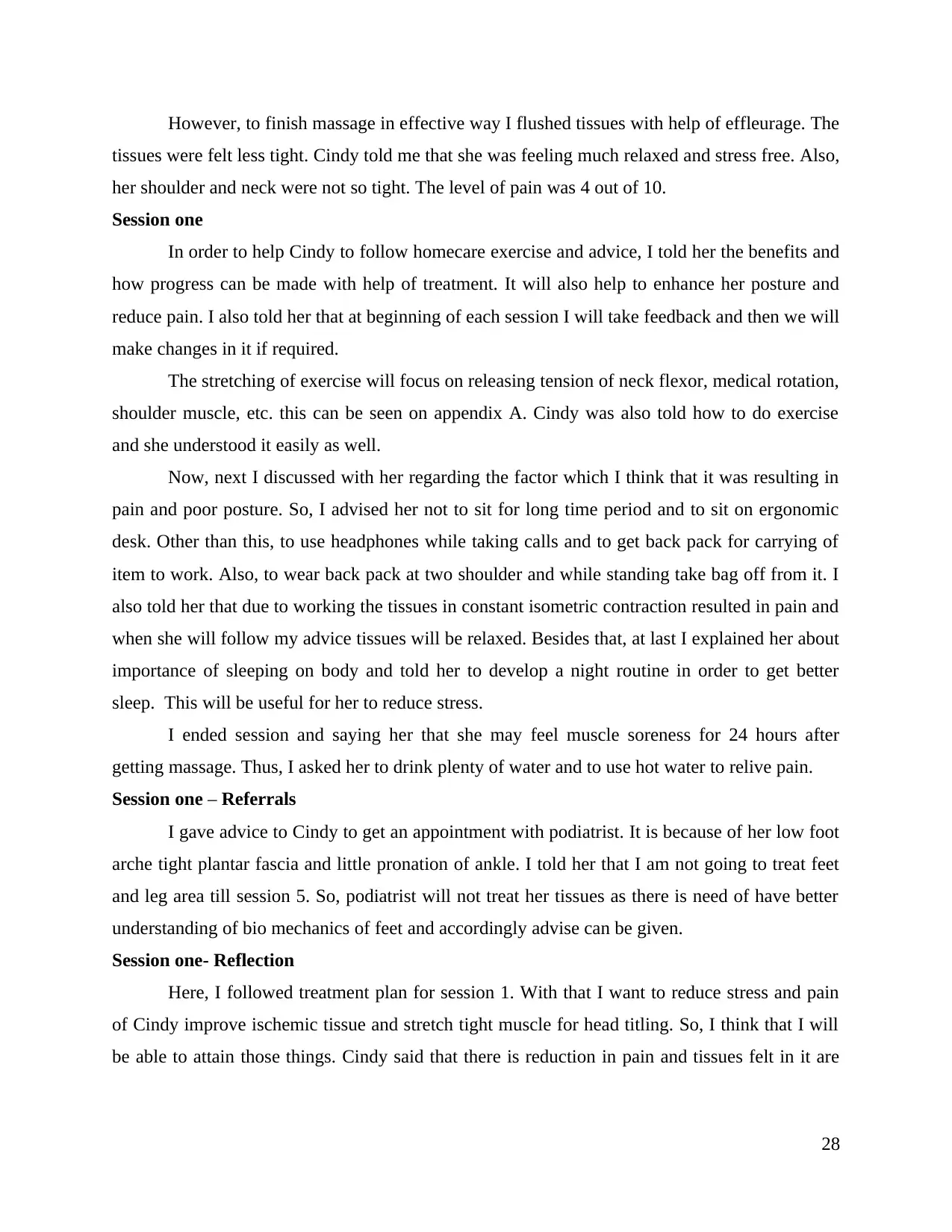
However, to finish massage in effective way I flushed tissues with help of effleurage. The
tissues were felt less tight. Cindy told me that she was feeling much relaxed and stress free. Also,
her shoulder and neck were not so tight. The level of pain was 4 out of 10.
Session one
In order to help Cindy to follow homecare exercise and advice, I told her the benefits and
how progress can be made with help of treatment. It will also help to enhance her posture and
reduce pain. I also told her that at beginning of each session I will take feedback and then we will
make changes in it if required.
The stretching of exercise will focus on releasing tension of neck flexor, medical rotation,
shoulder muscle, etc. this can be seen on appendix A. Cindy was also told how to do exercise
and she understood it easily as well.
Now, next I discussed with her regarding the factor which I think that it was resulting in
pain and poor posture. So, I advised her not to sit for long time period and to sit on ergonomic
desk. Other than this, to use headphones while taking calls and to get back pack for carrying of
item to work. Also, to wear back pack at two shoulder and while standing take bag off from it. I
also told her that due to working the tissues in constant isometric contraction resulted in pain and
when she will follow my advice tissues will be relaxed. Besides that, at last I explained her about
importance of sleeping on body and told her to develop a night routine in order to get better
sleep. This will be useful for her to reduce stress.
I ended session and saying her that she may feel muscle soreness for 24 hours after
getting massage. Thus, I asked her to drink plenty of water and to use hot water to relive pain.
Session one – Referrals
I gave advice to Cindy to get an appointment with podiatrist. It is because of her low foot
arche tight plantar fascia and little pronation of ankle. I told her that I am not going to treat feet
and leg area till session 5. So, podiatrist will not treat her tissues as there is need of have better
understanding of bio mechanics of feet and accordingly advise can be given.
Session one- Reflection
Here, I followed treatment plan for session 1. With that I want to reduce stress and pain
of Cindy improve ischemic tissue and stretch tight muscle for head titling. So, I think that I will
be able to attain those things. Cindy said that there is reduction in pain and tissues felt in it are
28
tissues were felt less tight. Cindy told me that she was feeling much relaxed and stress free. Also,
her shoulder and neck were not so tight. The level of pain was 4 out of 10.
Session one
In order to help Cindy to follow homecare exercise and advice, I told her the benefits and
how progress can be made with help of treatment. It will also help to enhance her posture and
reduce pain. I also told her that at beginning of each session I will take feedback and then we will
make changes in it if required.
The stretching of exercise will focus on releasing tension of neck flexor, medical rotation,
shoulder muscle, etc. this can be seen on appendix A. Cindy was also told how to do exercise
and she understood it easily as well.
Now, next I discussed with her regarding the factor which I think that it was resulting in
pain and poor posture. So, I advised her not to sit for long time period and to sit on ergonomic
desk. Other than this, to use headphones while taking calls and to get back pack for carrying of
item to work. Also, to wear back pack at two shoulder and while standing take bag off from it. I
also told her that due to working the tissues in constant isometric contraction resulted in pain and
when she will follow my advice tissues will be relaxed. Besides that, at last I explained her about
importance of sleeping on body and told her to develop a night routine in order to get better
sleep. This will be useful for her to reduce stress.
I ended session and saying her that she may feel muscle soreness for 24 hours after
getting massage. Thus, I asked her to drink plenty of water and to use hot water to relive pain.
Session one – Referrals
I gave advice to Cindy to get an appointment with podiatrist. It is because of her low foot
arche tight plantar fascia and little pronation of ankle. I told her that I am not going to treat feet
and leg area till session 5. So, podiatrist will not treat her tissues as there is need of have better
understanding of bio mechanics of feet and accordingly advise can be given.
Session one- Reflection
Here, I followed treatment plan for session 1. With that I want to reduce stress and pain
of Cindy improve ischemic tissue and stretch tight muscle for head titling. So, I think that I will
be able to attain those things. Cindy said that there is reduction in pain and tissues felt in it are
28
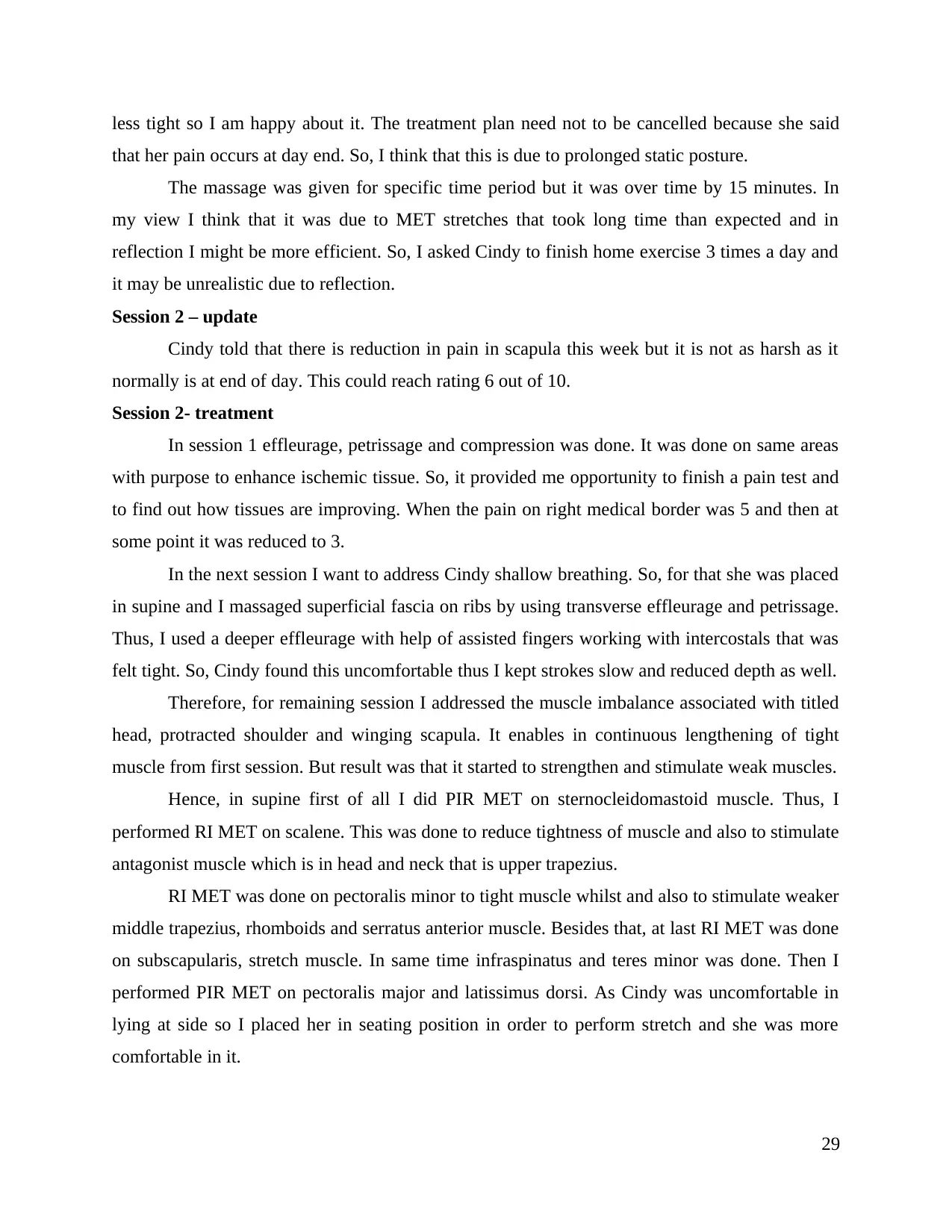
less tight so I am happy about it. The treatment plan need not to be cancelled because she said
that her pain occurs at day end. So, I think that this is due to prolonged static posture.
The massage was given for specific time period but it was over time by 15 minutes. In
my view I think that it was due to MET stretches that took long time than expected and in
reflection I might be more efficient. So, I asked Cindy to finish home exercise 3 times a day and
it may be unrealistic due to reflection.
Session 2 – update
Cindy told that there is reduction in pain in scapula this week but it is not as harsh as it
normally is at end of day. This could reach rating 6 out of 10.
Session 2- treatment
In session 1 effleurage, petrissage and compression was done. It was done on same areas
with purpose to enhance ischemic tissue. So, it provided me opportunity to finish a pain test and
to find out how tissues are improving. When the pain on right medical border was 5 and then at
some point it was reduced to 3.
In the next session I want to address Cindy shallow breathing. So, for that she was placed
in supine and I massaged superficial fascia on ribs by using transverse effleurage and petrissage.
Thus, I used a deeper effleurage with help of assisted fingers working with intercostals that was
felt tight. So, Cindy found this uncomfortable thus I kept strokes slow and reduced depth as well.
Therefore, for remaining session I addressed the muscle imbalance associated with titled
head, protracted shoulder and winging scapula. It enables in continuous lengthening of tight
muscle from first session. But result was that it started to strengthen and stimulate weak muscles.
Hence, in supine first of all I did PIR MET on sternocleidomastoid muscle. Thus, I
performed RI MET on scalene. This was done to reduce tightness of muscle and also to stimulate
antagonist muscle which is in head and neck that is upper trapezius.
RI MET was done on pectoralis minor to tight muscle whilst and also to stimulate weaker
middle trapezius, rhomboids and serratus anterior muscle. Besides that, at last RI MET was done
on subscapularis, stretch muscle. In same time infraspinatus and teres minor was done. Then I
performed PIR MET on pectoralis major and latissimus dorsi. As Cindy was uncomfortable in
lying at side so I placed her in seating position in order to perform stretch and she was more
comfortable in it.
29
that her pain occurs at day end. So, I think that this is due to prolonged static posture.
The massage was given for specific time period but it was over time by 15 minutes. In
my view I think that it was due to MET stretches that took long time than expected and in
reflection I might be more efficient. So, I asked Cindy to finish home exercise 3 times a day and
it may be unrealistic due to reflection.
Session 2 – update
Cindy told that there is reduction in pain in scapula this week but it is not as harsh as it
normally is at end of day. This could reach rating 6 out of 10.
Session 2- treatment
In session 1 effleurage, petrissage and compression was done. It was done on same areas
with purpose to enhance ischemic tissue. So, it provided me opportunity to finish a pain test and
to find out how tissues are improving. When the pain on right medical border was 5 and then at
some point it was reduced to 3.
In the next session I want to address Cindy shallow breathing. So, for that she was placed
in supine and I massaged superficial fascia on ribs by using transverse effleurage and petrissage.
Thus, I used a deeper effleurage with help of assisted fingers working with intercostals that was
felt tight. So, Cindy found this uncomfortable thus I kept strokes slow and reduced depth as well.
Therefore, for remaining session I addressed the muscle imbalance associated with titled
head, protracted shoulder and winging scapula. It enables in continuous lengthening of tight
muscle from first session. But result was that it started to strengthen and stimulate weak muscles.
Hence, in supine first of all I did PIR MET on sternocleidomastoid muscle. Thus, I
performed RI MET on scalene. This was done to reduce tightness of muscle and also to stimulate
antagonist muscle which is in head and neck that is upper trapezius.
RI MET was done on pectoralis minor to tight muscle whilst and also to stimulate weaker
middle trapezius, rhomboids and serratus anterior muscle. Besides that, at last RI MET was done
on subscapularis, stretch muscle. In same time infraspinatus and teres minor was done. Then I
performed PIR MET on pectoralis major and latissimus dorsi. As Cindy was uncomfortable in
lying at side so I placed her in seating position in order to perform stretch and she was more
comfortable in it.
29
Paraphrase This Document
Need a fresh take? Get an instant paraphrase of this document with our AI Paraphraser
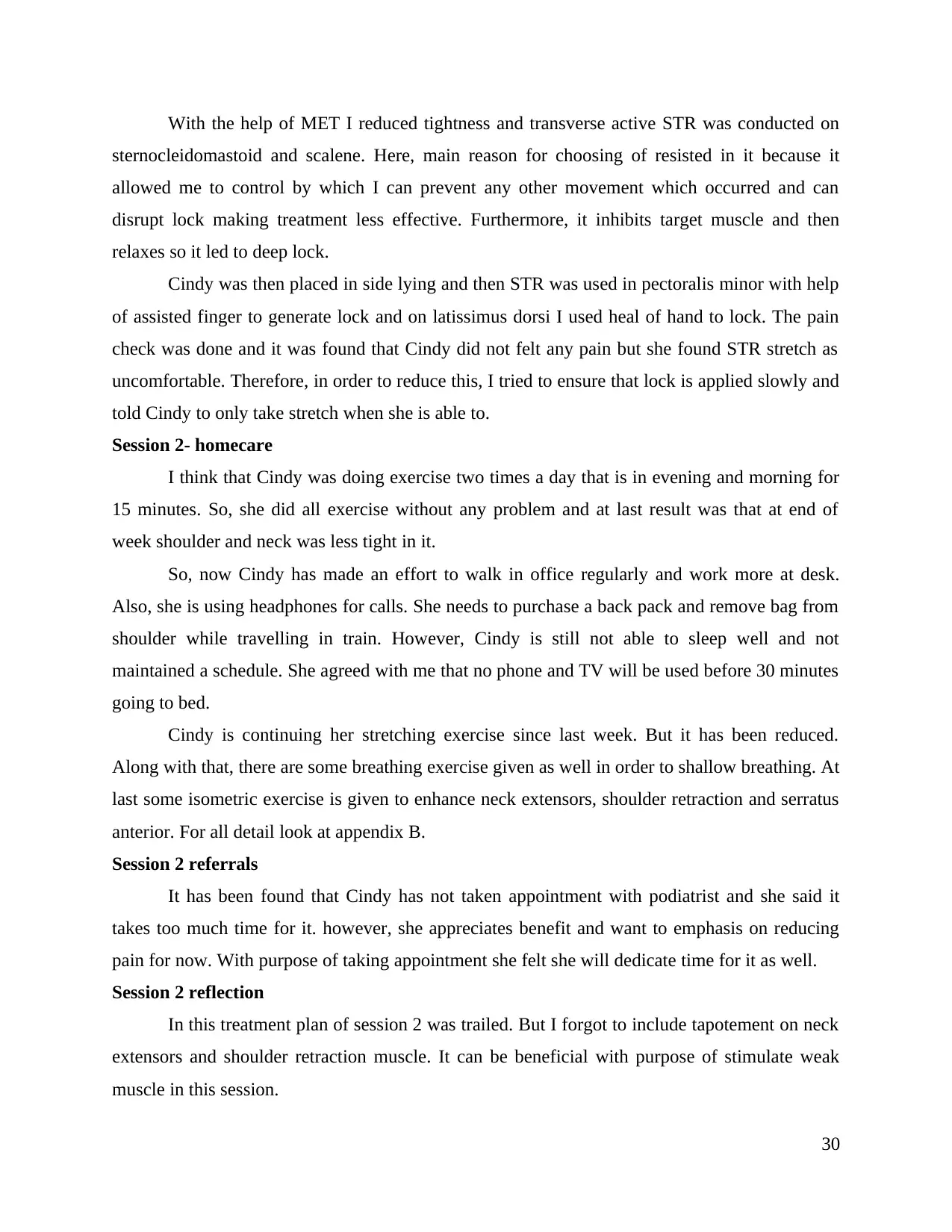
With the help of MET I reduced tightness and transverse active STR was conducted on
sternocleidomastoid and scalene. Here, main reason for choosing of resisted in it because it
allowed me to control by which I can prevent any other movement which occurred and can
disrupt lock making treatment less effective. Furthermore, it inhibits target muscle and then
relaxes so it led to deep lock.
Cindy was then placed in side lying and then STR was used in pectoralis minor with help
of assisted finger to generate lock and on latissimus dorsi I used heal of hand to lock. The pain
check was done and it was found that Cindy did not felt any pain but she found STR stretch as
uncomfortable. Therefore, in order to reduce this, I tried to ensure that lock is applied slowly and
told Cindy to only take stretch when she is able to.
Session 2- homecare
I think that Cindy was doing exercise two times a day that is in evening and morning for
15 minutes. So, she did all exercise without any problem and at last result was that at end of
week shoulder and neck was less tight in it.
So, now Cindy has made an effort to walk in office regularly and work more at desk.
Also, she is using headphones for calls. She needs to purchase a back pack and remove bag from
shoulder while travelling in train. However, Cindy is still not able to sleep well and not
maintained a schedule. She agreed with me that no phone and TV will be used before 30 minutes
going to bed.
Cindy is continuing her stretching exercise since last week. But it has been reduced.
Along with that, there are some breathing exercise given as well in order to shallow breathing. At
last some isometric exercise is given to enhance neck extensors, shoulder retraction and serratus
anterior. For all detail look at appendix B.
Session 2 referrals
It has been found that Cindy has not taken appointment with podiatrist and she said it
takes too much time for it. however, she appreciates benefit and want to emphasis on reducing
pain for now. With purpose of taking appointment she felt she will dedicate time for it as well.
Session 2 reflection
In this treatment plan of session 2 was trailed. But I forgot to include tapotement on neck
extensors and shoulder retraction muscle. It can be beneficial with purpose of stimulate weak
muscle in this session.
30
sternocleidomastoid and scalene. Here, main reason for choosing of resisted in it because it
allowed me to control by which I can prevent any other movement which occurred and can
disrupt lock making treatment less effective. Furthermore, it inhibits target muscle and then
relaxes so it led to deep lock.
Cindy was then placed in side lying and then STR was used in pectoralis minor with help
of assisted finger to generate lock and on latissimus dorsi I used heal of hand to lock. The pain
check was done and it was found that Cindy did not felt any pain but she found STR stretch as
uncomfortable. Therefore, in order to reduce this, I tried to ensure that lock is applied slowly and
told Cindy to only take stretch when she is able to.
Session 2- homecare
I think that Cindy was doing exercise two times a day that is in evening and morning for
15 minutes. So, she did all exercise without any problem and at last result was that at end of
week shoulder and neck was less tight in it.
So, now Cindy has made an effort to walk in office regularly and work more at desk.
Also, she is using headphones for calls. She needs to purchase a back pack and remove bag from
shoulder while travelling in train. However, Cindy is still not able to sleep well and not
maintained a schedule. She agreed with me that no phone and TV will be used before 30 minutes
going to bed.
Cindy is continuing her stretching exercise since last week. But it has been reduced.
Along with that, there are some breathing exercise given as well in order to shallow breathing. At
last some isometric exercise is given to enhance neck extensors, shoulder retraction and serratus
anterior. For all detail look at appendix B.
Session 2 referrals
It has been found that Cindy has not taken appointment with podiatrist and she said it
takes too much time for it. however, she appreciates benefit and want to emphasis on reducing
pain for now. With purpose of taking appointment she felt she will dedicate time for it as well.
Session 2 reflection
In this treatment plan of session 2 was trailed. But I forgot to include tapotement on neck
extensors and shoulder retraction muscle. It can be beneficial with purpose of stimulate weak
muscle in this session.
30

So, I am delighted that there is tissue improvement and anterior of neck, pictorials and
latissimus is relaxed and less rigid. I think these outcomes are due to following and doing of
home care exercise and making changes in working. Also, it is because of use of MET and STR.
In present session I managed my time and included an advance MET and STR technique in an
hour. Thus, in 2 week time I am able to attain my short term goals and there is reduction in pain
as well. so, both sessions are focusing on bringing improvement in ischemic tissue and apart
from that both intrinsic and extrinsic factor are considered as well. In reflection I may have
included various positions that will be useful in reducing stress in neck flexors and petrolic
muscle and decrease in pain around scapula as well.
Session 3 update
It has been analysed that there is decrease in pain in Cindy this week but at end of week
the level of pain has reduced to 3 as compared to 6 out of 10. However, pain is only being felt I
superior and inferior angle of scapula.
So, as her pain was decreased, I want to reassess posture and retest ROM to neck and
shoulders. Also, it has been found that her head is not titled far forward and shoulder is less
protracted. Furthermore, both scapula angle is now level in that. Besides that, muscle mass
between scapula is not improved to that extent and there is still winging present in it. I found that
even after 2 weeks of homecare I did not expect tissue development to such extent. The shoulder
extension on ROM was 35 degree on left and right. However, by doing retest it was improved to
40 degrees on left and 45 degree on right. In addition to it, neck extension ROM was to 55 as
compared to 45 degrees. Other than this, lateral flexion of neck was 25 on left and right this was
improved to 40 on left and 45 on right side. So, with all these outcomes we both were happy and
started to address other areas as well.
Session 3- treatment
As Cindy pain is decreased and test outcome of ROM is improved. So I want to check
quality of tissue in areas such as neck, shoulder and scapula with help of effleurage and
palpation. The muscle which felt relaxed was scalene, pectoralis, latissimus dorsi, etc. the
trapezius and rhomboid muscle was highly structured and less stringy. In that specifically upper
trapezius was less fibrous. However, in order to enhance quality of tissues I decided to do
petrissage and compression on these areas. With that muscle mass between scapula was
31
latissimus is relaxed and less rigid. I think these outcomes are due to following and doing of
home care exercise and making changes in working. Also, it is because of use of MET and STR.
In present session I managed my time and included an advance MET and STR technique in an
hour. Thus, in 2 week time I am able to attain my short term goals and there is reduction in pain
as well. so, both sessions are focusing on bringing improvement in ischemic tissue and apart
from that both intrinsic and extrinsic factor are considered as well. In reflection I may have
included various positions that will be useful in reducing stress in neck flexors and petrolic
muscle and decrease in pain around scapula as well.
Session 3 update
It has been analysed that there is decrease in pain in Cindy this week but at end of week
the level of pain has reduced to 3 as compared to 6 out of 10. However, pain is only being felt I
superior and inferior angle of scapula.
So, as her pain was decreased, I want to reassess posture and retest ROM to neck and
shoulders. Also, it has been found that her head is not titled far forward and shoulder is less
protracted. Furthermore, both scapula angle is now level in that. Besides that, muscle mass
between scapula is not improved to that extent and there is still winging present in it. I found that
even after 2 weeks of homecare I did not expect tissue development to such extent. The shoulder
extension on ROM was 35 degree on left and right. However, by doing retest it was improved to
40 degrees on left and 45 degree on right. In addition to it, neck extension ROM was to 55 as
compared to 45 degrees. Other than this, lateral flexion of neck was 25 on left and right this was
improved to 40 on left and 45 on right side. So, with all these outcomes we both were happy and
started to address other areas as well.
Session 3- treatment
As Cindy pain is decreased and test outcome of ROM is improved. So I want to check
quality of tissue in areas such as neck, shoulder and scapula with help of effleurage and
palpation. The muscle which felt relaxed was scalene, pectoralis, latissimus dorsi, etc. the
trapezius and rhomboid muscle was highly structured and less stringy. In that specifically upper
trapezius was less fibrous. However, in order to enhance quality of tissues I decided to do
petrissage and compression on these areas. With that muscle mass between scapula was
31

decreased so I used cupping tapotement. This was done to stimulate muscle from iliac create and
upper trapezius.
Hence, for rest session we decided to address anterior pelvis tilt and lateral rotation of
hips and extended knees by loosing of tight muscle. The tissue of lumbar and hamstring region
was warm. Thus, transverse STR was done on QL by one hand to attain lock and other to rotate
pelvis to make sure that there is complete stretch done. The STR was done on lumbar erector
spinae with Cindy anteriorly tilt her pelvis to do stretch, thus tissues were felt soft.
With help of compression gluteal muscle was warmed with heal of hand and forearm.
Tissues in it was congested hence I used friction by using assisted fingers in order to break
adhesion. But Cindy found it uncomfortable so I stopped this and did gluteal in that session.
Then, Cindy was placed in supine and quadricep muscle was warmed as compared to
hamstring muscle mass was more. Then, PIR MET was done to stretch QL. So, to return to
gluteal muscle and stress free I did PIR MET. Cindy found that Medius stretch is highly intense
as compared to maximus.
Then, I asked Cindy to lay side and perform active transverse STR on gluteal muscle with
forearm. This was done to obtain lock and deep lateral hip rotators with thumb. As she was not
feeling comfortable when I used friction so I did it slowly into tissues to complete each lock and
checking of pain as well. hence, these was useful in feeling less congested of gluteal muscle but
it required more work to be done in it.
Session 3: Homecare
Cindy is being involved in doing the exercise, she is involved in completing physical
activities twice a day. It was being analysed that Cindy was facing difficulty in doing isometric
serratus anterior exercise and has stopped doing this exercise during mid-week, so we agreed to
move forward and also I have made sure that no such exercise was repeated in future.
It was also being analysed that Cindy has not yet started her breathing exercises and she
has also not created proper night routine. But she was making sure that changes she brought to
her working environment is been maintained and also now she has even purchased a backpack
for herself. This has made a huge difference in her life.
32
upper trapezius.
Hence, for rest session we decided to address anterior pelvis tilt and lateral rotation of
hips and extended knees by loosing of tight muscle. The tissue of lumbar and hamstring region
was warm. Thus, transverse STR was done on QL by one hand to attain lock and other to rotate
pelvis to make sure that there is complete stretch done. The STR was done on lumbar erector
spinae with Cindy anteriorly tilt her pelvis to do stretch, thus tissues were felt soft.
With help of compression gluteal muscle was warmed with heal of hand and forearm.
Tissues in it was congested hence I used friction by using assisted fingers in order to break
adhesion. But Cindy found it uncomfortable so I stopped this and did gluteal in that session.
Then, Cindy was placed in supine and quadricep muscle was warmed as compared to
hamstring muscle mass was more. Then, PIR MET was done to stretch QL. So, to return to
gluteal muscle and stress free I did PIR MET. Cindy found that Medius stretch is highly intense
as compared to maximus.
Then, I asked Cindy to lay side and perform active transverse STR on gluteal muscle with
forearm. This was done to obtain lock and deep lateral hip rotators with thumb. As she was not
feeling comfortable when I used friction so I did it slowly into tissues to complete each lock and
checking of pain as well. hence, these was useful in feeling less congested of gluteal muscle but
it required more work to be done in it.
Session 3: Homecare
Cindy is being involved in doing the exercise, she is involved in completing physical
activities twice a day. It was being analysed that Cindy was facing difficulty in doing isometric
serratus anterior exercise and has stopped doing this exercise during mid-week, so we agreed to
move forward and also I have made sure that no such exercise was repeated in future.
It was also being analysed that Cindy has not yet started her breathing exercises and she
has also not created proper night routine. But she was making sure that changes she brought to
her working environment is been maintained and also now she has even purchased a backpack
for herself. This has made a huge difference in her life.
32
Secure Best Marks with AI Grader
Need help grading? Try our AI Grader for instant feedback on your assignments.
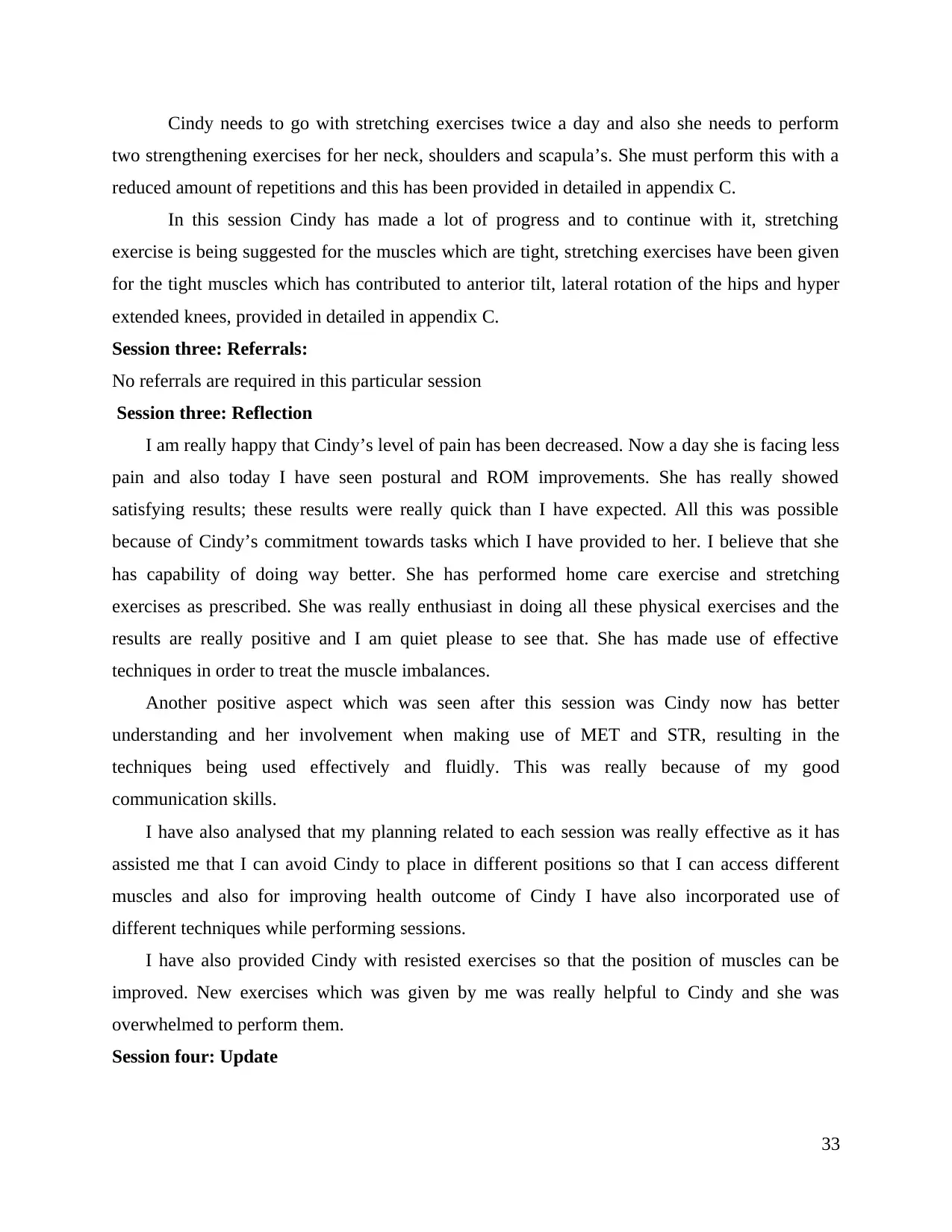
Cindy needs to go with stretching exercises twice a day and also she needs to perform
two strengthening exercises for her neck, shoulders and scapula’s. She must perform this with a
reduced amount of repetitions and this has been provided in detailed in appendix C.
In this session Cindy has made a lot of progress and to continue with it, stretching
exercise is being suggested for the muscles which are tight, stretching exercises have been given
for the tight muscles which has contributed to anterior tilt, lateral rotation of the hips and hyper
extended knees, provided in detailed in appendix C.
Session three: Referrals:
No referrals are required in this particular session
Session three: Reflection
I am really happy that Cindy’s level of pain has been decreased. Now a day she is facing less
pain and also today I have seen postural and ROM improvements. She has really showed
satisfying results; these results were really quick than I have expected. All this was possible
because of Cindy’s commitment towards tasks which I have provided to her. I believe that she
has capability of doing way better. She has performed home care exercise and stretching
exercises as prescribed. She was really enthusiast in doing all these physical exercises and the
results are really positive and I am quiet please to see that. She has made use of effective
techniques in order to treat the muscle imbalances.
Another positive aspect which was seen after this session was Cindy now has better
understanding and her involvement when making use of MET and STR, resulting in the
techniques being used effectively and fluidly. This was really because of my good
communication skills.
I have also analysed that my planning related to each session was really effective as it has
assisted me that I can avoid Cindy to place in different positions so that I can access different
muscles and also for improving health outcome of Cindy I have also incorporated use of
different techniques while performing sessions.
I have also provided Cindy with resisted exercises so that the position of muscles can be
improved. New exercises which was given by me was really helpful to Cindy and she was
overwhelmed to perform them.
Session four: Update
33
two strengthening exercises for her neck, shoulders and scapula’s. She must perform this with a
reduced amount of repetitions and this has been provided in detailed in appendix C.
In this session Cindy has made a lot of progress and to continue with it, stretching
exercise is being suggested for the muscles which are tight, stretching exercises have been given
for the tight muscles which has contributed to anterior tilt, lateral rotation of the hips and hyper
extended knees, provided in detailed in appendix C.
Session three: Referrals:
No referrals are required in this particular session
Session three: Reflection
I am really happy that Cindy’s level of pain has been decreased. Now a day she is facing less
pain and also today I have seen postural and ROM improvements. She has really showed
satisfying results; these results were really quick than I have expected. All this was possible
because of Cindy’s commitment towards tasks which I have provided to her. I believe that she
has capability of doing way better. She has performed home care exercise and stretching
exercises as prescribed. She was really enthusiast in doing all these physical exercises and the
results are really positive and I am quiet please to see that. She has made use of effective
techniques in order to treat the muscle imbalances.
Another positive aspect which was seen after this session was Cindy now has better
understanding and her involvement when making use of MET and STR, resulting in the
techniques being used effectively and fluidly. This was really because of my good
communication skills.
I have also analysed that my planning related to each session was really effective as it has
assisted me that I can avoid Cindy to place in different positions so that I can access different
muscles and also for improving health outcome of Cindy I have also incorporated use of
different techniques while performing sessions.
I have also provided Cindy with resisted exercises so that the position of muscles can be
improved. New exercises which was given by me was really helpful to Cindy and she was
overwhelmed to perform them.
Session four: Update
33
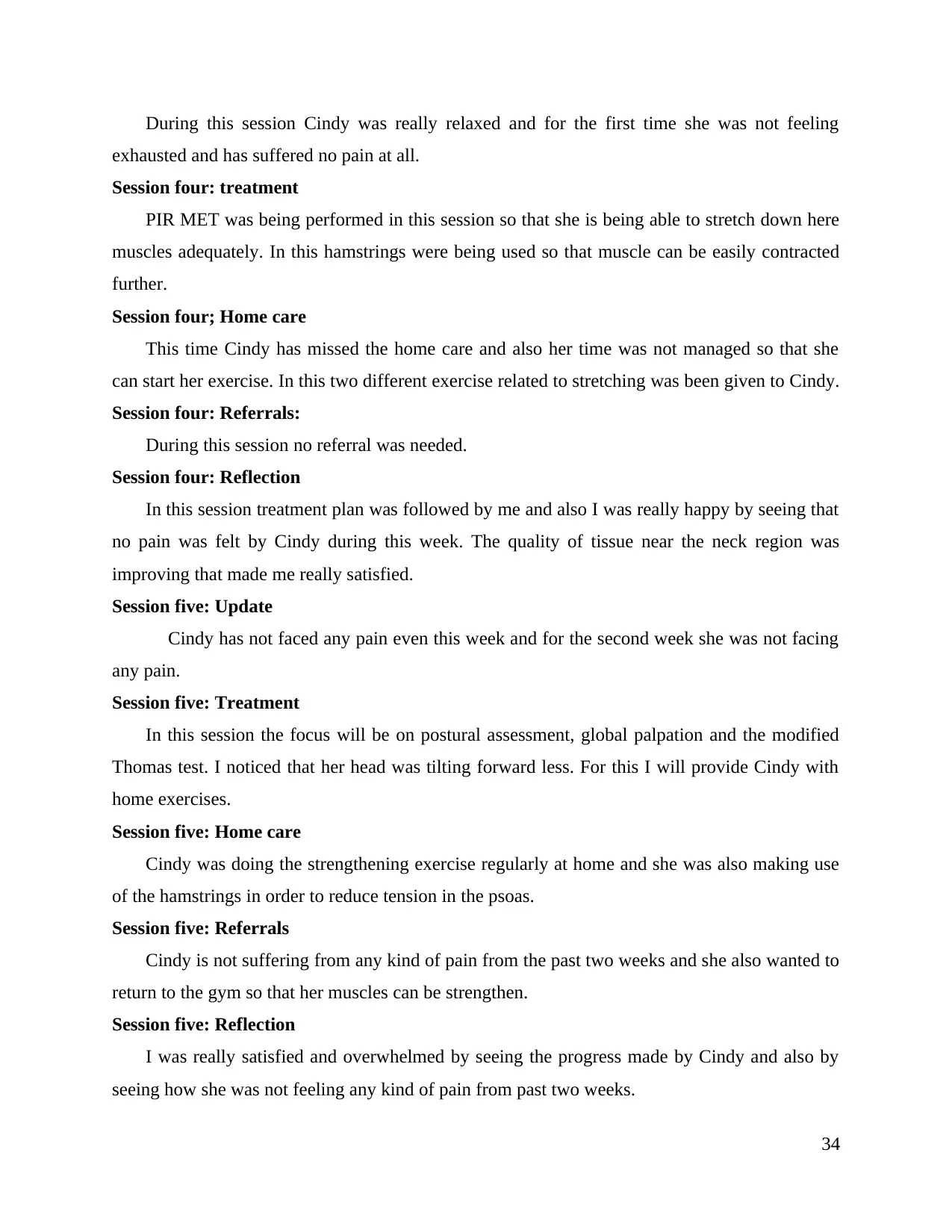
During this session Cindy was really relaxed and for the first time she was not feeling
exhausted and has suffered no pain at all.
Session four: treatment
PIR MET was being performed in this session so that she is being able to stretch down here
muscles adequately. In this hamstrings were being used so that muscle can be easily contracted
further.
Session four; Home care
This time Cindy has missed the home care and also her time was not managed so that she
can start her exercise. In this two different exercise related to stretching was been given to Cindy.
Session four: Referrals:
During this session no referral was needed.
Session four: Reflection
In this session treatment plan was followed by me and also I was really happy by seeing that
no pain was felt by Cindy during this week. The quality of tissue near the neck region was
improving that made me really satisfied.
Session five: Update
Cindy has not faced any pain even this week and for the second week she was not facing
any pain.
Session five: Treatment
In this session the focus will be on postural assessment, global palpation and the modified
Thomas test. I noticed that her head was tilting forward less. For this I will provide Cindy with
home exercises.
Session five: Home care
Cindy was doing the strengthening exercise regularly at home and she was also making use
of the hamstrings in order to reduce tension in the psoas.
Session five: Referrals
Cindy is not suffering from any kind of pain from the past two weeks and she also wanted to
return to the gym so that her muscles can be strengthen.
Session five: Reflection
I was really satisfied and overwhelmed by seeing the progress made by Cindy and also by
seeing how she was not feeling any kind of pain from past two weeks.
34
exhausted and has suffered no pain at all.
Session four: treatment
PIR MET was being performed in this session so that she is being able to stretch down here
muscles adequately. In this hamstrings were being used so that muscle can be easily contracted
further.
Session four; Home care
This time Cindy has missed the home care and also her time was not managed so that she
can start her exercise. In this two different exercise related to stretching was been given to Cindy.
Session four: Referrals:
During this session no referral was needed.
Session four: Reflection
In this session treatment plan was followed by me and also I was really happy by seeing that
no pain was felt by Cindy during this week. The quality of tissue near the neck region was
improving that made me really satisfied.
Session five: Update
Cindy has not faced any pain even this week and for the second week she was not facing
any pain.
Session five: Treatment
In this session the focus will be on postural assessment, global palpation and the modified
Thomas test. I noticed that her head was tilting forward less. For this I will provide Cindy with
home exercises.
Session five: Home care
Cindy was doing the strengthening exercise regularly at home and she was also making use
of the hamstrings in order to reduce tension in the psoas.
Session five: Referrals
Cindy is not suffering from any kind of pain from the past two weeks and she also wanted to
return to the gym so that her muscles can be strengthen.
Session five: Reflection
I was really satisfied and overwhelmed by seeing the progress made by Cindy and also by
seeing how she was not feeling any kind of pain from past two weeks.
34

Session six: update
In this session also Cindy has arrived pain free and she has not gone through any kind of
pain throughout the week.
Session six: Treatment
During this session I asked Cindy to be involved in doing all the retests so that I can analyse
progress made. I also provided her global massage during this session. To finish all of the tissues
there were flushed using effleurage, long, slow strokes were also being used so that they can
provide a relaxing end to the massage.
Session six: Homecare:
Cindy has fixed her night routine and also after being engaged in doing exercise, she felt
less stressed and also she had sound sleep and felt free from pain.
Session six: Referrals
Cindy has booked her appointment with a personal trainer and also will discuss about what
further exercise will be needed.
Session six: Reflection
I was really satisfied during this time as Cindy was to facing any kind of pain and condition
of tissues has also improved.
Post treatment Re-assessments
Postural assessment:
35
In this session also Cindy has arrived pain free and she has not gone through any kind of
pain throughout the week.
Session six: Treatment
During this session I asked Cindy to be involved in doing all the retests so that I can analyse
progress made. I also provided her global massage during this session. To finish all of the tissues
there were flushed using effleurage, long, slow strokes were also being used so that they can
provide a relaxing end to the massage.
Session six: Homecare:
Cindy has fixed her night routine and also after being engaged in doing exercise, she felt
less stressed and also she had sound sleep and felt free from pain.
Session six: Referrals
Cindy has booked her appointment with a personal trainer and also will discuss about what
further exercise will be needed.
Session six: Reflection
I was really satisfied during this time as Cindy was to facing any kind of pain and condition
of tissues has also improved.
Post treatment Re-assessments
Postural assessment:
35
Paraphrase This Document
Need a fresh take? Get an instant paraphrase of this document with our AI Paraphraser
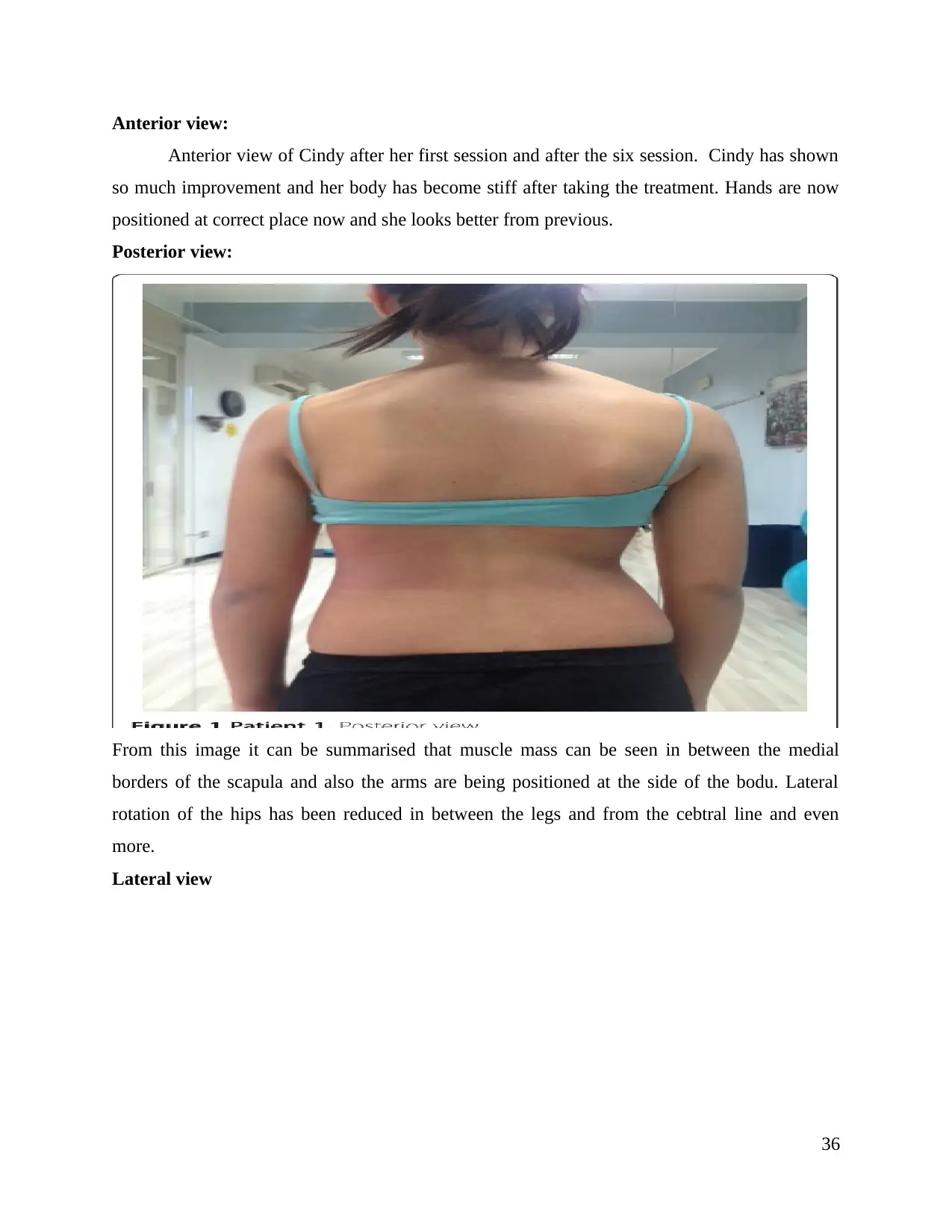
Anterior view:
Anterior view of Cindy after her first session and after the six session. Cindy has shown
so much improvement and her body has become stiff after taking the treatment. Hands are now
positioned at correct place now and she looks better from previous.
Posterior view:
From this image it can be summarised that muscle mass can be seen in between the medial
borders of the scapula and also the arms are being positioned at the side of the bodu. Lateral
rotation of the hips has been reduced in between the legs and from the cebtral line and even
more.
Lateral view
36
Anterior view of Cindy after her first session and after the six session. Cindy has shown
so much improvement and her body has become stiff after taking the treatment. Hands are now
positioned at correct place now and she looks better from previous.
Posterior view:
From this image it can be summarised that muscle mass can be seen in between the medial
borders of the scapula and also the arms are being positioned at the side of the bodu. Lateral
rotation of the hips has been reduced in between the legs and from the cebtral line and even
more.
Lateral view
36
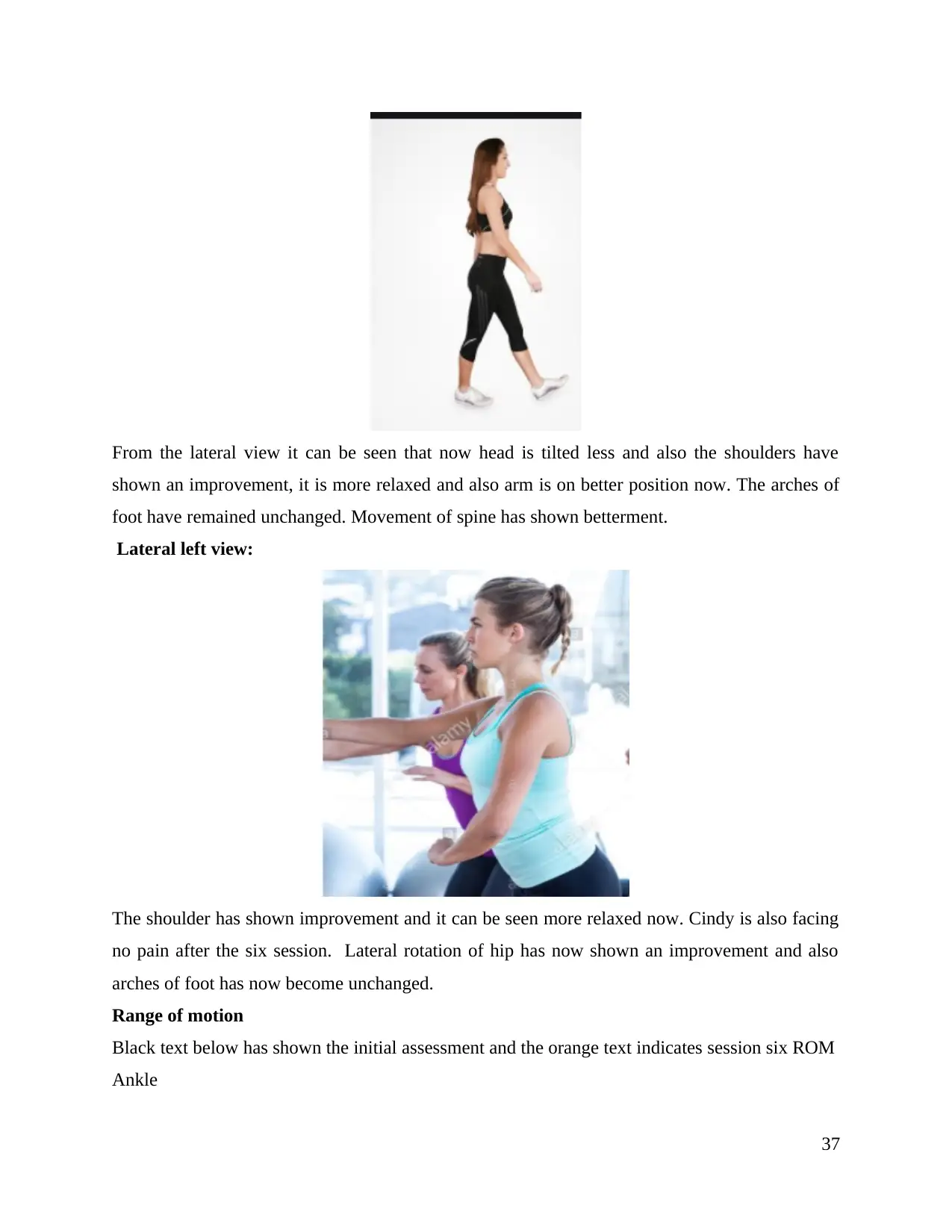
From the lateral view it can be seen that now head is tilted less and also the shoulders have
shown an improvement, it is more relaxed and also arm is on better position now. The arches of
foot have remained unchanged. Movement of spine has shown betterment.
Lateral left view:
The shoulder has shown improvement and it can be seen more relaxed now. Cindy is also facing
no pain after the six session. Lateral rotation of hip has now shown an improvement and also
arches of foot has now become unchanged.
Range of motion
Black text below has shown the initial assessment and the orange text indicates session six ROM
Ankle
37
shown an improvement, it is more relaxed and also arm is on better position now. The arches of
foot have remained unchanged. Movement of spine has shown betterment.
Lateral left view:
The shoulder has shown improvement and it can be seen more relaxed now. Cindy is also facing
no pain after the six session. Lateral rotation of hip has now shown an improvement and also
arches of foot has now become unchanged.
Range of motion
Black text below has shown the initial assessment and the orange text indicates session six ROM
Ankle
37
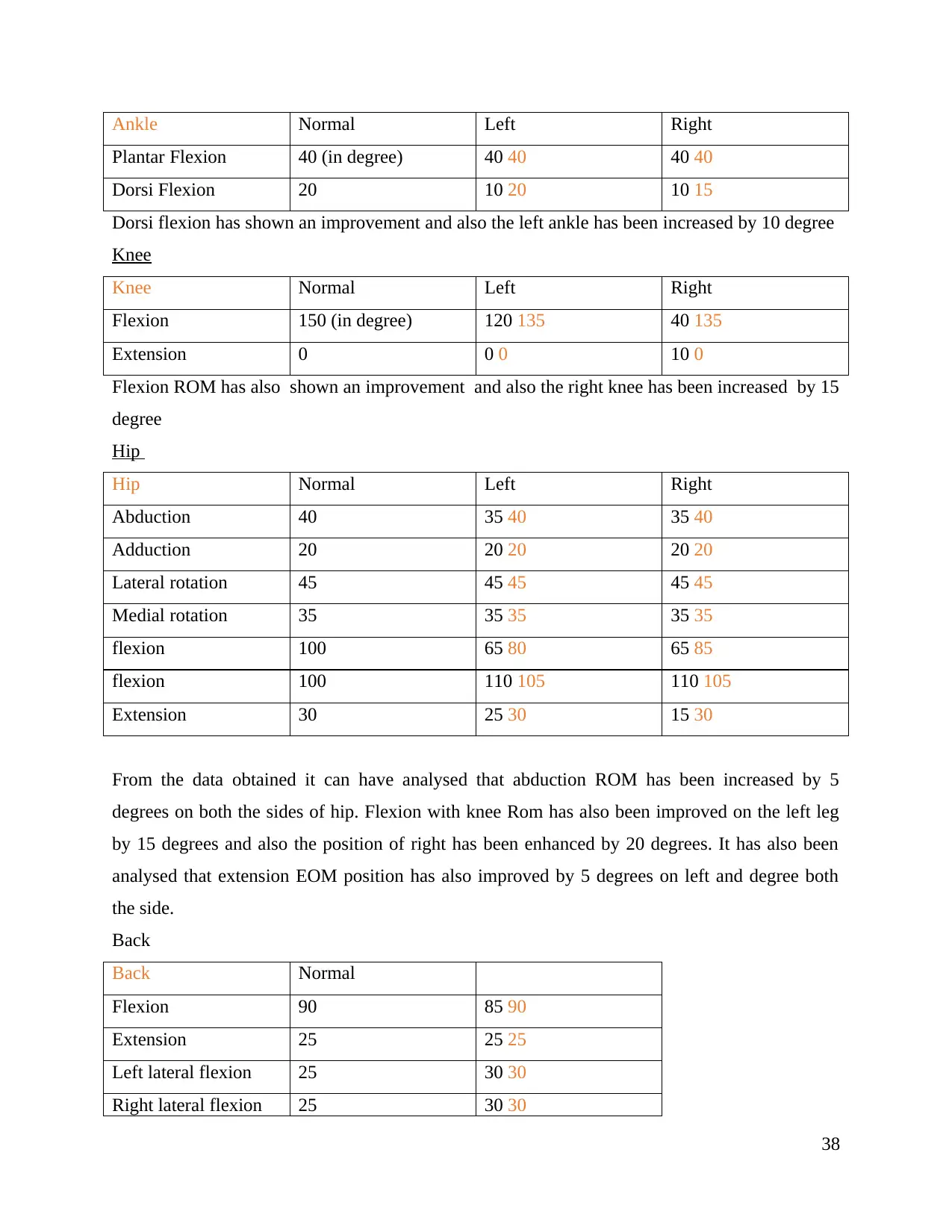
Ankle Normal Left Right
Plantar Flexion 40 (in degree) 40 40 40 40
Dorsi Flexion 20 10 20 10 15
Dorsi flexion has shown an improvement and also the left ankle has been increased by 10 degree
Knee
Knee Normal Left Right
Flexion 150 (in degree) 120 135 40 135
Extension 0 0 0 10 0
Flexion ROM has also shown an improvement and also the right knee has been increased by 15
degree
Hip
Hip Normal Left Right
Abduction 40 35 40 35 40
Adduction 20 20 20 20 20
Lateral rotation 45 45 45 45 45
Medial rotation 35 35 35 35 35
flexion 100 65 80 65 85
flexion 100 110 105 110 105
Extension 30 25 30 15 30
From the data obtained it can have analysed that abduction ROM has been increased by 5
degrees on both the sides of hip. Flexion with knee Rom has also been improved on the left leg
by 15 degrees and also the position of right has been enhanced by 20 degrees. It has also been
analysed that extension EOM position has also improved by 5 degrees on left and degree both
the side.
Back
Back Normal
Flexion 90 85 90
Extension 25 25 25
Left lateral flexion 25 30 30
Right lateral flexion 25 30 30
38
Plantar Flexion 40 (in degree) 40 40 40 40
Dorsi Flexion 20 10 20 10 15
Dorsi flexion has shown an improvement and also the left ankle has been increased by 10 degree
Knee
Knee Normal Left Right
Flexion 150 (in degree) 120 135 40 135
Extension 0 0 0 10 0
Flexion ROM has also shown an improvement and also the right knee has been increased by 15
degree
Hip
Hip Normal Left Right
Abduction 40 35 40 35 40
Adduction 20 20 20 20 20
Lateral rotation 45 45 45 45 45
Medial rotation 35 35 35 35 35
flexion 100 65 80 65 85
flexion 100 110 105 110 105
Extension 30 25 30 15 30
From the data obtained it can have analysed that abduction ROM has been increased by 5
degrees on both the sides of hip. Flexion with knee Rom has also been improved on the left leg
by 15 degrees and also the position of right has been enhanced by 20 degrees. It has also been
analysed that extension EOM position has also improved by 5 degrees on left and degree both
the side.
Back
Back Normal
Flexion 90 85 90
Extension 25 25 25
Left lateral flexion 25 30 30
Right lateral flexion 25 30 30
38
Secure Best Marks with AI Grader
Need help grading? Try our AI Grader for instant feedback on your assignments.
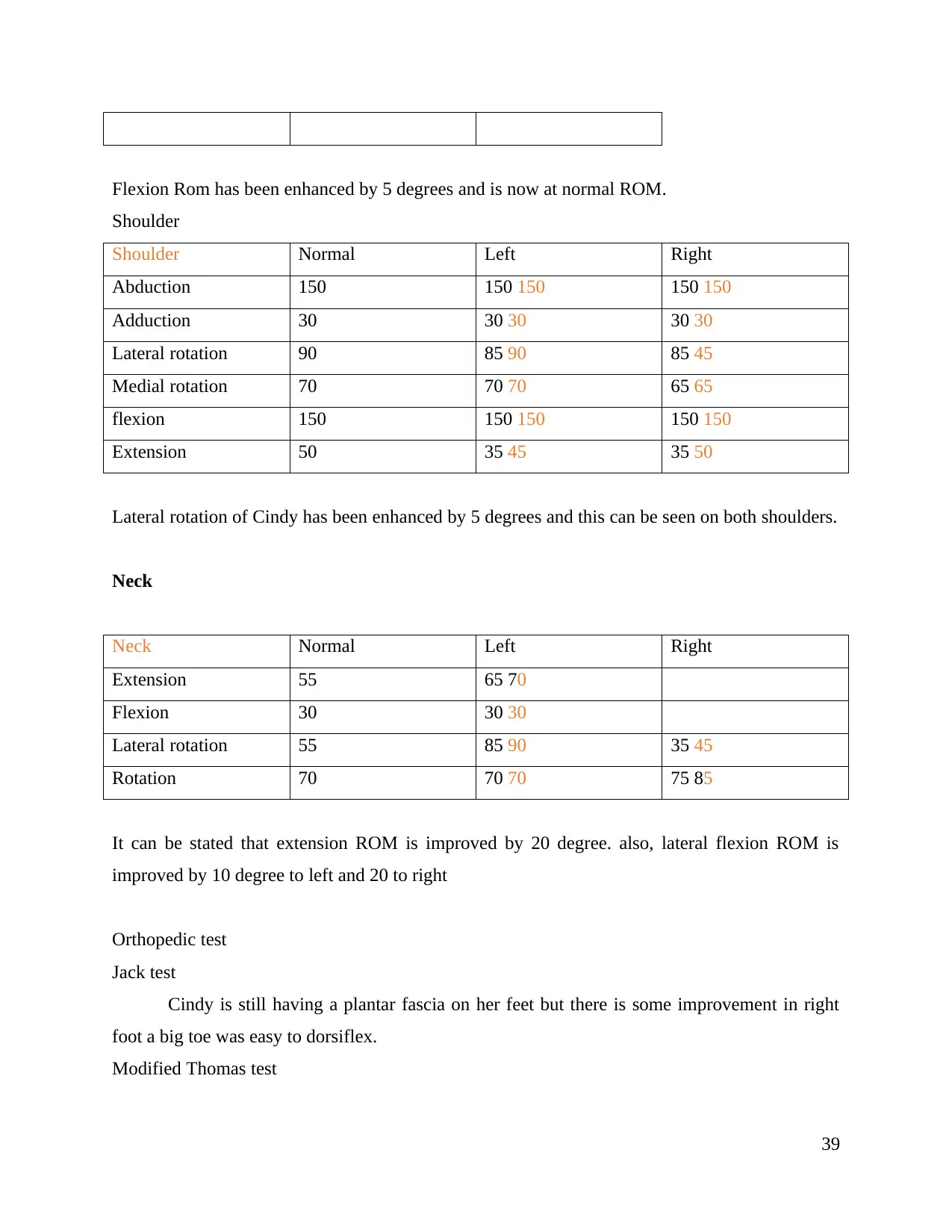
Flexion Rom has been enhanced by 5 degrees and is now at normal ROM.
Shoulder
Shoulder Normal Left Right
Abduction 150 150 150 150 150
Adduction 30 30 30 30 30
Lateral rotation 90 85 90 85 45
Medial rotation 70 70 70 65 65
flexion 150 150 150 150 150
Extension 50 35 45 35 50
Lateral rotation of Cindy has been enhanced by 5 degrees and this can be seen on both shoulders.
Neck
Neck Normal Left Right
Extension 55 65 70
Flexion 30 30 30
Lateral rotation 55 85 90 35 45
Rotation 70 70 70 75 85
It can be stated that extension ROM is improved by 20 degree. also, lateral flexion ROM is
improved by 10 degree to left and 20 to right
Orthopedic test
Jack test
Cindy is still having a plantar fascia on her feet but there is some improvement in right
foot a big toe was easy to dorsiflex.
Modified Thomas test
39
Shoulder
Shoulder Normal Left Right
Abduction 150 150 150 150 150
Adduction 30 30 30 30 30
Lateral rotation 90 85 90 85 45
Medial rotation 70 70 70 65 65
flexion 150 150 150 150 150
Extension 50 35 45 35 50
Lateral rotation of Cindy has been enhanced by 5 degrees and this can be seen on both shoulders.
Neck
Neck Normal Left Right
Extension 55 65 70
Flexion 30 30 30
Lateral rotation 55 85 90 35 45
Rotation 70 70 70 75 85
It can be stated that extension ROM is improved by 20 degree. also, lateral flexion ROM is
improved by 10 degree to left and 20 to right
Orthopedic test
Jack test
Cindy is still having a plantar fascia on her feet but there is some improvement in right
foot a big toe was easy to dorsiflex.
Modified Thomas test
39
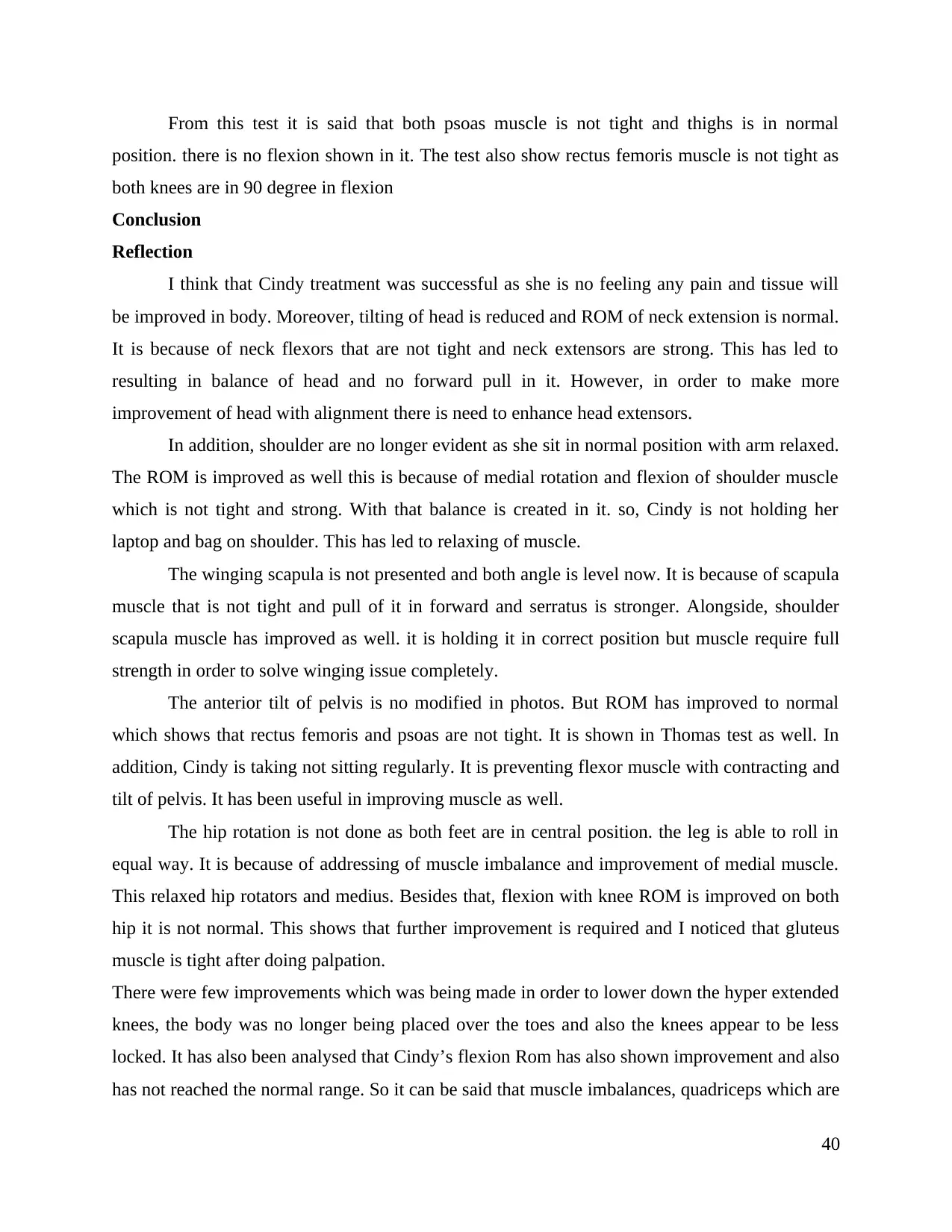
From this test it is said that both psoas muscle is not tight and thighs is in normal
position. there is no flexion shown in it. The test also show rectus femoris muscle is not tight as
both knees are in 90 degree in flexion
Conclusion
Reflection
I think that Cindy treatment was successful as she is no feeling any pain and tissue will
be improved in body. Moreover, tilting of head is reduced and ROM of neck extension is normal.
It is because of neck flexors that are not tight and neck extensors are strong. This has led to
resulting in balance of head and no forward pull in it. However, in order to make more
improvement of head with alignment there is need to enhance head extensors.
In addition, shoulder are no longer evident as she sit in normal position with arm relaxed.
The ROM is improved as well this is because of medial rotation and flexion of shoulder muscle
which is not tight and strong. With that balance is created in it. so, Cindy is not holding her
laptop and bag on shoulder. This has led to relaxing of muscle.
The winging scapula is not presented and both angle is level now. It is because of scapula
muscle that is not tight and pull of it in forward and serratus is stronger. Alongside, shoulder
scapula muscle has improved as well. it is holding it in correct position but muscle require full
strength in order to solve winging issue completely.
The anterior tilt of pelvis is no modified in photos. But ROM has improved to normal
which shows that rectus femoris and psoas are not tight. It is shown in Thomas test as well. In
addition, Cindy is taking not sitting regularly. It is preventing flexor muscle with contracting and
tilt of pelvis. It has been useful in improving muscle as well.
The hip rotation is not done as both feet are in central position. the leg is able to roll in
equal way. It is because of addressing of muscle imbalance and improvement of medial muscle.
This relaxed hip rotators and medius. Besides that, flexion with knee ROM is improved on both
hip it is not normal. This shows that further improvement is required and I noticed that gluteus
muscle is tight after doing palpation.
There were few improvements which was being made in order to lower down the hyper extended
knees, the body was no longer being placed over the toes and also the knees appear to be less
locked. It has also been analysed that Cindy’s flexion Rom has also shown improvement and also
has not reached the normal range. So it can be said that muscle imbalances, quadriceps which are
40
position. there is no flexion shown in it. The test also show rectus femoris muscle is not tight as
both knees are in 90 degree in flexion
Conclusion
Reflection
I think that Cindy treatment was successful as she is no feeling any pain and tissue will
be improved in body. Moreover, tilting of head is reduced and ROM of neck extension is normal.
It is because of neck flexors that are not tight and neck extensors are strong. This has led to
resulting in balance of head and no forward pull in it. However, in order to make more
improvement of head with alignment there is need to enhance head extensors.
In addition, shoulder are no longer evident as she sit in normal position with arm relaxed.
The ROM is improved as well this is because of medial rotation and flexion of shoulder muscle
which is not tight and strong. With that balance is created in it. so, Cindy is not holding her
laptop and bag on shoulder. This has led to relaxing of muscle.
The winging scapula is not presented and both angle is level now. It is because of scapula
muscle that is not tight and pull of it in forward and serratus is stronger. Alongside, shoulder
scapula muscle has improved as well. it is holding it in correct position but muscle require full
strength in order to solve winging issue completely.
The anterior tilt of pelvis is no modified in photos. But ROM has improved to normal
which shows that rectus femoris and psoas are not tight. It is shown in Thomas test as well. In
addition, Cindy is taking not sitting regularly. It is preventing flexor muscle with contracting and
tilt of pelvis. It has been useful in improving muscle as well.
The hip rotation is not done as both feet are in central position. the leg is able to roll in
equal way. It is because of addressing of muscle imbalance and improvement of medial muscle.
This relaxed hip rotators and medius. Besides that, flexion with knee ROM is improved on both
hip it is not normal. This shows that further improvement is required and I noticed that gluteus
muscle is tight after doing palpation.
There were few improvements which was being made in order to lower down the hyper extended
knees, the body was no longer being placed over the toes and also the knees appear to be less
locked. It has also been analysed that Cindy’s flexion Rom has also shown improvement and also
has not reached the normal range. So it can be said that muscle imbalances, quadriceps which are
40
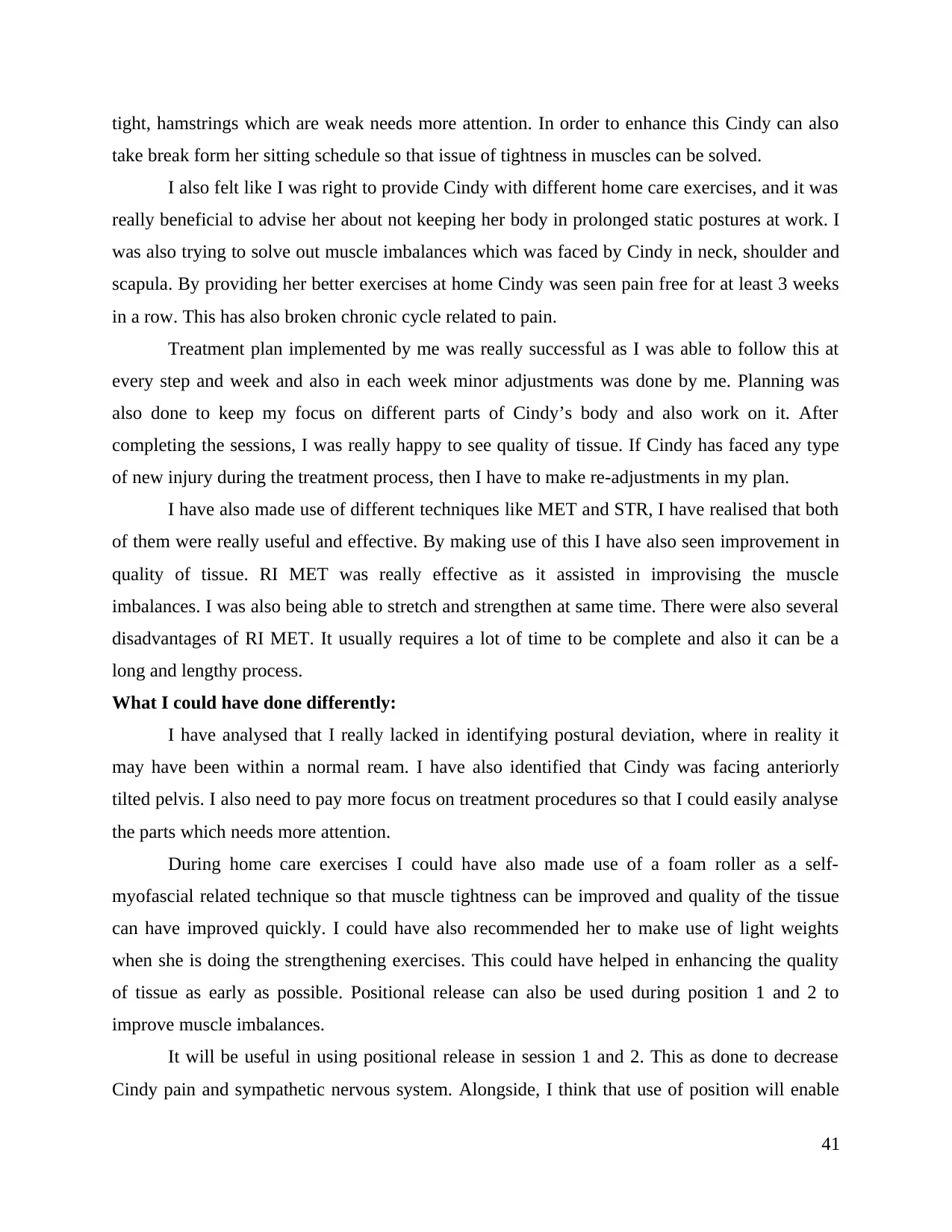
tight, hamstrings which are weak needs more attention. In order to enhance this Cindy can also
take break form her sitting schedule so that issue of tightness in muscles can be solved.
I also felt like I was right to provide Cindy with different home care exercises, and it was
really beneficial to advise her about not keeping her body in prolonged static postures at work. I
was also trying to solve out muscle imbalances which was faced by Cindy in neck, shoulder and
scapula. By providing her better exercises at home Cindy was seen pain free for at least 3 weeks
in a row. This has also broken chronic cycle related to pain.
Treatment plan implemented by me was really successful as I was able to follow this at
every step and week and also in each week minor adjustments was done by me. Planning was
also done to keep my focus on different parts of Cindy’s body and also work on it. After
completing the sessions, I was really happy to see quality of tissue. If Cindy has faced any type
of new injury during the treatment process, then I have to make re-adjustments in my plan.
I have also made use of different techniques like MET and STR, I have realised that both
of them were really useful and effective. By making use of this I have also seen improvement in
quality of tissue. RI MET was really effective as it assisted in improvising the muscle
imbalances. I was also being able to stretch and strengthen at same time. There were also several
disadvantages of RI MET. It usually requires a lot of time to be complete and also it can be a
long and lengthy process.
What I could have done differently:
I have analysed that I really lacked in identifying postural deviation, where in reality it
may have been within a normal ream. I have also identified that Cindy was facing anteriorly
tilted pelvis. I also need to pay more focus on treatment procedures so that I could easily analyse
the parts which needs more attention.
During home care exercises I could have also made use of a foam roller as a self-
myofascial related technique so that muscle tightness can be improved and quality of the tissue
can have improved quickly. I could have also recommended her to make use of light weights
when she is doing the strengthening exercises. This could have helped in enhancing the quality
of tissue as early as possible. Positional release can also be used during position 1 and 2 to
improve muscle imbalances.
It will be useful in using positional release in session 1 and 2. This as done to decrease
Cindy pain and sympathetic nervous system. Alongside, I think that use of position will enable
41
take break form her sitting schedule so that issue of tightness in muscles can be solved.
I also felt like I was right to provide Cindy with different home care exercises, and it was
really beneficial to advise her about not keeping her body in prolonged static postures at work. I
was also trying to solve out muscle imbalances which was faced by Cindy in neck, shoulder and
scapula. By providing her better exercises at home Cindy was seen pain free for at least 3 weeks
in a row. This has also broken chronic cycle related to pain.
Treatment plan implemented by me was really successful as I was able to follow this at
every step and week and also in each week minor adjustments was done by me. Planning was
also done to keep my focus on different parts of Cindy’s body and also work on it. After
completing the sessions, I was really happy to see quality of tissue. If Cindy has faced any type
of new injury during the treatment process, then I have to make re-adjustments in my plan.
I have also made use of different techniques like MET and STR, I have realised that both
of them were really useful and effective. By making use of this I have also seen improvement in
quality of tissue. RI MET was really effective as it assisted in improvising the muscle
imbalances. I was also being able to stretch and strengthen at same time. There were also several
disadvantages of RI MET. It usually requires a lot of time to be complete and also it can be a
long and lengthy process.
What I could have done differently:
I have analysed that I really lacked in identifying postural deviation, where in reality it
may have been within a normal ream. I have also identified that Cindy was facing anteriorly
tilted pelvis. I also need to pay more focus on treatment procedures so that I could easily analyse
the parts which needs more attention.
During home care exercises I could have also made use of a foam roller as a self-
myofascial related technique so that muscle tightness can be improved and quality of the tissue
can have improved quickly. I could have also recommended her to make use of light weights
when she is doing the strengthening exercises. This could have helped in enhancing the quality
of tissue as early as possible. Positional release can also be used during position 1 and 2 to
improve muscle imbalances.
It will be useful in using positional release in session 1 and 2. This as done to decrease
Cindy pain and sympathetic nervous system. Alongside, I think that use of position will enable
41
Paraphrase This Document
Need a fresh take? Get an instant paraphrase of this document with our AI Paraphraser
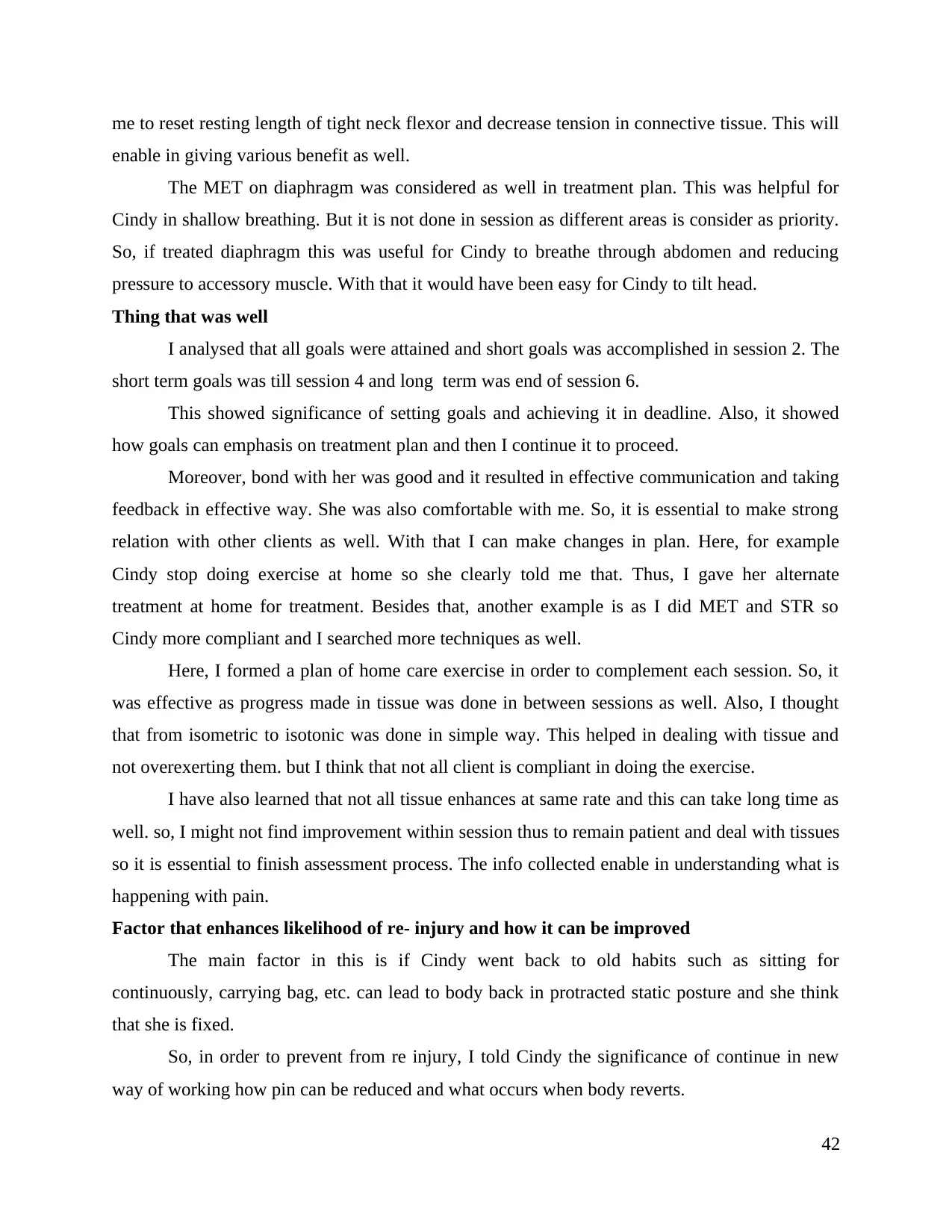
me to reset resting length of tight neck flexor and decrease tension in connective tissue. This will
enable in giving various benefit as well.
The MET on diaphragm was considered as well in treatment plan. This was helpful for
Cindy in shallow breathing. But it is not done in session as different areas is consider as priority.
So, if treated diaphragm this was useful for Cindy to breathe through abdomen and reducing
pressure to accessory muscle. With that it would have been easy for Cindy to tilt head.
Thing that was well
I analysed that all goals were attained and short goals was accomplished in session 2. The
short term goals was till session 4 and long term was end of session 6.
This showed significance of setting goals and achieving it in deadline. Also, it showed
how goals can emphasis on treatment plan and then I continue it to proceed.
Moreover, bond with her was good and it resulted in effective communication and taking
feedback in effective way. She was also comfortable with me. So, it is essential to make strong
relation with other clients as well. With that I can make changes in plan. Here, for example
Cindy stop doing exercise at home so she clearly told me that. Thus, I gave her alternate
treatment at home for treatment. Besides that, another example is as I did MET and STR so
Cindy more compliant and I searched more techniques as well.
Here, I formed a plan of home care exercise in order to complement each session. So, it
was effective as progress made in tissue was done in between sessions as well. Also, I thought
that from isometric to isotonic was done in simple way. This helped in dealing with tissue and
not overexerting them. but I think that not all client is compliant in doing the exercise.
I have also learned that not all tissue enhances at same rate and this can take long time as
well. so, I might not find improvement within session thus to remain patient and deal with tissues
so it is essential to finish assessment process. The info collected enable in understanding what is
happening with pain.
Factor that enhances likelihood of re- injury and how it can be improved
The main factor in this is if Cindy went back to old habits such as sitting for
continuously, carrying bag, etc. can lead to body back in protracted static posture and she think
that she is fixed.
So, in order to prevent from re injury, I told Cindy the significance of continue in new
way of working how pin can be reduced and what occurs when body reverts.
42
enable in giving various benefit as well.
The MET on diaphragm was considered as well in treatment plan. This was helpful for
Cindy in shallow breathing. But it is not done in session as different areas is consider as priority.
So, if treated diaphragm this was useful for Cindy to breathe through abdomen and reducing
pressure to accessory muscle. With that it would have been easy for Cindy to tilt head.
Thing that was well
I analysed that all goals were attained and short goals was accomplished in session 2. The
short term goals was till session 4 and long term was end of session 6.
This showed significance of setting goals and achieving it in deadline. Also, it showed
how goals can emphasis on treatment plan and then I continue it to proceed.
Moreover, bond with her was good and it resulted in effective communication and taking
feedback in effective way. She was also comfortable with me. So, it is essential to make strong
relation with other clients as well. With that I can make changes in plan. Here, for example
Cindy stop doing exercise at home so she clearly told me that. Thus, I gave her alternate
treatment at home for treatment. Besides that, another example is as I did MET and STR so
Cindy more compliant and I searched more techniques as well.
Here, I formed a plan of home care exercise in order to complement each session. So, it
was effective as progress made in tissue was done in between sessions as well. Also, I thought
that from isometric to isotonic was done in simple way. This helped in dealing with tissue and
not overexerting them. but I think that not all client is compliant in doing the exercise.
I have also learned that not all tissue enhances at same rate and this can take long time as
well. so, I might not find improvement within session thus to remain patient and deal with tissues
so it is essential to finish assessment process. The info collected enable in understanding what is
happening with pain.
Factor that enhances likelihood of re- injury and how it can be improved
The main factor in this is if Cindy went back to old habits such as sitting for
continuously, carrying bag, etc. can lead to body back in protracted static posture and she think
that she is fixed.
So, in order to prevent from re injury, I told Cindy the significance of continue in new
way of working how pin can be reduced and what occurs when body reverts.
42
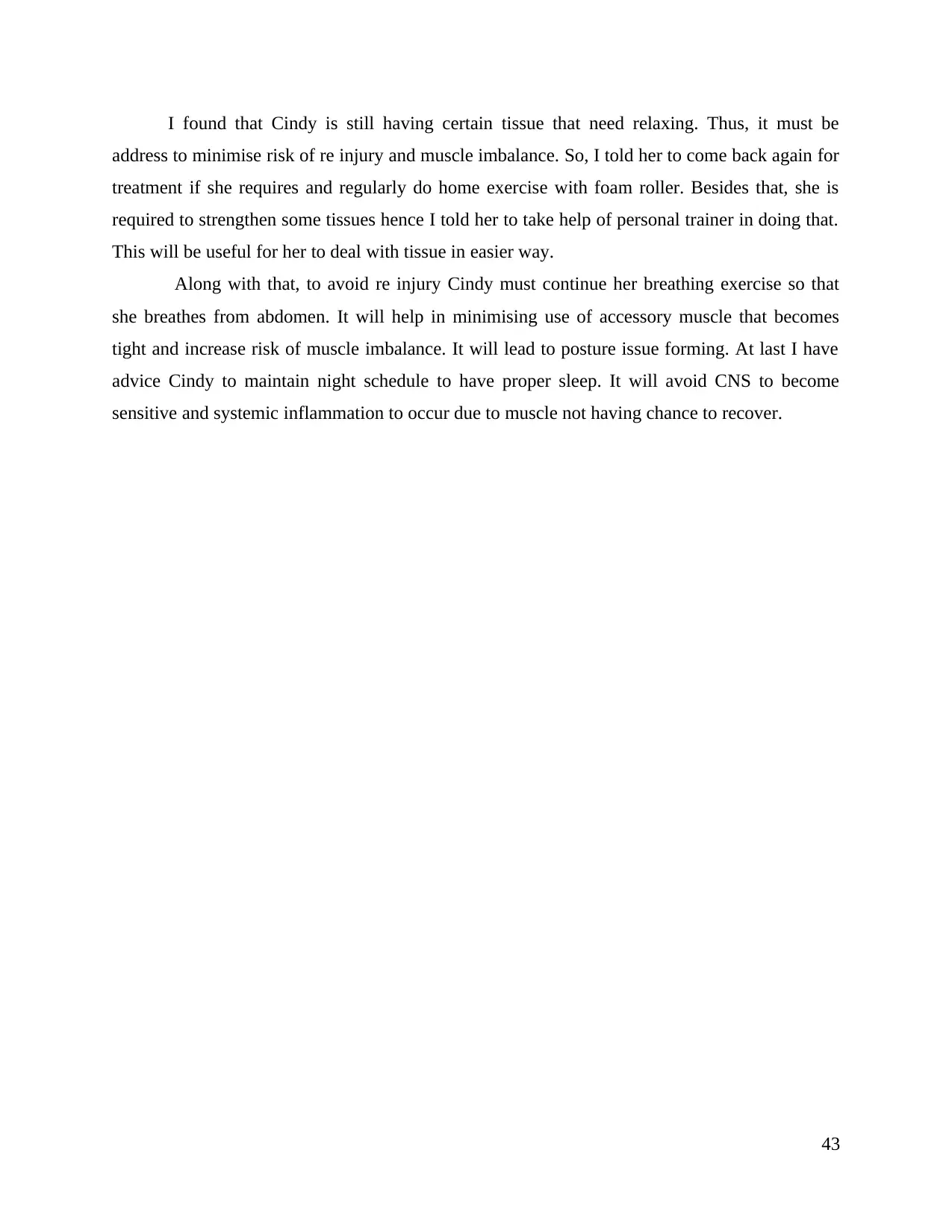
I found that Cindy is still having certain tissue that need relaxing. Thus, it must be
address to minimise risk of re injury and muscle imbalance. So, I told her to come back again for
treatment if she requires and regularly do home exercise with foam roller. Besides that, she is
required to strengthen some tissues hence I told her to take help of personal trainer in doing that.
This will be useful for her to deal with tissue in easier way.
Along with that, to avoid re injury Cindy must continue her breathing exercise so that
she breathes from abdomen. It will help in minimising use of accessory muscle that becomes
tight and increase risk of muscle imbalance. It will lead to posture issue forming. At last I have
advice Cindy to maintain night schedule to have proper sleep. It will avoid CNS to become
sensitive and systemic inflammation to occur due to muscle not having chance to recover.
43
address to minimise risk of re injury and muscle imbalance. So, I told her to come back again for
treatment if she requires and regularly do home exercise with foam roller. Besides that, she is
required to strengthen some tissues hence I told her to take help of personal trainer in doing that.
This will be useful for her to deal with tissue in easier way.
Along with that, to avoid re injury Cindy must continue her breathing exercise so that
she breathes from abdomen. It will help in minimising use of accessory muscle that becomes
tight and increase risk of muscle imbalance. It will lead to posture issue forming. At last I have
advice Cindy to maintain night schedule to have proper sleep. It will avoid CNS to become
sensitive and systemic inflammation to occur due to muscle not having chance to recover.
43
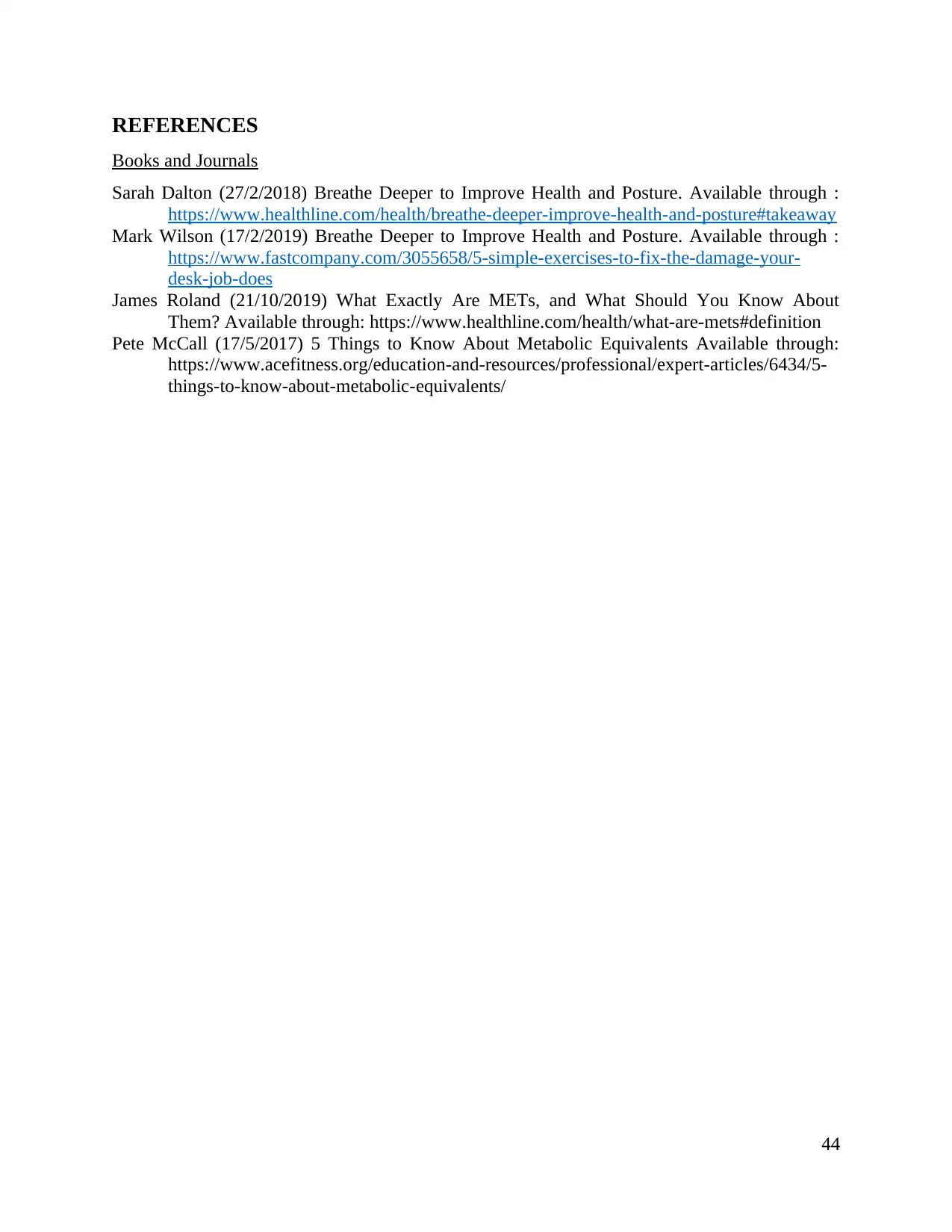
REFERENCES
Books and Journals
Sarah Dalton (27/2/2018) Breathe Deeper to Improve Health and Posture. Available through :
https://www.healthline.com/health/breathe-deeper-improve-health-and-posture#takeaway
Mark Wilson (17/2/2019) Breathe Deeper to Improve Health and Posture. Available through :
https://www.fastcompany.com/3055658/5-simple-exercises-to-fix-the-damage-your-
desk-job-does
James Roland (21/10/2019) What Exactly Are METs, and What Should You Know About
Them? Available through: https://www.healthline.com/health/what-are-mets#definition
Pete McCall (17/5/2017) 5 Things to Know About Metabolic Equivalents Available through:
https://www.acefitness.org/education-and-resources/professional/expert-articles/6434/5-
things-to-know-about-metabolic-equivalents/
44
Books and Journals
Sarah Dalton (27/2/2018) Breathe Deeper to Improve Health and Posture. Available through :
https://www.healthline.com/health/breathe-deeper-improve-health-and-posture#takeaway
Mark Wilson (17/2/2019) Breathe Deeper to Improve Health and Posture. Available through :
https://www.fastcompany.com/3055658/5-simple-exercises-to-fix-the-damage-your-
desk-job-does
James Roland (21/10/2019) What Exactly Are METs, and What Should You Know About
Them? Available through: https://www.healthline.com/health/what-are-mets#definition
Pete McCall (17/5/2017) 5 Things to Know About Metabolic Equivalents Available through:
https://www.acefitness.org/education-and-resources/professional/expert-articles/6434/5-
things-to-know-about-metabolic-equivalents/
44
Secure Best Marks with AI Grader
Need help grading? Try our AI Grader for instant feedback on your assignments.
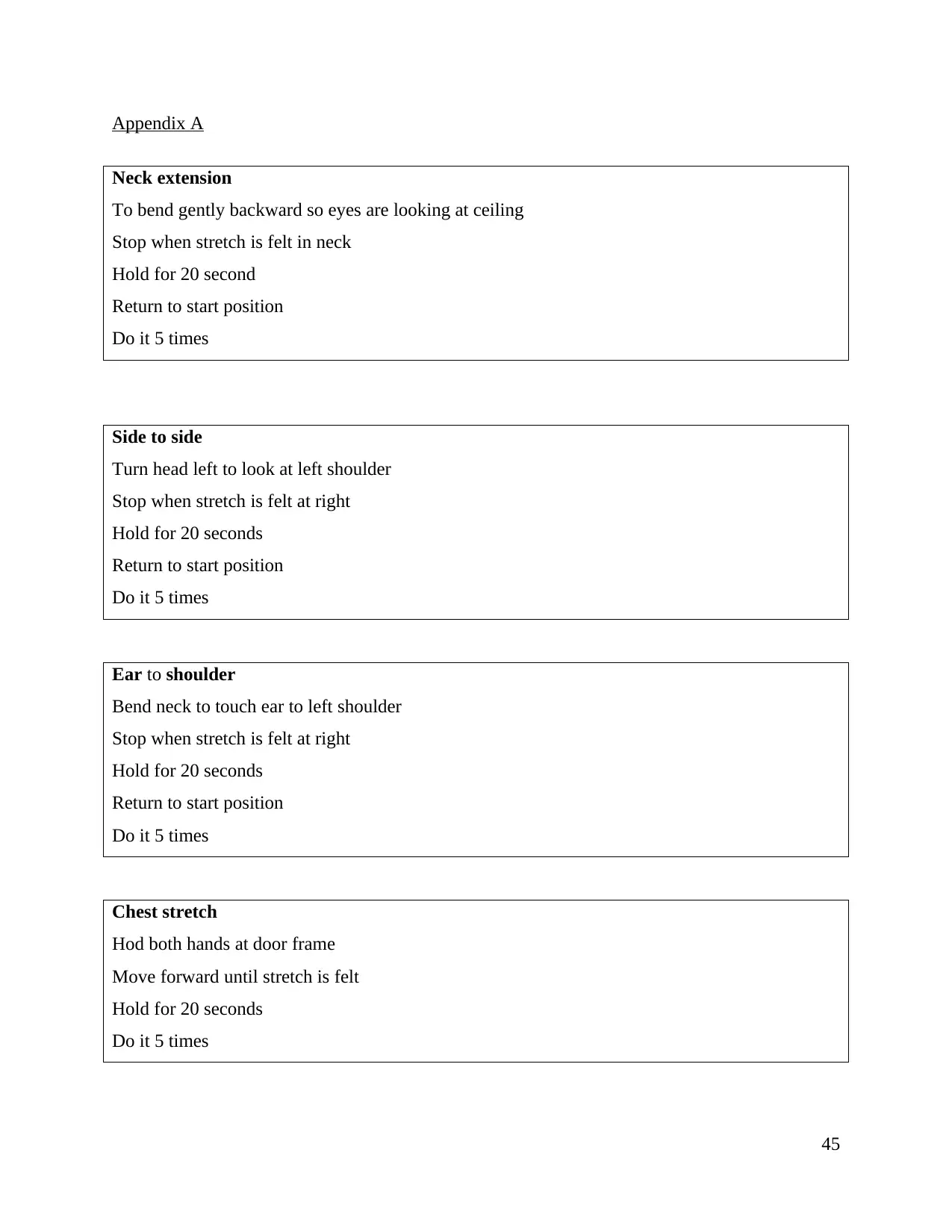
Appendix A
Neck extension
To bend gently backward so eyes are looking at ceiling
Stop when stretch is felt in neck
Hold for 20 second
Return to start position
Do it 5 times
Side to side
Turn head left to look at left shoulder
Stop when stretch is felt at right
Hold for 20 seconds
Return to start position
Do it 5 times
Ear to shoulder
Bend neck to touch ear to left shoulder
Stop when stretch is felt at right
Hold for 20 seconds
Return to start position
Do it 5 times
Chest stretch
Hod both hands at door frame
Move forward until stretch is felt
Hold for 20 seconds
Do it 5 times
45
Neck extension
To bend gently backward so eyes are looking at ceiling
Stop when stretch is felt in neck
Hold for 20 second
Return to start position
Do it 5 times
Side to side
Turn head left to look at left shoulder
Stop when stretch is felt at right
Hold for 20 seconds
Return to start position
Do it 5 times
Ear to shoulder
Bend neck to touch ear to left shoulder
Stop when stretch is felt at right
Hold for 20 seconds
Return to start position
Do it 5 times
Chest stretch
Hod both hands at door frame
Move forward until stretch is felt
Hold for 20 seconds
Do it 5 times
45
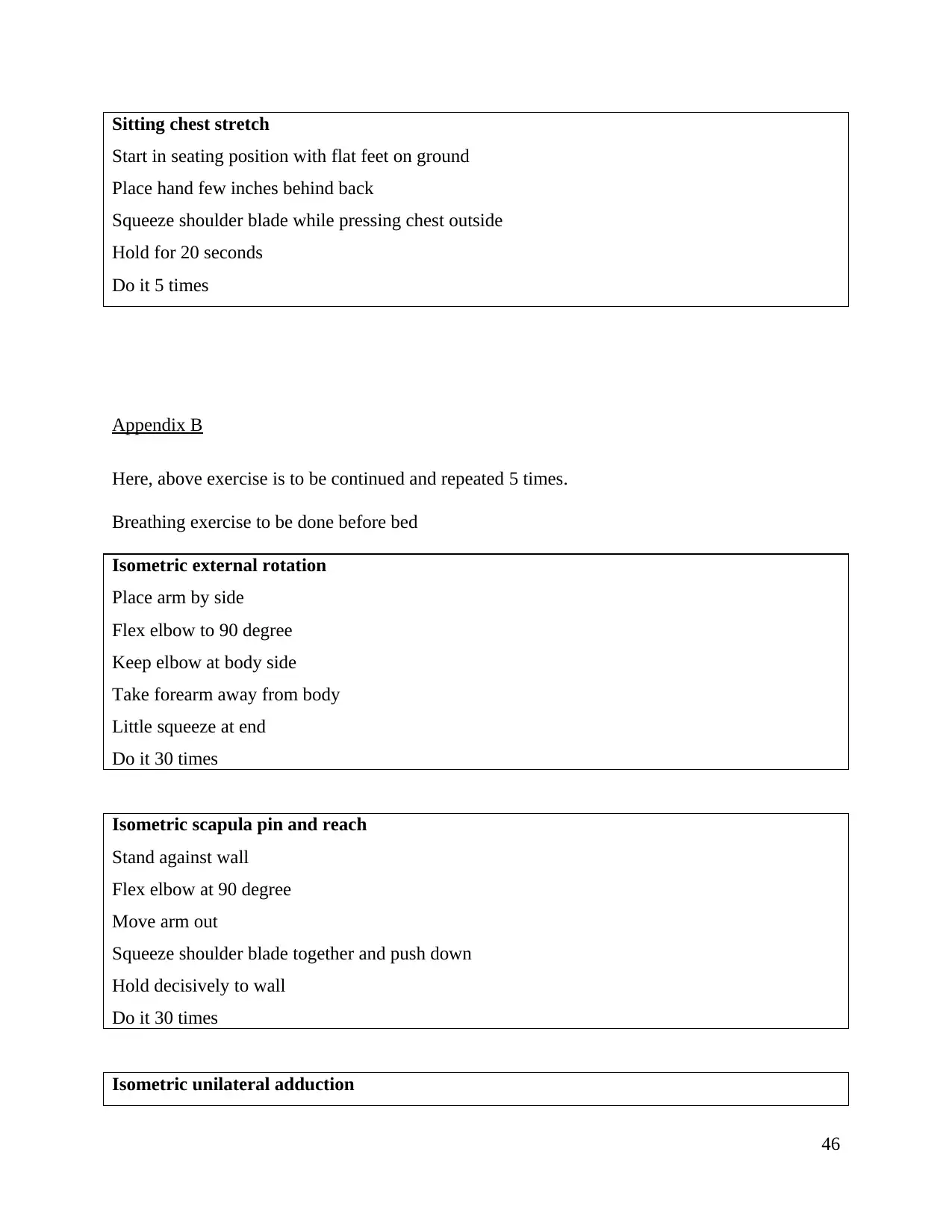
Sitting chest stretch
Start in seating position with flat feet on ground
Place hand few inches behind back
Squeeze shoulder blade while pressing chest outside
Hold for 20 seconds
Do it 5 times
Appendix B
Here, above exercise is to be continued and repeated 5 times.
Breathing exercise to be done before bed
Isometric external rotation
Place arm by side
Flex elbow to 90 degree
Keep elbow at body side
Take forearm away from body
Little squeeze at end
Do it 30 times
Isometric scapula pin and reach
Stand against wall
Flex elbow at 90 degree
Move arm out
Squeeze shoulder blade together and push down
Hold decisively to wall
Do it 30 times
Isometric unilateral adduction
46
Start in seating position with flat feet on ground
Place hand few inches behind back
Squeeze shoulder blade while pressing chest outside
Hold for 20 seconds
Do it 5 times
Appendix B
Here, above exercise is to be continued and repeated 5 times.
Breathing exercise to be done before bed
Isometric external rotation
Place arm by side
Flex elbow to 90 degree
Keep elbow at body side
Take forearm away from body
Little squeeze at end
Do it 30 times
Isometric scapula pin and reach
Stand against wall
Flex elbow at 90 degree
Move arm out
Squeeze shoulder blade together and push down
Hold decisively to wall
Do it 30 times
Isometric unilateral adduction
46
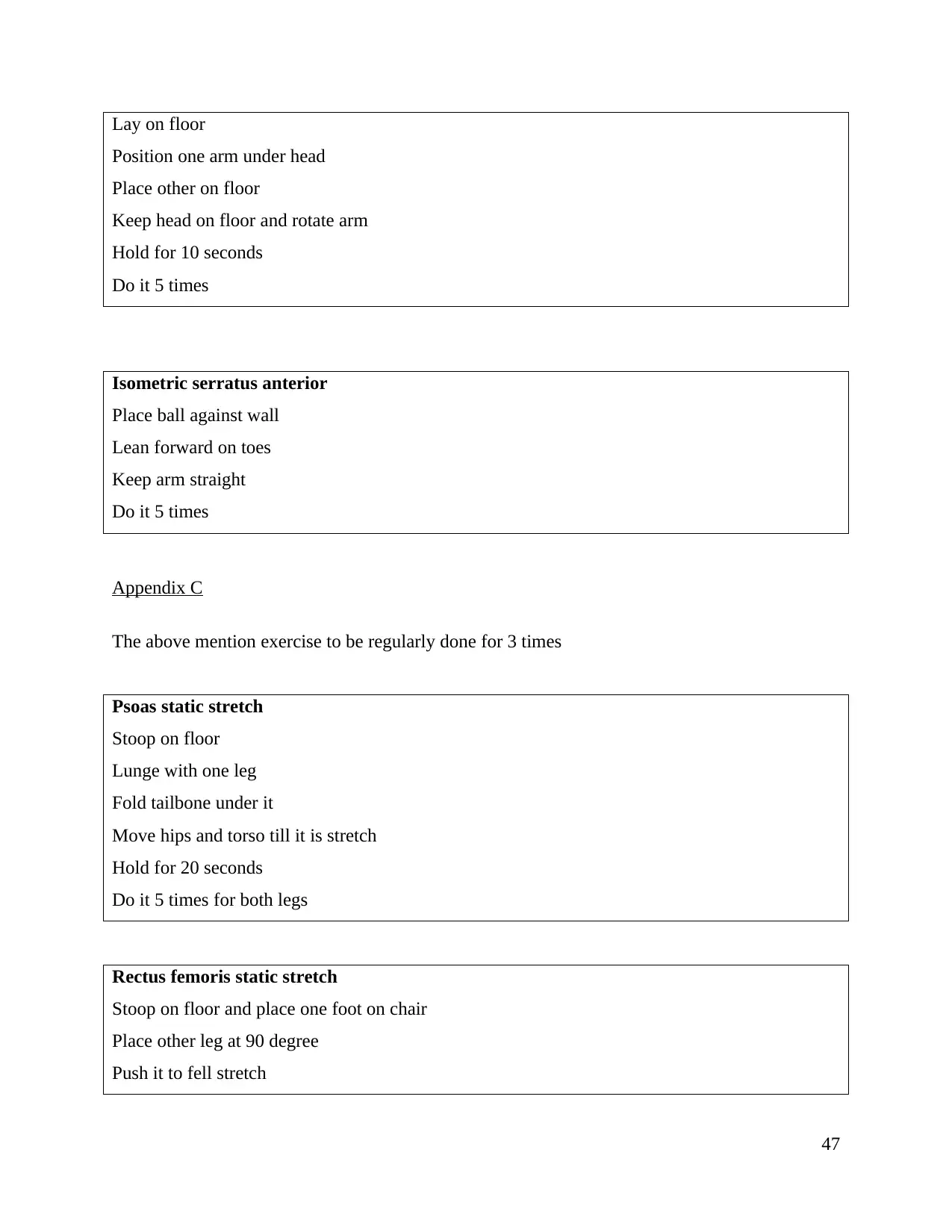
Lay on floor
Position one arm under head
Place other on floor
Keep head on floor and rotate arm
Hold for 10 seconds
Do it 5 times
Isometric serratus anterior
Place ball against wall
Lean forward on toes
Keep arm straight
Do it 5 times
Appendix C
The above mention exercise to be regularly done for 3 times
Psoas static stretch
Stoop on floor
Lunge with one leg
Fold tailbone under it
Move hips and torso till it is stretch
Hold for 20 seconds
Do it 5 times for both legs
Rectus femoris static stretch
Stoop on floor and place one foot on chair
Place other leg at 90 degree
Push it to fell stretch
47
Position one arm under head
Place other on floor
Keep head on floor and rotate arm
Hold for 10 seconds
Do it 5 times
Isometric serratus anterior
Place ball against wall
Lean forward on toes
Keep arm straight
Do it 5 times
Appendix C
The above mention exercise to be regularly done for 3 times
Psoas static stretch
Stoop on floor
Lunge with one leg
Fold tailbone under it
Move hips and torso till it is stretch
Hold for 20 seconds
Do it 5 times for both legs
Rectus femoris static stretch
Stoop on floor and place one foot on chair
Place other leg at 90 degree
Push it to fell stretch
47
Paraphrase This Document
Need a fresh take? Get an instant paraphrase of this document with our AI Paraphraser
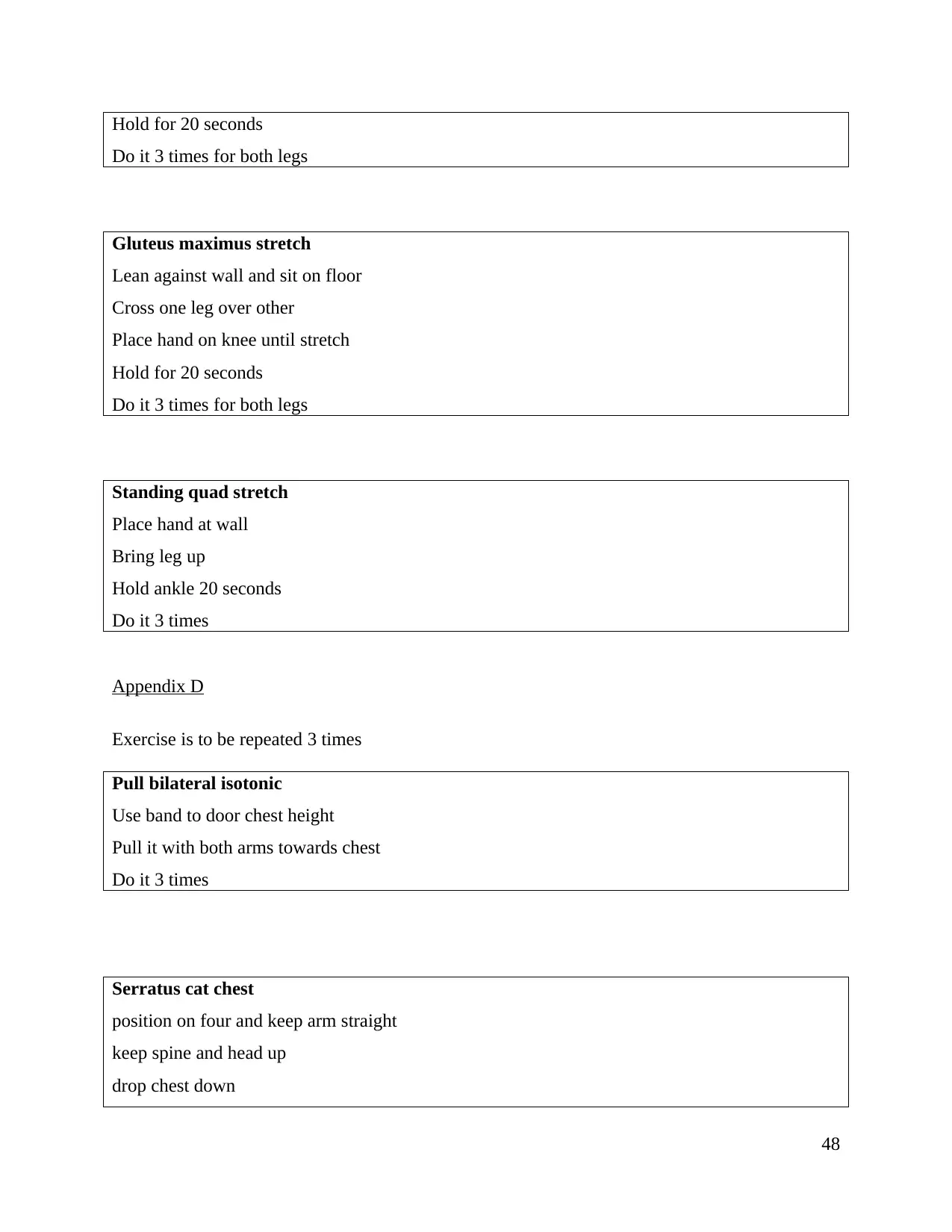
Hold for 20 seconds
Do it 3 times for both legs
Gluteus maximus stretch
Lean against wall and sit on floor
Cross one leg over other
Place hand on knee until stretch
Hold for 20 seconds
Do it 3 times for both legs
Standing quad stretch
Place hand at wall
Bring leg up
Hold ankle 20 seconds
Do it 3 times
Appendix D
Exercise is to be repeated 3 times
Pull bilateral isotonic
Use band to door chest height
Pull it with both arms towards chest
Do it 3 times
Serratus cat chest
position on four and keep arm straight
keep spine and head up
drop chest down
48
Do it 3 times for both legs
Gluteus maximus stretch
Lean against wall and sit on floor
Cross one leg over other
Place hand on knee until stretch
Hold for 20 seconds
Do it 3 times for both legs
Standing quad stretch
Place hand at wall
Bring leg up
Hold ankle 20 seconds
Do it 3 times
Appendix D
Exercise is to be repeated 3 times
Pull bilateral isotonic
Use band to door chest height
Pull it with both arms towards chest
Do it 3 times
Serratus cat chest
position on four and keep arm straight
keep spine and head up
drop chest down
48
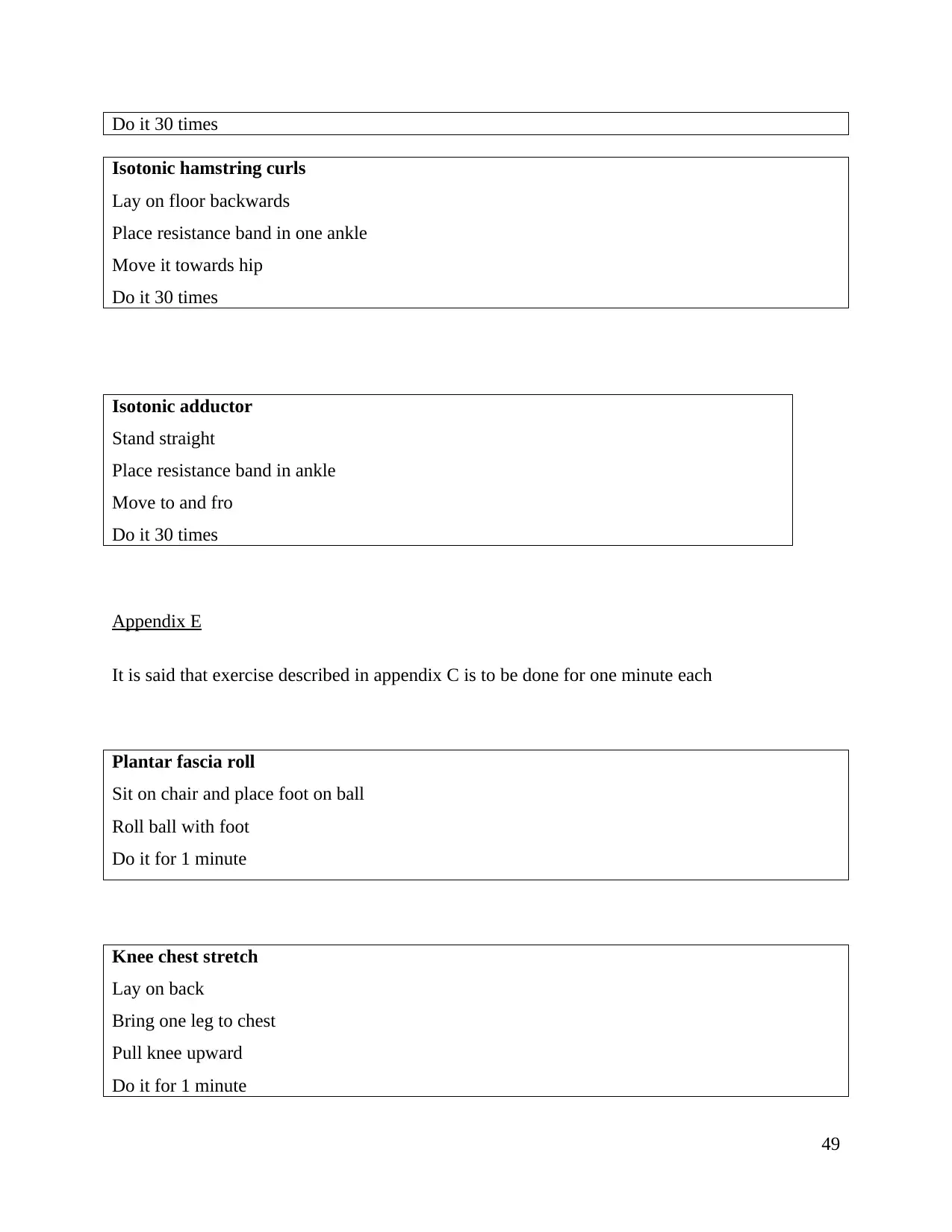
Do it 30 times
Isotonic hamstring curls
Lay on floor backwards
Place resistance band in one ankle
Move it towards hip
Do it 30 times
Isotonic adductor
Stand straight
Place resistance band in ankle
Move to and fro
Do it 30 times
Appendix E
It is said that exercise described in appendix C is to be done for one minute each
Plantar fascia roll
Sit on chair and place foot on ball
Roll ball with foot
Do it for 1 minute
Knee chest stretch
Lay on back
Bring one leg to chest
Pull knee upward
Do it for 1 minute
49
Isotonic hamstring curls
Lay on floor backwards
Place resistance band in one ankle
Move it towards hip
Do it 30 times
Isotonic adductor
Stand straight
Place resistance band in ankle
Move to and fro
Do it 30 times
Appendix E
It is said that exercise described in appendix C is to be done for one minute each
Plantar fascia roll
Sit on chair and place foot on ball
Roll ball with foot
Do it for 1 minute
Knee chest stretch
Lay on back
Bring one leg to chest
Pull knee upward
Do it for 1 minute
49

Soles stretch
Stand with chair
Take small step with one leg backward
Press heel on floor and bend it
Do it for 1 minute
Gastrocnemius stretch
Stand with chair
Take large step with one leg backward
Press heel on floor and bend it
Do it for 1 minute
50
Stand with chair
Take small step with one leg backward
Press heel on floor and bend it
Do it for 1 minute
Gastrocnemius stretch
Stand with chair
Take large step with one leg backward
Press heel on floor and bend it
Do it for 1 minute
50
1 out of 52
Your All-in-One AI-Powered Toolkit for Academic Success.
+13062052269
info@desklib.com
Available 24*7 on WhatsApp / Email
![[object Object]](/_next/static/media/star-bottom.7253800d.svg)
Unlock your academic potential
© 2024 | Zucol Services PVT LTD | All rights reserved.


